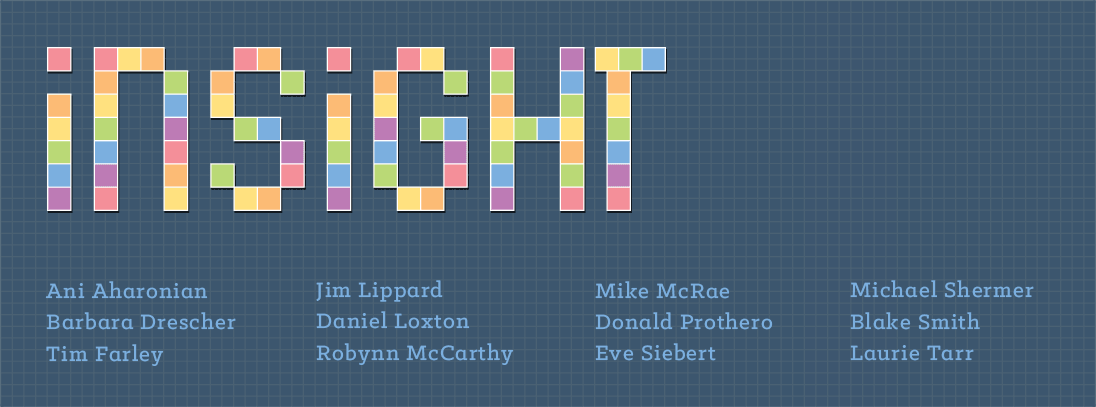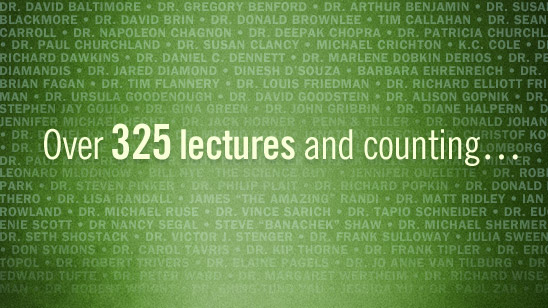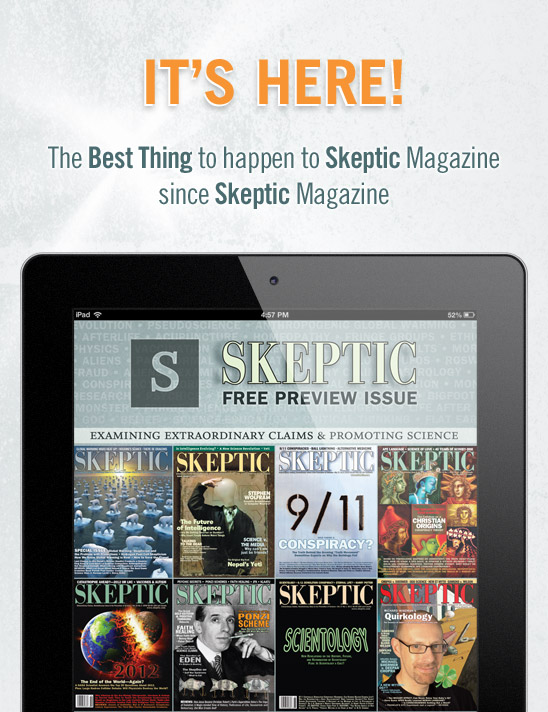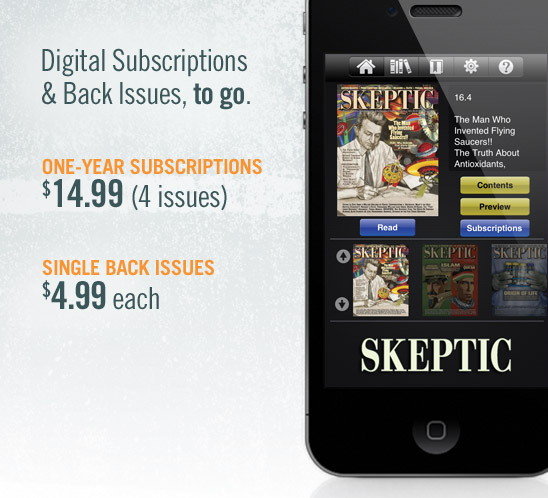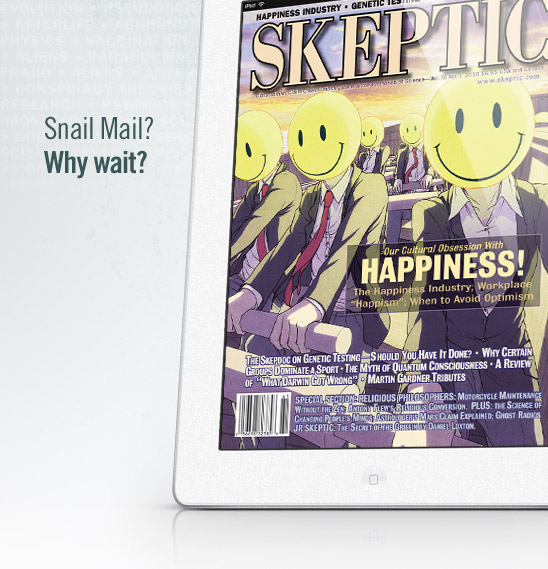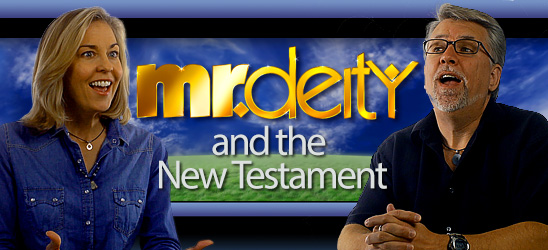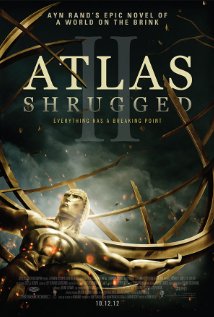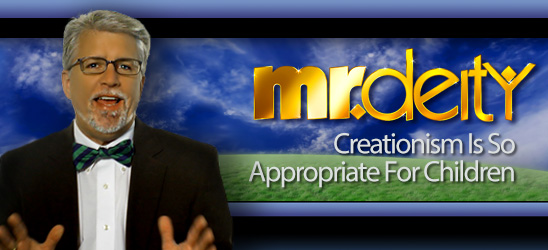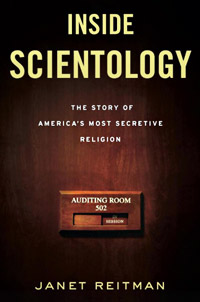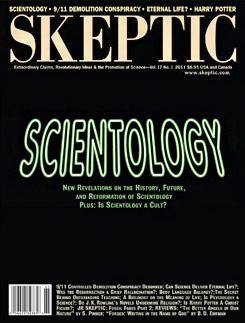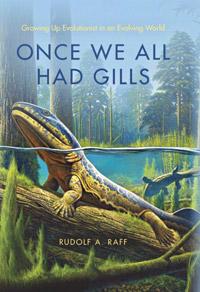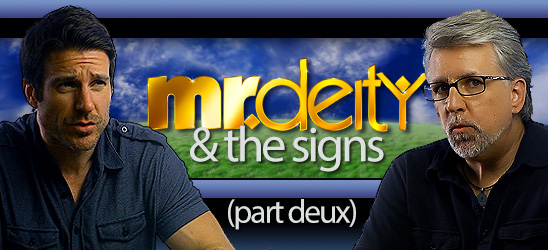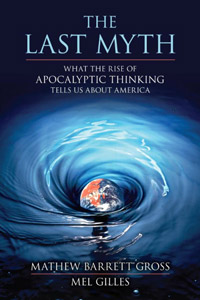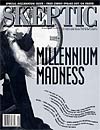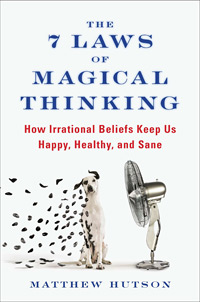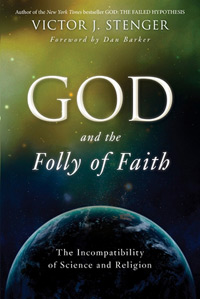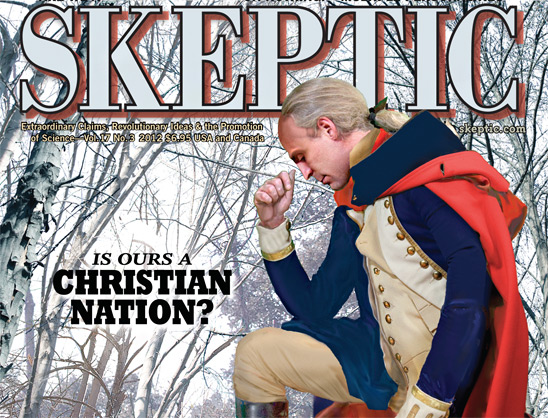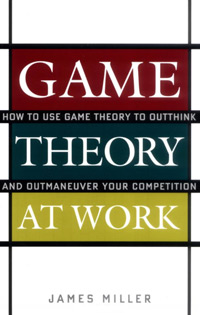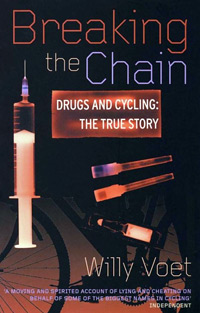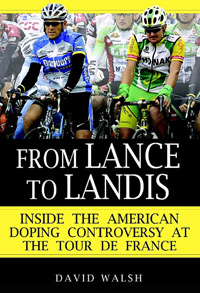12-11-21
Now through Sunday
25% off everything at Shop Skeptic
It’s our best sale of the year: the Skeptic 5-day Sale (November 21 through November 25, 2012, PST). Shop now and save 25% off everything at Shop Skeptic, including: books, DVDs, print magazine subscriptions, hoodies, t-shirts (and other cool swag), as well as back issues of Skeptic magazine.
All orders placed at shop.skeptic.com between Wednesday, Nov. 21 through Sunday, Nov. 25 (PST) will be discounted by 25% at checkout. Sale prices shown below include the 25% discount mentioned above. Digital subscriptions & digital back issues are not included in this sale; they are sold within the Skeptic Magazine App, available through Apple, Google & Amazon.
Order in time for Christmas delivery
Order by December 10 for shipments outside the US.
Order by December 19 for shipments inside the US
See our Holiday Shipping page for complete details.
T-Shirts, Hoodies
& Other Swag

Skeptic Hoodies
by American Apparel $46.00
A fitted, sporty unisex zip hoodie in luxurious Flex Fleece fabric: a unique 50/50 cotton/poly blend that offers warmth without being overly bulky. Pre-washed for minimal shrinkage. Contrasting white finished polyester drawcord, metal zipper. Kangaroo pocket. If you are not familiar with how American Apparel fits, refer to the sizing chart below before placing your order. If you don’t like a snug fit, we suggest ordering a size larger than you would normally order from other manufacturers.
ORDER hoodies

Skeptic T-Shirts
by American Apparel $18.00
Made of 100% fine jersey knit cotton, ring-spun and combed for superior softness and strength. Our unisex fine jersey short sleeve T-shirts, by American Apparel, are the softest, smoothest, best-looking T-shirts available anywhere. If you are not familiar with how American Apparel fits, refer to the sizing chart below before placing your order. If you don’t like a snug fit, we suggest ordering a size larger than you would normally order from other manufacturers.
ORDER T-shirts

Skeptic Lapel Pin $10.00
This tie-tack style metal pin has gold-colored SKEPTIC lettering with a contrasting black background. It’s a great size for a lapel or tie — about 25mm × 6mm (1″ × .25″). It comes in a classy little plastic box suitable for gift-giving. (Note: image not shown actual size.)
ORDER the lapel pin

Skeptic Bumper Sticker
1 for $4 or 3 for $8
Designed to withstand the elements, these self-adhesive bumper stickers, made from the highest quality weather resistant and laminated vinyl, are ideal for use on vehicles, windows, refrigerators, school lockers and binders, or just about anywhere you want to stick them. DIMENSIONS: 11.5″ wide × 3″ high. Want something smaller? Check out our 5″ × 2.75″ sticker. ORDER the bumper sticker
Print Subscriptions
& Back Issues

Skeptic Magazine Subscriptions
starting at $30.00
A subscription to Skeptic magazine, the definitive skeptical journal, makes a perfect gift that lasts all year. Promoting science and critical thinking, our articles explore and inform. Buy it. Share it. Help us make the world a more rational place by defending the role of science in society!
ORDER a print subscription
ORDER a gift subscription
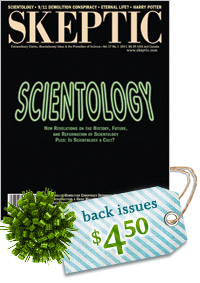
Skeptic Magazine
Back Issues $6.00
Don’t miss this opportunity to complete your collection of Skeptic magazine by getting the back issues you’re missing in your library. Volume 17, number 1 (our Scientology issue) is one of our most popular issues. Order a copy for a friend and introduce them to skepticism. Bound with every issue of Skeptic magazine is Junior Skeptic: the skeptical movement’s most sustained and substantial educational outreach project for children. ORDER back issues
Must-Have Skeptical
Reference Guides

How to Debate a Creationist
by Michael Shermer $5.00
This 28-page booklet is perfect for anyone who wants to know how to converse with a creationist. It contains 25 creationist arguments and 25 evolutionist answers (some philosophic and some scientific); describes what the theory of evolution is and isn’t and explains why creationism is not science; provides an in-depth understanding of Intelligent Design, its pitfalls and logical fallacies, and much more.
ORDER the booklet

The Baloney Detection Kit
by Michael Shermer & Pat Linse $5.00
This 16-page booklet, designed to hone your critical thinking skills, includes suggestions on what questions to ask, what traps to avoid, specific examples of how the scientific method is used to test pseudoscience and paranormal claims, and a how-to guide for developing a class in critical thinking.
ORDER the booklet
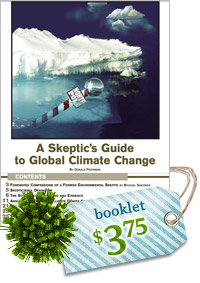
A Skeptic’s Guide to
Global Climate Change
by Donal Prothero $5.00
Distinguish climate change skepticism from climate change denialism; get 25 answers to classic climate denier arguments; examine a summary of the scientific evidence and climate data and discover what’s behind the debate on climate change; find out why scientists think climate is changing and how we know global warming is real and human caused. This booklet has 28 pages at 8.5 × 11 inches.
ORDER the booklet
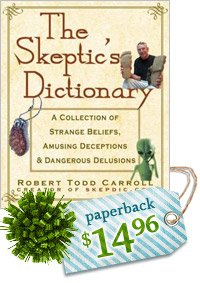
The Skeptic’s Dictionary
by Robert Carroll $19.95
The definitive short-answer debunking of nearly every thing skeptical with nearly 400 definitions, arguments, and essays on topics ranging from acupuncture to zombies. Detailed information on all things supernatural, occult, paranormal, and pseudoscientific, including: alternative medicine; cryptozoology; extraterrestrials and UFOs; frauds and hoaxes; junk science; logic and perception, and more. An invaluable reference.
ORDER the dictionary
On Evolution

Evolution: How We and All Living Things Came to Be
by Daniel Loxton $18.95
Hailed as a “tour-de-force of science writing,” Evolution was crowned in 2010 with Canada’s largest literary prize for children’s science books: The Lane Anderson Award for Best Science Book for Young Readers. Combining lavish illustrations, breezy prose, and deep science, this primer for ages 8–13 has been applauded by expert reviewers including the National Science Teachers Association, the American Association for the Advancement of Science, and the National Center for Science Education.
ORDER the hardback

Evolution: What the Fossils Say & Why it Matters
by Donald Prothero $30.00
This book, which has received rave reviews, is one of the best books explaining evolution and new discoveries of the incredibly rich fossil record; plus a no holds barred critique of the claims of creationism and Intelligent Design. Over 200 illustrations. Michael Shermer says of the book: “Prothero’s visual presentation of the fossil and genetic evidence for evolution is so unmistakably powerful that I venture to say that no one could read this book and still deny the reality of evolution.”
ORDER the hardback
ORDER the lecture on DVD
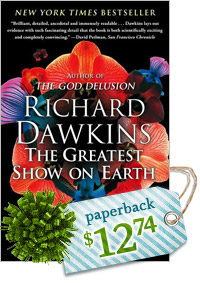
The Greatest Show on Earth
by Richard Dawkins $16.99
This New York Times bestseller is a fierce counterattack against proponents of “Intelligent Design.” Educators are being asked to “teach the controversy” behind evolutionary theory. There is no controversy. Dawkins sifts through rich layers of scientific evidence to make the airtight case that “we find ourselves perched on one tiny twig in the midst of a blossoming and flourishing tree of life and it is no accident, but the direct consequence of evolution by non-random selection.”
ORDER the paperback
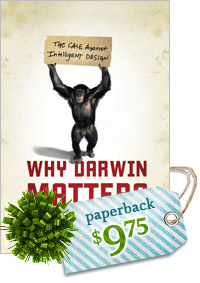
Why Darwin Matters: The Case Against Intelligent Design
by Michael Shermer $13.00
Evolution happened, and the theory describing it is one of the most well founded in all of science. Then why do half of all Americans reject it? Historian of science, Michael Shermer, defuses these people’s fears about evolution by examining what it really is, how we know it happened, and how to test it. He examines the difference between supernatural (creationism) v. natural (evolution) design and how evolution can explain complex design.
ORDER the paperback
ORDER the abridged audio CD
Critical Thinking Classics
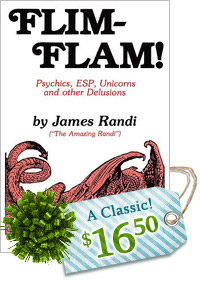
Flim-Flam!
by James Randi $22.00
Flim-Flam, a classic masterpiece—and the bible of the skeptical movement—is Randi’s account of dozens of his personal investigations into the paranormal that no skeptical bookshelf should be without. With an Introduction by Isaac Asimov, this book includes Randi’s investigations of the Bermuda Triangle, alternative medicine, Transcendental Meditation, ESP, PSI, and how Sir Arthur Conan Doyle got taken by fake fairy photographs (despite Houdini’s debunking of them).
ORDER the paperback
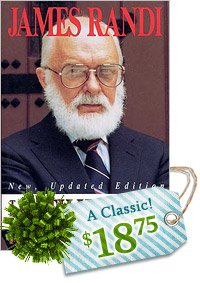
The Faith Healers
by James Randi $25.00
This book is Randi’s greatest investigation and exposé of Peter Popoff, W.V. Grant, Pat Robertson, and Oral Roberts, as seen on the Tonight Show. Steve Martin’s Leap of Faith was based on this book and Randi won a MacArthur “Genius Award” for this work. The Toronto Sun calls it, “A fascinating look at a world of misplaced faith and blind trust that seems more appropriate to the Dark Ages than to the end of the 20th century.”
ORDER the paperback

The New Age: Notes of a Fringe Watcher
by Martin Gardner $26.00
This book is a classic of skeptical literature filled with thirty-three diverse chapters: a bountiful offering of the delightful drollery and horse sense that has made Martin Gardner the undisputed dean of the critics of pseudoscience. It is also a quick way to get up to speed on many topics.
ORDER the paperback
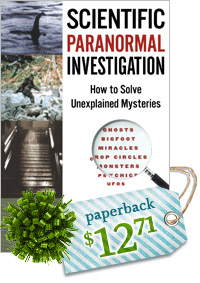
Scientific Paranormal Investigation
by Benjamin Radford $16.95
“An excellent primer on how any reasonably observant person interested in looking into paranormal claims can do so without having to invent the art from scratch. The real paydirt here is Ben’s own detailed accounts of events he’s personally looked into… Ben Radford knows his calling. Read, consider, and learn. It’s all here.” —James Randi
ORDER the paperback
Great for Kids!

The Magic Detectives
by Joe Nickell $15.00
Encourage scientific awareness in children and have them see it as challenging, interesting, and just plain fun! Nickell presents 30 brief mystery stories with clues embedded in each story. At the end of each mystery, the reader can turn the book upside down and see if they have come to the same conclusion reached by the professional ‘magic detectives.’ Included are examinations of the ‘mummy’s curse’, Bigfoot, haunted stairways, walking on fire, ancient astronauts, the Reverend Peter Popoff, the Amityville Horror, the Loch Ness monster, poltergeists, and more.
ORDER the paperback

Maybe Yes, Maybe No
by Dan Barker $16.00
A good book to inspire discussion with your children about religious belief systems. This book encourages children to ask questions and suggests ways to apply the scientific method to reach conclusions. In addition to religion, the book provides examples from other topics such as UFOs, prophesy, out of body experience, dowsing, levitation, astrology, horoscopes, ESP, telepathy, and telekinesis. Simple straightforward text in a cartoon style. Kids learn how to listen and ask questions; how to seek a simple explanation; what tools and rules a scientist uses to check things out. For ages 7–10 years.
ORDER the paperback

Sasquatches From
Outer Space
by Tim Yule $15.00
A nice beginning book written in a chatty cheerful style to develop future critical thinkers. Covers astrology, Bigfoot, the Bermuda triangle, ESP, corp circles, the Loch Ness Monster, Vampires, and UFOs and aliens. Teaches basic critical thinking skills that will help young people who are bombarded by fantastic claims to distinguish between fact and fiction. Plenty of common sense examples of how to examine paranormal mysteries the way a scientist would. A “Try This” section encourages hands on thinking skills. For ages 10–15 years.
ORDER the paperback

Test Your Science IQ
by Charles Cazeau $20.00
Using a question-and-answer format that is fun to read and easy to understand, Dr Charles Cazeau takes you through more than 450 of the most intriguing science questions, from the profound to the amusingly trivial, overing both science and pseudoscience. Clear, well written, yet sophisticated enough for adults. Very strong on why science is important. The perfect book for the junior skeptic in your family which will teach how science works and why it is so important to understanding the world. Fascinating and fun. For ages 12 to adult.
ORDER the paperback
By Michael Shermer

The Believing Brain
by Michael Shermer $15.99
In this, his magnum opus, Dr. Michael Shermer presents his comprehensive theory on how beliefs are born, formed, nourished, reinforced, challenged, changed, and extinguished. We form our beliefs for a variety of subjective, personal, emotional, and psychological reasons in the context of environments created by family, friends, colleagues, culture, and society at large; after forming our beliefs we then defend, justify, and rationalize them with a host of intellectual reasons, cogent arguments, and rational explanations. Beliefs come first, explanations for beliefs follow.
ORDER the paperback
ORDER the harback
ORDER the unabridged audio CD

Science Friction
by Michael Shermer $10.00
Shermer pretends to be a psychic for a day…and fools everyone; as a psychologist and bicycle racer, he reveals the science behind sports psychology; as a historian and evolutionary theorist he considers what was truly responsible for the mutiny on the Bounty; and as a son, he explores the possibilities of alternative and experimental medicine for his cancer-ravaged mother. And as a skeptic, he turns the skeptical lens onto science itself. In each of the essays, he explores the very personal barriers and biases that plague and propel science, especially when scientists push against the unknown.
ORDER the hardback
ORDER the unabridged audio CD
On Religion & Society

The Bible Against Itself
by Randel Helms $7.98
Before the Bible was the Bible it was a lot of little books written by many writers with many different viewpoints. With depth and clarity Dr. Helms shows that, throughout the history of their formation, the Jewish and Christian scriptures developed as the by-products of ongoing theological debates. Far from expressing the unity of thought and doctrinal accord that would reflect divine inspiration, the scriptures represent a series of furious and unrelenting disputes between authors supporting often bitterly divided dogmas.
ORDER the paperback
ORDER the hardcover
ORDER the lecture on DVD
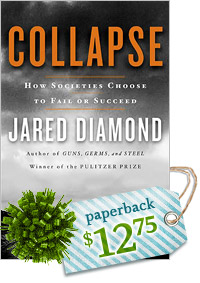
Collapse: How Societies Choose To Fail Or Succeed
by Jared Diamond $17.00
What caused some of the great civilizations of the past to collapse into ruin, and what can we learn from their fates? The Pulitzer Prize-winner traces the fundamental patterns of social catastrophe and physical collapse to a combination of environmental degradation, resource depletion, draughts, political upheaval, economic disaster, and war. Diamond employs the comparison method to test his hypotheses about the history of civilization, comparing different collapses at different times in different places around the world.
ORDER the paperback
ORDER the lecture on DVD

The Particle at the End of the Universe:
How the Hunt for the Higgs Boson Leads Us
to the Edge of a New World
How the Hunt for the Higgs Boson Leads Us
to the Edge of a New World
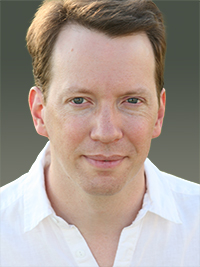
Scientists have just announced an historic discovery on a par with the splitting of the atom: the Higgs boson. The key to understanding why mass exists has been found. In The Particle at the End of the Universe, Caltech physicist and acclaimed writer Sean Carroll takes you behind the scenes of the Large Hadron Collider at CERN to meet the scientists and explain this landmark event. What is so special about the Higgs boson? We didn’t really know for sure if anything at the subatomic level had any mass at all until we found it. The fact is, while we have now essentially solved the mass puzzle, there are things we didn’t predict and possibilities we haven’t yet dreamed. A doorway is opening into the mind boggling, somewhat frightening world of dark matter. We only discovered the electron just over a hundred years ago and considering where that took us—from nuclear energy to quantum computing—the inventions that will result from the Higgs discovery will be world-changing.
TAGS: Higgs boson, physics, universe12-11-14

Celebrating 20 Years
of the Skeptics Society & Skeptic magazine
THANK YOU for over two decades of your continued support. We couldn’t have done it without you! We’re geared up and energized for the next 20 years and we hope you will support us in our mission of promoting science and skepticism.
We started Skeptic magazine in the garage of Michael Shermer’s home with volume 1, number 1, a tribute to Isaac Asimov. By volume 1, number 3, we were in a few isolated bookstores. By volume 2, we were being carried by hundreds of bookstores, and by volume 4, it was available in thousands of retail outlets.
We’ve reached over 100 million people,
and there’s more work to be done
We estimate that your support has helped our Executive Director, Dr. Michael Shermer, reach approximately 100 million people in 20 years of skeptical outreach through the 50,000 readers of Skeptic magazine each quarter, the nearly one million readers of his Scientific American column each month, the several million readers of his dozen books, the tens of thousands of people who follow our social media sources and YouTube channel, the tens of millions of viewers of his countless appearances on talk shows and television series such as The Colbert Report, 20/20, Dateline, Charlie Rose, Larry King Live, Oprah, Tom Snyder, Donahue, Lezza, Unsolved Mysteries, and other shows as a skeptic of weird and extraordinary claims, as well as interviews in countless documentaries aired on PBS, A&E, Discovery, The History Channel, The Science Channel, The Learning Channel, and on the 13-hour Family Channel television series, Exploring the Unknown, for which Dr. Shermer co-hosted. In addition there have been hundreds of opinion editorials in major newspapers, science reviews in national publications, university and college lectures and countless radio interviews, and millions of visitors and page views on skeptic.com.
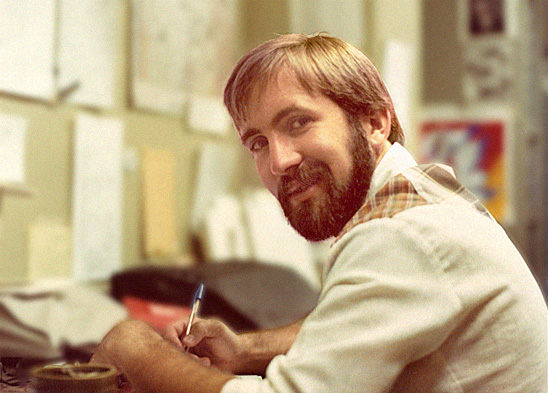
Michael Shermer, in grad school in 1977, recalled Carl Sagan’s words of wisdom about the importance of science education. Those words were the candle in the dark that guided him for 15 years until he formed the Skeptics Society in 1992.
A Note from Michael Shermer
Executive Director of Your Skeptics Society
I cannot believe that it’s been 20 years since we founded the Skeptics Society and Skeptic magazine in 1992. It seems like only yesterday I was teaching at Occidental College and gearing up for a comfortable life in academia. Then I remembered something Carl Sagan said at a lecture I attended: “We live in a society exquisitely dependent on science and technology, in which hardly anyone knows anything about science and technology.”
It was a clarion call to me to forego a life of comfortable security as a college professor and venture into the business of being a public intellectual and expand the size of my classroom to the world. If you want to change the world you have to reach a lot of people—not a few hundred students, but a few hundred million people. I recalled that years before, when I was a graduate student in psychology when Uri Geller was all the rage, thinking maybe there was something to psychic power and ESP. But then I saw James “The Amazing” Randi on Johnny Carson’s Tonight Show, duplicating all of Geller’s feats with simple sleight of hand. I suddenly realized that it’s not enough to be trained in science; you have to understand skepticism as it is practiced by professionals like Randi, who serve as a consumer advocate for rational thinking.
The best way to reach the wider public is through the popular media—magazine publishing (Skeptic magazine and my monthly column in Scientific American), books (from Why People Believe Weird Things to The Believing Brain—I’ve written 12 now), newspapers (I write regular opinion editorials and book reviews for the Los Angeles Times, Wall Street Journal, Science, Nature, and many others), radio and television interviews and talk shows, YouTube videos, blogging, Facebook, Twitter, and others.
If you have appreciated 20 years of the Skeptics Society and would like to see us continue for another 20 years, please make a tax-deductible donation to your Skeptics Society now. We have some special donation premiums that you can enjoy along with the knowledge that you have helped make the world a more rational place to live.
Our science lectures have gone global
The Skeptics Society’s Distinguished Science Lecture Series at Caltech features top science writers lecturing on controversial and cutting edge science. We have now gone global by live streaming our lectures to anyone, anywhere in the world with an Internet connection. Now, instead of hundreds of people attending events, potentially millions can watch our lectures broadcast live from Caltech, thereby expanding the international reach of skepticism.
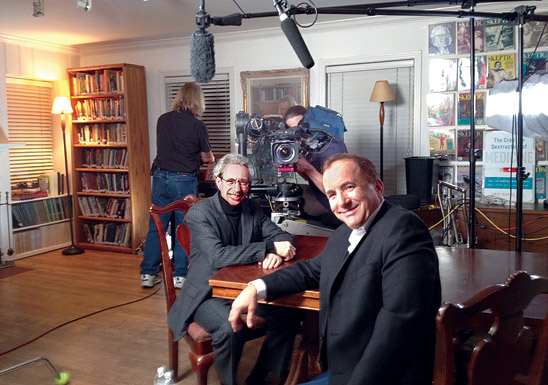
If you’ve ever seen our Executive Director Michael Shermer being interviewed on television, chances are you’ve seen the Skeptics Society’s office and library.
The media now asks for the
skeptical viewpoint by name
At the time we founded the Skeptics Society there was a great deal of debate about the wisdom of using the term “skeptic.” Was it too negative? Did it sound to much like “cynic”? There are basically three options when choosing a name: you can find something that means exactly and only what you want it to (not likely); you can invent a word and spend millions on advertising to define it, like corporations do (too expensive); or you can doggedly redefine an existing term to make it mean what you want it to mean.
We have had a great deal of success redefining “skeptic” with the later strategy. One of the great frustrations when being interviewed by the media is trying to convince producers that the reality behind the myths and the reasons for critical thinking errors are just as interesting as the fantastic claims. They admit they know the psychic, bigfoot, or ancient alien stuff is bunk, but argue that it is what the public wants.
But we’ve noticed a change after 20 years. Now calls from the media usually start with the explanation, “We want to get the skeptical viewpoint.” If you’ve ever donated to the Skeptics Society you can take a bow for lighting this little candle in the dark. The idea that evidence, common sense and rational analysis should be sought out when presenting an extraordinary claim to the public is slowly taking root.
Skepticism is hitting the mainstream
There are other indications that “Skeptics” have become a part of the larger culture. We first noticed cartoons popping up in the national media featuring gags about a “Skeptics Club,” a “National Society of Skeptics,” or a “Skeptics Headquarters.” We began to get requests to use Skeptic magazine as set dressing on TV and movie sets. This fall an ABC TV conspiracy series will star an “expert on debunking the supernatural who writes a regular column in Scientific American, and who has spent “20 years as the editor of a skeptic magazine.” (Coincidence? You decide!) You know you’ve really made a dent in the public consciousness when a skeptic journalist/investigator (again, who writes a regular column in Scientific American) is featured as the hero in a romance novel—written by best selling author Nicholas Sparks, no less! Rumor has it that the screen play adaption has been sold. We breathlessly await the casting call.

We continue to educate Junior Skeptics—
our hope for the future!
Junior Skeptic magazine, bound within every issue of Skeptic magazine, is the skeptical movement’s most sustained and substantial educational outreach project for children— and it needs your support. With its clarity, focus, and commitment to in-depth research on classic paranormal mysteries, its content speaks to the heart of scientific skepticism. Help share that rare and beautiful tradition with a new generation of skeptics.
Junior Skeptic does more than teach the knowledge of the past. It regularly breaks new ground with original research—expanding and refining the skeptical literature, teaching the methods of skeptical investigation, and breaking cold cases wide open.
We’re proud to be recognized for the
quality and depth of our work
Hailed as a “tour-de-force of science writing,” the quality and depth of Junior Skeptic material was recognized in 2010 and 2011 with multiple award nominations for Daniel Loxton’s children’s book Evolution: How We and All Living Things Came to Be, based upon Junior Skeptic material. We thank Skeptics Society donors whose support helped to bring that vitally important educational content into the world.
We keep science at your fingertips
with our magazine and podcast apps
Get our official podcasts apps for Skepticality and MonsterTalk and enjoy your science fix and engaging interviews on the go!
Our newest addition launched last week—The Skeptic Magazine App—brings digital subscriptions and back issues to your iPad, iPhone, iPod Touch, Android smartphone or tablet, PC, Mac, Kindle Fire, Kindle Fire HD, and BlackBerry PlayBook. Download the free app and explore your favourite magazine like never before, wherever you happen to be! It comes with a free 44-page Preview Issue!
We promote thinking like scientists
Skepticism 101: The Skeptical Studies Curriculum Resource Center is one of the most important projects we’ve ever launched. Students are the decision makers of tomorrow. Evaluating extraordinary claims, and understanding the scientific method should be part of every classroom experience. Last year’s highly successful fundraising campaign enabled us to develop webpages which now offer course syllabi, reading lists, articles, essays, lectures, PowerPoint/Keynote presentations, YouTube videos, book recommendations, as well as educational and entertaining demonstrations that illustrate key points of skeptical thinking for students, teachers, and anyone interested in science to use and share. The enthusiastic response by thousands of educators to our initial offerings indicate that this a valuable resource that deserves your support. The Skeptical Studies Curriculum Resource Center is just the latest in our 20 year campaign to make the world a better place through science, reason, and skepticism. If you teach a skepticism class and have curriculum materials you would like to share, please contact us to contribute.

Whales dive next to an excursion zodiac on our Alaskan Glacier Cruise. No telephoto lens was used to take this spectacular photo!
Geology tour fundraisers
While much of our mission deals with pseudoscience, our supporters are passionate about science itself. Our famous geology tours are fundraisers that provide an opportunity for members to enjoy top notch geology lectures and spectacular scenery in the company of other science enthusiasts. Sign up for priority notice of future geology tours and we’ll let you know by email in advance.
We’re in this together.
We need your support.
Make the world a more rational place and defend the role of science in society. Please make a tax deductible donation now…
12-11-07
Introducing the Skeptic Magazine App
Some things are worth waiting for, and we think you’ll agree that this is the best thing to happen to the magazine since we started printing it 20 years ago.
Your Favorite Magazine
Like Never Before!
Enjoy your favorite magazine like never before! Get the FREE Skeptic Magazine App and enjoy digital subscriptions and back issues on the go. One-year digital subscriptions are $14.99 US (4 issues). Single back issues are $4.99 US each.
Fits in your pocket and on your PC
iPad, iPhone, iPod Touch, Android smartphone or tablet, PC, Mac, Kindle Fire, or BlackBerry PlayBook—we’ve got you covered! The Skeptic Magazine App goes where you go.
Happiness is …
Getting the Latest Issue Instantly!
Forget about waiting for the magazine to arrive at your door. Digital subscribers enjoy the latest issue of the magazine before it even leaves the presses!
Download the app for free.
Get the Preview Issue for free!
Download the FREE Skeptic Magazine App and enjoy the free 44-page Preview Issue.
Download to your Apple (iOS) device
Download to your Android device
Download to your Kindle Fire
For Kindle Fire users within the United States, United Kingdom, France, Italy, Germany, and Spain, download the branded Skeptic Magazine App from the Amazon Appstore. Kindle Fire users within the UK can also simply launch the Newsstand and search for “Skeptic” to download the app.
For Kindle Fire users outside the US, UK, France, Italy, Germany, and Spain (or if the above instructions do not work on your Kindle Fire) please follow these alternate directions to install the PocketMags App directly onto your device. Once the PocketMags App is installed on your device, search for “Skeptic” within the app.
Download to your BlackBerry PlayBook
For BlackBerry PlayBook users, the digital version of Skeptic magazine is available within the PocketMags App. Once the PocketMags App is installed on your device, search for “Skeptic” within the app. Download the PocketMags App from the BlackBerry App World.
Download to your PC or Mac
For those of you who don’t have a smartphone or tablet device, you can still subscribe to the digital version of Skeptic magazine and purchase individual back issues on your PC or Mac via PocketMags.com.
NOTE: PocketMags.com is based in the United Kingdom and prices for digital subscriptions and single back issues are shown in British Pounds.
For more information, visit skeptic.com/magazine/app
12-10-31
In this week’s eSkeptic:
The Science of Sociopaths

The Wisdom of Psychopaths: What Saints, Spies, and Serial Killers Can Teach Us About Success
RECORDED LIVE: Sunday, October 28, 2012
Baxter Lecture Hall, Caltech
Rent this lecture on Vimeo On Demand
Watch Dr. Sean M. Carroll for free online,
broadcast live from Caltech!
New Admission Policy and Prices
Please note there are important policy and pricing changes for this season of lectures at Caltech. Please review these changes now.
SINCE 1992, the Skeptics Society has sponsored the Skeptics Distinguished Science Lecture Series at Caltech: a monthly lecture series at the California Institute of Technology in Pasadena, CA. Most lectures are available for purchase in audio & video formats. Watch several of our lectures for free online. Our next lecture is…

The Particle at the End of the Universe: How the Hunt for the Higgs Boson Leads Us to the Edge of a New World
Sunday, November 18, 2012 at 2 pm
Baxter Lecture Hall
Scientists have just announced an historic discovery on a par with the splitting of the atom: the Higgs boson. The key to understanding why mass exists has been found. In The Particle at the End of the Universe, Caltech physicist and acclaimed writer Sean Carroll takes you behind the scenes of the Large Hadron Collider at CERN to meet the scientists and explain this landmark event. What is so special about the Higgs boson? We didn’t really know for sure if anything at the subatomic level had any mass at all until we found it. The fact is, while we have now essentially solved the mass puzzle, there are things we didn’t predict and possibilities we haven’t yet dreamed. A doorway is opening into the mind boggling, somewhat frightening world of dark matter. We only discovered the electron just over a hundred years ago and considering where that took us—from nuclear energy to quantum computing—the inventions that will result from the Higgs discovery will be world-changing. Order the book from Amazon.
Followed by…
- DR. DONALD YEOMANS
Near-Earth Objects: Finding Them Before They Find Us
Sunday, December 2, 2012 at 2 pm
Baxter Lecture Hall


A Good Death: Interview with Caitlin Doughty
SKEPTICALITY EPISODE 194
It is All Hallows’ Eve once again, the time of year when all things creepy and terrifying seem to be highlighted. This week on Skepticality, Derek embrace the time of year in this interview with mortician Caitlin Doughty, from Los Angeles, California who attempts to educate society about the reality and science of death, and hopefully remove some of fear and uncomfortable feelings that are associated with it.
Get the Skepticality Podcast App
for Apple and Android Devices!
Get the Skepticality App — the Official Podcast App of Skeptic Magazine and the Skeptics Society, so you can enjoy your science fix and engaging interviews on the go! Available for Android, iPhone, iPad, and iPod Touch. Skepticality was the 2007 Parsec Award winner for Best “Speculative Fiction News” Podcast.
The Latest Episode of Mr. Deity: Mr. Deity and The New Testament
WATCH THIS EPISODE | DONATE | NEWSLETTER | FACEBOOK | MrDeity.com
About this week’s eSkeptic
In this week’s eSkeptic, Apurva Narechania takes an inside look at how astronomers are searching for extrasolar planets. This article was published this year in Skeptic magazine (17.3).

Inside the dome at Mt. Palomar (photo copyright Ben Oppenheimer, used with permission)
The Glare of Other Suns
An inside look at how astronomers
are searching for extrasolar planets
by Apurva Narechania
The main road on Palomar Mountain ends at a cottage called the Monastery. The Monastery houses sleeping astronomers during the day so they can look into the sky at night. Opening a Monastery blackout shade in midday is like emerging from a matinée. The light of Southern California hurts when training to bear the night.
At around 4 pm on a clear day in December, I rolled out of bed to eat an early dinner prepared by Dipali Crosse, an earnest woman who makes tasty food from the kind of enormous boxes and cans that weigh down the shelves at Costco. Her food is fit for lumberjacks. This is our one good meal of the day. At the oak table, astronomers are already sitting shoulder to shoulder, some chairs angled around inconvenient corners. The Monastery has 12 rooms. On a normal observing run, only a few are occupied. But this week, the place is full. A few even had to shack up at the reservation casino a couple thousand feet down Palomar Mountain. Everyone is in town to see planets. Around stars hundreds of light years away, we now know there are other worlds. But they are impossibly faint, ghosts around the already dim suns that sustain them. On this trip, the light of those stars will be collected and then pared to find the planets in their orbit.
I had first seen the instrument that does the paring at Ben Oppenheimer’s lab at the American Museum of Natural History (I also work at the AMNH as a biologist in the Genomics Department). Oppenheimer is an astrophysicist and his is one of only three ground-based systems designed to visualize extrasolar planets. With its cover off nearly 19 optical surfaces sat exposed, each beaming light to another, and ultimately to a coronograph, a device that functions as an occulter, and is at the heart of any astronomical instrument designed to see things other than stars. Oppenheimer and his colleagues have been working on this instrument for nearly six years. Dubbed Project 1640, the technology uses adaptive optics to calm the distortions inflicted by atmospheric turbulence, and speckle suppression to dampen the residual diffractive light that remains from the star even after it has been occulted. Twentythree computers automate the synergy of nearly 4,000 movable parts. On a five night observing run on the 200-inch Hale telescope—the largest at Palomar and one of the largest in the world—the detector will collect 500GB of data. But most of the data, most of the light, is useless. The instrument must cut through the glare of the nighttime sky to image shy planets. Light from a star saturates its satellites. The starlight itself is extraneous, annoying even. “Once you’ve taken the best picture your technology will allow,” said Oppenheimer, “you have to delete it.” One photon in ten million comes from the world Oppenheimer most wants to see. It’s like staring into the light of a thousand suns or searching for Venus at noon. Oppenheimer deletes his way to clarity.
We end dinner with obscene amounts of coffee, and head to the telescope at dusk. Sasha Hinkley, a postdoc in astrophysics at Caltech and one of Oppenheimer’s former students, is already there, suspended from the end of the telescope in the Cassegrain cage. The cage is a metal enclosure that cradles the fivemeter mirror, forming a giant cup with access to the Hale’s key optics and Project 1640’s instrument. The telescope dwarfs the cage. It rises nearly 13 stories wrapped in a white dome of precious steel borrowed from the industrial machine of WWII America. On the outside about three quarters of the way up, a catwalk skirts the dome and moves as the telescope slews so that astronomers catching a quick smoke might see the lights of Temecula give way to the steady glow of LA County without lifting a foot. The dome is otherworldly whether you’re in it, on it, or looking at it in full moonlight as I did on my first night. Against the dark sky it stands in blanched relief, a functional monument, every part of its interior and exterior curvature accessible and working. Climbing around the telescope, I realized how reassuring corners are. There are no right angles at Palomar. The dome, the mirror, the ingenuity of out-of-the-box people past and present: it’s a giant bowl of light and thought.
I climbed into the cage with Hinkley a fraction of a second after being invited. The telescope was parked, its mirror facing straight up and its body at a right angle to the ground. We were resting on our backs against the cage’s metal, suspended a dozen feet above the ground. Around us in the semi-darkness, cables spilled out of instruments like vines from a metal canopy. Almost immediately above us, the primary mirror lies in its steel bed and the telescope extends as if from our bellies, hundreds of feet up. The mirror is a monolithic piece of glass polished to near flatness, never deviating more than two millionths of an inch. It pivots on a horseshoe mount and glides along oil pads so frictionless that a 1.5 horsepower motor turns its vast bulk. If you’re alone in the dome at night while the telescope slews, it can feel like sharing a cave with a careful giant. Though the Hale telescope has been called the Big Eye, nobody looks directly at the light it collects. A few stories up, towards the crowning secondary mirror, there is a snug, one-man compartment with controls like the cockpit of an old fighter. Its single leather seat is cracked and the spongy cushion cratered. Astronomers used to sit there alone, at prime focus, looking into the galaxy though an eyepiece. Now the Big Eye directs all its light to the instruments that hang above us, open, with their delicate optics exposed. After an hour against the cage, its pattern was etched into our skin even through sweaters and jackets.
Hinkley was trying to focus the instrument using an artificial white light source, moving mirrors and lenses back and forth a few microns at a time. He would tighten a bolt with a twenty-degree turn of an Allen wrench and Oppenheimer would yell at him for going the wrong way or not going far enough. “You ever try to put a Christmas tree up with your wife?” asked Hinkley. His voice went up a register. “‘Rotate it’, she says. ‘Which way? Clockwise. No, wait, counter-clockwise. Don’t put that ornament there! What are you doing?’ ” A wrench in his mouth and another in his hands, he said, “Well this is kind of like that.” The work put the notion of manual focus in entirely new perspective. Modern astronomy is as much about instrumentation as observation, as much an engineer’s field as a scientist’s. “In our engineering, we do things just well enough. Out here things are never going to be perfect,” said Oppenheimer. Observational astronomers are mechanics. No one else could know how to fix their singular machines. “Ben, do you want to come out here and take a look?” asked Hinkley. “In astronomy we have to build this stuff from scratch.”
Oppenheimer joined us. He found a tight spot and squatted in a pile of cable that had collected in the cage. The adaptive optics system alone has nearly 600 pounds of the stuff, snaking around your ankles, coiled against most of the walls. “Cable management if done properly can save you many days of sitting on your ass undoing other people’s knots,” said Oppenheimer, twisting a nut. “I think that should do it. Let’s go check.” As we climbed down the ladder to head into the control room, he caught sight of his knuckles. They were bleeding. In the dry mountain air, most people slough their skin and shrivel, but Oppenheimer, his hands constantly in tight spaces threading metal edges, bleeds. “You bleed into these things. You put your life into them. Look at my knuckle. I don’t know how that happened.”
***
51 Pegasi B was the first exoplanet discovered around a main sequence star. Before its announcement, exoplanetary science was an astronomical backwater. Cosmology, with its emphasis on the origins of the universe, its boundaries and the constancy of its physical laws, still dominated astrophysical research. 51 Pegasi B brought exoplanets into focus. It’s enormous, nearly 150 times the size of the Earth, about half the size of Jupiter. But unlike Jupiter, 51 Pegasi B orbits its star at distances that would set your hair on fire. Imagine a planet of that size whipping around the sun inside the orbit of Mercury. 51 Pegasi B screams around its star completing one full orbit in four careening days. It’s a Hot Jupiter: a gaseous planet with a scalding surface. Its period of rotation mirrors its period of revolution, so only one side faces its star, an arrangement astronomers call tidal locking or synchronous rotation. Some artists’ renditions situate the planet at the flaring edge of its star’s corona: a giant world of baked gas unfurling in its speed. Prior to its discovery, most theorists thought that gaseous planets could exist only in the farthest orbits of stars. 51 Pegasi B probably did form in the further reaches, but then migrated inward, stopping just short of falling into its sun. In 1995, when 51 Pegasi B was discovered, the only planets known were those in our solar system, where gas giants operate in distant orbits. 51 Pegasi B turned planetary science on its head.
The last ten years of exoplanetary study have outstripped any narrative. There are planets believed to be the consistency of Styrofoam, ocean worlds with nitrogenous atmospheres, carbonaceous planets that might be studded with diamonds. Planets that circle two suns, and rogue planets presumably flung from their parent stars to wander the galaxy alone. And we are on the cusp of detecting planets that sit in their star’s habitable zone where liquid water and a shielding atmosphere coexist to perhaps nest extraterrestrial organics. Science like this buries science fiction. When 51 Pegasi B was first discovered, it inspired a renewed wave of thinking about our place in the universe. Exoplanetary science was clearly no longer the soft pocket of astrophysics, filled with careless futurists and their philosophers. It was real. If there are planets and we can detect these planets, how many are there and are there others with Earth’s chemistry? The notion of life elsewhere went from whimsy to hypothesis. SETI, the Search for Extraterrestrial Intelligence, garnered a bit more cachet. NASA formalized its Astrobiology program. Astronomers dedicated more telescope time to the search for giant planets. A Time magazine cover ran with the headline, “Is Anybody Out There?” For science and astronomy magazines, the question is a trope that never fails to pique its core, warp-powered audience. But because there was finally data, young scientists were listening. Oppenheimer’s early work as a graduate student at Caltech was juiced by these discoveries. 51 Pegasi B was remarkable not because it existed, but because it was so exotic, so unexpected in its size, composition, and proximity to its star. Theorists build models on what they know, but space is vast and the configurations of things unseen are manifold. We just don’t know what to expect. So why not expect life to be out there? And why not look for it?
51 Pegasi B is located only fifty-one light years from Earth, a next-door neighbor. In comparison, the Milky Way is 100,000 light years in diameter. The light we now see from its opposite edge was first emitted as modern humans were leaving Africa. That’s old light, but at least we have a chance to see it. The universe is large on another scale altogether. Light from events in its past may never reach us. Astronomers call this the past horizon, a limit on the most distant objects we can see. In the same way, light from us may never reach its outer rim. This is called the future horizon. Bound by horizons past and future, we occupy a corner of the universe we can observe and affect, and there are things about it we can never know. But it’s this sense of vastness that is most compelling to exoplanetary scientists. The universe is likely filled with as many if not more planets than stars. And because planets are cool and exist at various distances from their suns, their chemistries are more complex. If you know a star’s mass and composition, you can predict its lifespan and its life’s work. Planets are the dark horses of the universe. Its art resides within them. The question is, just how creative has the universe been?
***
I first met Ben Oppenheimer at his office in AMNH. He sat at a neat desk in front of a wall bathed in bluish-purple light, as if peeking out from a nebula. I introduced myself as a fellow scientist completely naïve to astronomy, but fascinated by early life on this planet and the possibility of life on others. Try making this admission in an astrophysicist’s office. I knew that Oppenheimer was a new breed of astrophysicist who no longer thinks exoplanetary science and habitability is fantasy. But it’s still hard to shake the self-consciousness inherent in legitimizing your Sci-Fi childhood. I timidly suggested that any article on his work should deal with the search for habitable planets. I must have sounded apologetic because he looked amused. “I think the issue of life is, in the end, where this is all going. It has to. I think people want to know. If there is an earthlike planet out there, what is it like?” His eyes flickered beneath stylishly framed glasses. I asked him if we could ever hope to perceive, let alone conceive, life as we don’t know it. “It’s important to keep the parameter space for whatever you’re doing as open as you can,” he said. Translation: I have no idea, but be openminded and prepared. “I think this is one of the deepest philosophical questions people have had for ages. Is there anything else out there?”
But what do you look for? How do you start? At a glance, through any telescope, 51 Pegasi B and its star, 51 Pegasi are a single body. The planet is in so close an orbit that its own light is blanched. But you can still infer its existence. Almost every exoplanet discovered so far has been detected through inference. 51 Pegasi B exerts a gravitational effect on 51 Pegasi causing the star to either inch toward or away from an observer. This quiver is detectable as shifts in the color of the star’s light. The effect is Doppler in nature. An approaching object either shines or sounds with quickening frequency. That same object’s frequency abates as it recedes. The technique is called radial velocity: the change in velocity of the star given its planet’s gravitational influence. Jupiter causes a 12.7 m/s change in the sun’s radial velocity. 51 Pegasi B clocked in at 70 m/s. Earth causes a 9 cm change, a number that puts into perspective our galactic insignificance.
But Oppenheimer believes that inference is not enough. The problem with inferential techniques like radial velocity is that they are information poor. You can get a sense of the mass of a planet and its orbit, but if you can’t see it, if you can’t gather any light from it, you are blind to its true nature. Still, inferential techniques are mature and proven. Radial velocity is only one in an arsenal of inferential methods. The fabulously successful Kepler mission has uncovered more planets in the last year than had ever been detected before. So far, 2300 planet candidates have accumulated in its three years of operation. Kepler is a space-based telescope tasked with staring at the same set of 100,000 stars for seven and a half years. If a solar system is arrayed edgewise with respect to Kepler, any planets that cross in front of the system’s star would register as diminished starlight. Like the radial velocity technique, the change is beyond subtle. A typical planet might reduce the light of its star by 1 to 10 parts in a million. Signals are so faint, and the opportunities for observation so erratic and evanescent, even firm observations are never infallible. An Earth-like planet would produce this weak signature once a year. Kepler requires at least three such passes before elevating the observation to a planet candidate. If a given star’s dimming is due to a planet, the change will be periodic, revealing size and trajectory. But many of the finer details of the planet remain a mystery.
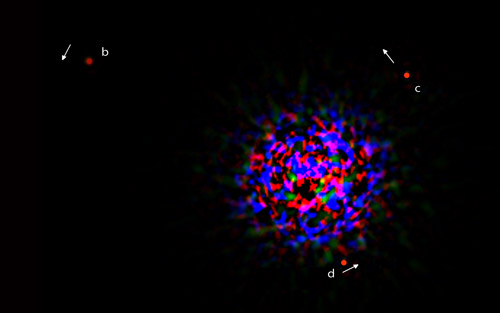
Figure 1: Three large planets (b, d, and c) around the star HR 8799. (Science. November 28th 2008. Volume 322, Page 1348.)
Exactly thirteen years after the existence of 51 Pegasi B was published, a new technique called direct observation yielded its first success: three large planets around the star HR 8799. Direct observation dispenses with inferential data. Instead, light from planets is separated from the star and concentrated with long exposures. The known system is shown in Figure 1 (to the right).
In this image, the planets are nearly 100,000 times fainter than the star. Without starlight suppression, the entire frame would render as a block of impenetrable light. The remnants of the star are visible as a collection of iridescent speckles, and around this ball of muted light orbit three small, red dots: HR 8799 b, c and d. Speckles are such a notorious problem in optics of this kind that a whole subfield has been spawned to invent ways to contain them. Fortunately, HR8799 has a giant solar system with distant planets that aren’t consumed by the speckles. Our own system would sit squarely within the cluster. Neptune is about as far out as HR8799 d. The most distant planet in the HR 8799 system is 68 astronomical units away from its star, or 68 times the distance of the Earth from our Sun. It takes 450 years to complete one orbit.
HR8799 is a young star. It’s so young that its visible planets are still hot and generate their own light. Earth-based direct observation can only detect hot planets. The imaging technology is not yet capable of detecting reflected light. It’s too faint. But a spacebased telescope could do the job. In May of 2002 NASA funded a feasibility study for the Terrestrial Planet Finder (TPF), a proposed orbital telescope devoted to planetary imaging and the cancellation of starlight. The TPF’s angular resolution would make detecting a Jupiter-like planet a cinch and an Earthsized planet a genuine possibility. In 2004, the TPF’s architecture was approved for construction at a cost that engineers estimated at $10 billion. By 2009, after the dramatic depths of the recession had worked its way through the budget, NASA’s share had shriveled and the TPF’s completed schematics were bound and shelved, a worked but unrealized solution. Oppenheimer has no patience for the government’s misallocation. “NASA’s budget in the scheme of things is ridiculous. It’s like a drop in the bucket. We could choose to do so much more, but we don’t,” said Oppenheimer. “If you want to understand the Earth, you need something to compare it to.”
HR8799’s currently visible planets could never sustain Earth-type life. But rocky worlds in its habitable zone may be buried in the morass of speckles. While transiting and radial velocity excel at the detection of Hot Jupiters and planetary bodies close in on their stars, ground-based direct observation is limited to the detection of gas giants at glacial distances. Coronography has succeeded in making the light of distant planets accessible, but starlight is a pesky thing. It diffracts around the optical stop, it leaves ghosts of its deleted self. The speckles can be dimmed but never removed. The exoplanetary sweet spot, the habitable zone, a narrow ring around each star, is ironically the most elusive band for detection of any kind.
The technical challenge is immense. Project 1640 consists of four homegrown instruments that relay light from the sky to a computer screen. The optics are so complex that only 10% of the non-occulted, impinging light survives the process. First, the adaptive optics system compensates for the atmosphere. The coronograph then tempers the target star’s light. An integral field spectrograph, which Oppenheimer simply calls the science camera, records 30 images of the star across 30 different colors simultaneously. A calibration wavefront sensor (CAL) measures and compensates for the defects in the optics. Images from the science camera are stacked, one slice per color. Oppenheimer calls this 3D image The Cube. It’s not three-dimensional in space. The image of the star is flat. Here, depth is devoted to color. The location of a speckle is dependent on the color observed. If you trace a single speckle through the cube, you’ll notice that it radiates out from the star’s center. The cube is the star’s pop-up book, telling its story in three dimensions with slices through the electromagnetic spectrum. The images are beautiful when animated, as if the star were a multi-chromatic geyser of its own occulted remnants. Planets are points of light that drill through the cube, motionless through every section as the speckles scatter.
Of all the instruments currently used at the Hale telescope, project 1640 is the most complex. In all, the project has one hundred nights of observing time. When the sun goes down, a clock starts ticking in Oppenheimer’s head. If it rains, if it’s cloudy, if the seeing is lost in swirls of misbehaving air, he goes home with nothing. There are no allowances for bad luck. The Monastery has a guest book where scientists and visitors can formalize their paeans to Palomar. When Oppenheimer signed this book four years ago, he did not mince his ambition with customary homage. Instead he wrote a declaration. “June 24th, 2008. Project 1640 has arrived from NYC. We shall see whether it works in short order.”
***
Three and a half years later, Tom Lockhart was sitting on the toilet seat in the control room’s bathroom. The temperature in the dome had dipped below freezing, unusually cold even for December on the mountain. Lockhart designs and runs the software controlling the CAL system. He wore a hat with earflaps and was warming a motherboard against the radiant coils of an old heater. “I don’t know. The thing just started beeping,” he said. Computer hardware fails when it’s hot. Everyone knows that. But the motherboard in the CAL started talking to Lockhart when it got too cold. “It slowed to a fraction of its normal speed and then told me it was shutting itself off. You ever hear of anything like that?”
The telescope was pointed at HR 8799. Oppenheimer wanted to see whether the new instrument could pick up known planets. “Can you people please clam down? Where’s Tom?” Oppenheimer asked.
“He’s in the bathroom having a good time with the CAL’s processor,” Gautam Vasisht said. Vasisht is the CAL’s hardware designer. He and Oppenheimer shared an office when they were graduate students at Caltech. Vasisht is the small, ironic subtext to Oppenheimer’s volubility. “So much for the romance of astronomy.”
“I feel like I’m doing the same thing over and over again. Like I’m in some kind of nightmare,” Oppenheimer said. Trouble with the CAL’s processor meant less time on sky. “In a way, it’s good there’s bad seeing.” The stars were translucent behind a high, thin sheet of clouds. “Where the fuck is Tom? Seriously. Is the CAL going to work? It might clear any second.”
The room was filled with physicists. Mike Shao, honored with the 2010 Michelson prize for his pioneering work on ground and space based interferometers, asked if there was a resistor lying around. “If we plug in a resistor and put it directly on the computer’s enclosure, would that heat it up enough?”
Shao’s suggestion was like asking an astronaut whether duct tape could hold together a splintering spacecraft (which worked for Apollo 13!). After years of engineering precision starlight control, in unanticipated cold, the resistor was the kind of kluge you have to dig deep for: high school physics rounding out the rough edges on Palomar Mountain.
“There might be something downstairs. Hold on,” said Kajsa Peffer, one of the telescope operators.
Lockhart stood up, turned off the bathroom heater, and closed the door behind him. Satisfied with the roasting he gave the CAL’s motherboard, he went into the dome to reinstall it. He took with him some duct tape and the resistor Kajsa had dug up from the spare parts room. Lockhart strapped the resistor to the instrument, and turned off the computer’s cooling fans, so the work of imaging other worlds could proceed
“We’ve tried to image this system eight times and the conditions have been bad every time,” said Oppenheimer. “Now the conditions are bad and all the instruments are screwed up. It’s like the aliens are trying to hide their planet from us.”
“Imaging exoplanets: an exercise in fucking futility,” said Vasisht.
“Seriously man. I hate this fucking star. We haven’t recorded a single science frame tonight. This star hates this project. Kajsa, how long can we stay on this piece of shit?” asked Oppenheimer of the telescope’s operator.
“Two hours.”
“Two more hours? Oh god. You people need to calm down.”
When you can get it, light from a planet is a rich source of information. A few collected photons can betray an entire atmosphere’s chemistry. Chemical species absorb particular frequencies of light leading to dips in reflectance along certain points in the spectrum. In 1961, James Lovelock, an independent scientist and inventor, was contracted by NASA to determine what could be seen from a planet’s light, from these spectra. Lovelock reasoned that if a planet were alive, its atmosphere would contain highly reactive compounds—oxygen, methane, hydrogen— at high concentrations despite their tendency to react with one another. From afar, a spectrum of our planet’s atmosphere would betray chemical disequilibrium. Oxygen and ozone cooccur with methane. Water vapor lubes the mix. On a dead planet, molecular oxygen and fully reduced carbon (like methane) would be unlikely to co-exist. Life keeps these biosignatures at high concentrations as raw material for our fundamental processes: respiration and growth.
We only know of one planet with life. With this in mind, Carl Sagan devised an experiment to peek at Earth from space. In the early 1990s, as the Galileo spacecraft swung around Earth in a gravitational shot towards Jupiter, Sagan turned its camera back towards our planet. In the paper describing this effort (Nature 365, 715–721, 21 October 1993), Sagan imagined the Earth was extraterrestrial, deriving “conclusions from Galileo data based on first principles alone. He found an “abundance of gaseous oxygen” and “atmospheric methane in extreme thermodynamic disequilibrium.” The spectrum also highlighted a “widely distributed surface pigment with a sharp absorption edge in the red part of the visible spectrum.” Chlorophyll: plants. Of course, the experiment was a conceit. The light Sagan collected, its luminosity and detail, is a pipe dream given the scraps Oppenheimer collects from other worlds. The question is what would Earth look like if you could only scavenge a few photons? What would it look like well beyond our solar system?
It turns out you can look back at the Earth, as if from deep space, while standing on your roof. Our planet is reflected back to us every night by the moon. During its crescent phase, the moon’s brilliant edge cradles an ashy wisp of the rest of its body. The crescent reflects the Sun while the darker whole reflects the Earth. This phenomenon is known as earthshine: our light returning to us from our moon. Because the moon is an imperfect reflector, the Earth’s light is homogenized, mimicking its appearance from great distances well beyond our solar system, even from neighboring stars. Earthshine is our best guess at what the light from a living, breathing planet might look like when viewed from other parts of the galaxy. Above is a picture of Earth from the moon, our proxy for light years away (Figure 2).
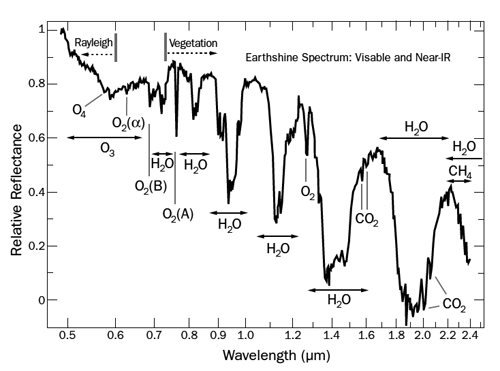
Figure 2: Measuring earthshine as reflected by the Moon is our best guess at what the light from a living, breathing planet might look like. (Redrawn from The Astrophysical Journal, Volume 644, Issue 1, pp. 551–559.)
This is a spectrum. The x-axis plots a narrow section of wavelengths in the visible and near infrared. The y-axis is an index of reflectivity: lower reflectivity at a given wavelength implies an absorbing entity, a molecule cutting into the light. The signatures of life on this planet are coded into the peaks and dips of this graph: the oxygen respired by animals, the carbon dioxide absorbed by plants, the methane emitted from geological activity like volcanoes and biological activity like flatulent cows, the ozone that protects DNA from ultraviolet radiation, the water that supplies electrons for building complex sugars in plants, and the signature of pigments used by the light-harvesting biomolecular machines that energize this planet. A living planet’s vitality informs its chemical constituency and life is dissolved into an atmosphere of its own creation. This thin shell of gas is a message from the planet; light can signal whether it’s alive or dead. Pictures like these are what Oppenheimer and the Project 1640 crew want from faraway worlds. But the spectra will be fingerprints, detailed, distinct. If it exists, life elsewhere will likely be very different, but still optically and chemically accessible.
The CAL’s processor was back up and only one hour remained before HR8799 would set. Now that everything was finally working, the stars hid behind a new set of thin clouds. “Of course that would happen,” Oppenheimer said. “It’s like we can’t win with this crap. Why don’t we do something easy like banking? We’d make a lot more money.”
“In Monopoly, my daughter’s realized that if she’s the banker, she always wins,” Vasisht said.
“If I wanted to make money then I wouldn’t be here,” said Douglass Brenner, a programmer, physicist, and Oppenheimer’s right hand for the last five years. The group refers to him as The Doug. The Doug thinks he looks like Steven Spielberg with long hair. The Doug likes to talk about Peak Oil and signal processing.
Postdocs Justin Crepp, Laurent Pueyo, Sasha Hinkley, and myself were also in the control room, a safe distance from the actual controls. Crepp wrote the software that achieves speckle reduction. It’s a work in progress known as the Justin Program. “At my Caltech reunion all my old classmates had hedge funds,” Vasisht said. “They have a lot more money then me. One of them asked me to invest so I put in a hundred.”
“A hundred what?” The Doug asked.
Pueyo was listening in. “Banking? Well, at least we’re not bored.”
The sky was sealed. Crepp fiddled with the Justin program. Hinkley read papers. Pueyo skyped with his Mom in France about his upcoming wedding in San Francisco. By the time the clouds cleared HR8799 was gone, so the telescope was trained on anther star, FU Ori in the constellation Orion.
Oppenheimer set the instrument to take fiveminute exposures before heading to the catwalk. With every iteration, a woman’s voice would mark data capture. “Image processing complete. Awaiting instructions.” The voice is sultry, receptive, and almost expectant. Oppenheimer had programmed her as a joke. She sounds like HAL’s humanizing mate. But unlike Arthur C. Clarke’s HAL, whose creepy conversation betrays progressive hints of malfunction, the woman’s words are unchanged even as Oppenheimer’s system faults in subtle ways, even as everyone’s head is buried in their hands. At one point earlier in the evening, sometime after the CAL’s hardware had warmed and before its software had failed, Oppenheimer lost his cool. He is intense, but rarely out of control. The night’s failures were too much. “There’s no tomorrow in optical astronomy,” he said. “The rotation of the Earth doesn’t care about your apologies.” He said it to no one in particular. He might as well have said it to himself. Project 1640 is a lose conglomeration of parts that barely fit, and people that fit together almost too well.
At 5am our brains were fried. I looked around and saw the same blank look in everyone’s eyes. Night lunches were strewn about. A Christmas tree was edging off its table. The smell of stale coffee rose from a dozen cups. The long night had removed key modules from our heads. As dawn lightened the sky and bodies felt the abuse of sleepless exhaustion, I could almost hear HAL in my head: “I’ve still got the greatest enthusiasm and confidence in the mission. And I want to help you. But my mind is going. I can feel it.”
***
The Drake equation looks like this: N = R* × fp × ne × fl × fi × fc × L
Where N is the number of civilizations in the galaxy with which we might communicate. N is directly proportional to R*, the average rate of star formation per year in our galaxy because, presumably, any habitable world will need a parent star. Then there are the whittling terms. What fraction of those stars have planets (fp)? How many of those planets are similar to earth (ne)? What fraction of these demonstrate signatures of life regardless of complexity (fl)? What fraction of the planets with life generate intelligent life, self aware and capable of formulating long, inscrutable equations (fi)? What fraction of planets with such beings communicate the signals of their technology in ways we can detect (fc)? And how long do these civilizations persist before they go extinct (L)? The Drake equation is like a confident man who stands tall before he is cut down to size. There are billions of stars in the galaxy, but successive fractionation can make astronomical numbers seem terrestrial. Frank Drake conceived the equation in 1960 after making the first attempts at detecting radio signals from extraterrestrial civilizations. Shortly thereafter, Drake organized a meeting on the detection of extraterrestrial intelligence, which ultimately seeded SETI. The equation was devised as talking points for an agenda. “I wrote down all the things you needed to know to predict how hard it’s going to be to detect extraterrestrial life.” Drake factorized each hurdle.
Some of the scientists on Project 1640 are shy about this notion of life on other planets. Others won’t shut up about it. If their willingness to speak on the subject were itself a spectrum, Oppenheimer would anchor the forthcoming believers. Mike Shao is far more reticent. When I asked him his thoughts on habitability, I pushed him on the potential momentousness of such a discovery. With a faint grin, he deflected my enthusiasm without being mean or unsupportive. “Yes, finding planets that can support life is a little bit different than finding a normal planet.” Really? A little bit different? Gauthum Vasisht is similarly evasive. “Frankly, I’m more interested in the architecture of planets. Fools like me get excited by any little thing. I guess some people are better at looking at the big picture.” Shao and Vasisht deployed the measured tones of science to diffuse the science fiction. The Doug, a self-anointed skeptic, was less willing to let a journalist run away with the idea of life on other worlds. “Astrobiology is a complete waste of time. The habitable zone is just a way to keep the public interested. There’s so much out there. We really don’t have a clue. I think it’s more bullshit than poetry.” Against the cynic, many of the students stood out in optimistic relief albeit tempered by their first few tastes of fiscal reality. At one point, while in the cage talking to Sasha Hinkley he got into a fit about our nation’s commitment to science. We were in the dark turning Allen wrenches a few millimeters one-way, and a few less back. “Americans spent $500 billion on gambling last year. Do you know how many more candidates we could generate with that kind of cash? It’s a real shame, man.”
Perhaps the most balanced of the astronomers I met was Charles Beichman, the Executive Director of the NASA Exoplanet Science Institute at Caltech. Chas, as he’s known to everyone on Project 1640, has been instrumental to the development of direct observation and isn’t shy about the work’s implications or its difficulties. “Astrobiology is part of the program. Biologists are part of our program. What do we mean by life? How much is specific to Earth, how much is based on universal principles? I’ll bet that life is abundant, but the thing is, I’ll probably never have to make good on that bet.” Beichman illustrated how far he was willing to go by hopping along the Drake equation. “We have an estimate for the number of stars in our galaxy, we know that each star has at least one planet, and we’re starting to get spectra that may nail down the fraction of these that are habitable.” But Beichman won’t touch the later terms. “The search for intelligent life is a search for electrical engineers.” If SETI is successful, we will know of at least one technological civilization capable of communication, but the discovery is not a quantity that can be factored back into the Drake. It’s one instance, one world with no statistical heft. It might be the most important discovery ever, but it would draw a line between two technological civilizations and dispense no clues as to whether the line is just one strand in a larger web.
Oppenheimer believes we have to look for life, simple or otherwise. In a review he wrote detailing the state of direct observation, Oppenheimer concluded with an impassioned mission statement, the kind you don’t see in the scientific literature. “Given the immensely compelling nature of the science involved in detecting places that might host life outside our Solar System, there is no question that, barring the annihilation of Homo sapiens, people will, and in some sense must, conduct such missions. We know how to do them now” (Annual Review of Astronomy and Astrophysics, Volume 47, pages 253–289). The passage is both a goad and an admonition: Get on it! Why haven’t we done it yet? It’s a directive, a call to arms. I’m surprised he got away with it.
Oppenheimer’s personality is often in conflict with the inherent passivity of his craft. Astronomy is almost wholly observational. We are not in conversation with the cosmos, and it is this unidirectional flow of information that makes astronomy our purest and in some ways, most frustrating science. We cannot affect the product. The universe just sort of happens to us. You wait for light and it arrives with a message from the past, long after the source emitted it, perhaps long after the source has died. We have no capacity to affect the universe in any significant way. And because astronomy is so much a science of soaking things in, of waiting for information to come to you, we have built larger and larger telescopes to make sure nothing is missed of the light the universe bathes us in. The reward is deep astronomical vision.
But not yet deep enough. If we want to image other Earths, we need to do it from space. We can’t sift the light the way it needs to be sifted from the ground. The Terrestrial Planet Finder would have at least had a chance. “When you first think of a new idea, it’s like digging in topsoil, but with each technique you end up hitting bedrock,” said Beichman. The bedrock could be the limits of our technology or current understanding, it could be the realization of an engineering nightmare, or it could be political unwillingness. “So you get another shovel and dig somewhere else.” We live in a nation more attuned to our terrestrial messes than our larger place in the cosmos. We’re all about warming ice, warped economies, and war. To a dreamer with the long view on space and time, quotidian upkeep of our planet is both an afterthought and a black hole—so minor in the grand scheme but a sink for all of our collective energy.
***
Shortly before our trip to Palomar, Oppenheimer and I had lunch around the corner from the museum. While we were walking back, the sky opened over the Upper West Side and it began to pour. Stuck on Columbus Avenue, we ducked under an awning and stood around for a bit, waiting for the worst of it to pass. “Do you like rain?” Oppenheimer asked. We had been walking in silence for a few seconds, and I was asking all the questions, so I was a bit startled. I told him I didn’t mind as long as I wasn’t caught without my umbrella. His eyes lit up. “I prefer the rain,” he replied. “The sun can be so brilliant it blocks all the color.” I had never thought of color in this way. Everything seems so much more radiant in the sun. But to Oppenheimer the sun has a dulling effect. “I can see so much more clearly when it isn’t out.”
Whether it’s this planet or one 50 light years away, Oppenheimer quenches the glare of suns. Our exchange got me to thinking more about coronography. Project 1640 blocks starlight using a physical occulter and digital subtraction. But there are more fantastic, space-based notions as well. Mike Shao told me that when you build a one of a kind machine in space, “the cost is what the person writing the check is willing to pay.” So imagine a space-based telescope trained on a star whose planets are thought to be rocky and in close orbit, like our own. Now imagine that this telescope is equipped with its own shade, a giant piece of circular material two football fields in diameter that unfurls between the star and the telescope’s aperture. The edges of the shade gently oscillate around its center, the projection of a sunflower in interstellar space (Nature 2006 442(7098): 51–53). The star shade blocks a sun’s light before it enters the telescope. All that remains are the tiny specks around it, now in relief, amplified.
The dream is of amplitude. In both the astronomical and figurative sense, amplitude is what we want from these great eyes to the sky. We want to brighten the dim and we want to see with greater depth planets within the horizons of our perception. In one of our earliest conversations, Oppenheimer told me that when he sits down to think, all he has is the light. This insight is so clean and exhilarating. Light rains into a million backyard telescopes and a handful of engineering monuments. The universe transmits information in tight little beams. There’s nothing else. Large mirrors collect this information with great acuity. Large shades block the most obvious rays. But in the end all we want is the light from what we know must be there—hope is there—but can’t yet see. ![]()
The Wisdom of Psychopaths: What Saints, Spies, and Serial Killers Can Teach Us About Success

University of Oxford research psychologist Dr. Kevin Dutton reveals that there is a scale of “madness” along which we all sit. Incorporating the latest advances in brain scanning and neuroscience, Dutton demonstrates that the brilliant neurosurgeon who lacks empathy has more in common with a Ted Bundy who kills for pleasure than we may wish to admit, and that a mugger in a dimly lit parking lot may well, in fact, have the same nerveless poise as a titan of industry. Dutton argues that there are “functional psychopaths” among us—different from their murderous counterparts—who use their detached, unflinching, and charismatic personalities to succeed in mainstream society, and that shockingly, in some fields, the more “psychopathic” people are, the more likely they are to succeed. Dutton deconstructs this often misunderstood diagnosis through bold on-the-ground reporting and original scientific research as he mingles with the criminally insane in a high-security ward, shares a drink with one of the world’s most successful con artists, and undergoes transcranial magnetic stimulation to discover firsthand exactly how it feels to see through the eyes of a psychopath.
TAGS: Kevin Dutton, psychopathy, transcranial magnetic stimulation12-10-24
In this week’s eSkeptic:
About this week’s eSkeptic
In this week’s eSkeptic, Michael Shermer remembers Paul Kurtz, who died October 20, 2012 at the age of 86. Kurtz was one of the founders of the modern skeptical movement, and he embodied the principle of skepticism as thoughtful inquiry.

Paul Kurtz & the Virtue of Skepticism
How a Thoughtful, Inquiring, Watchman
Provided a Mark to Aim at
by Michael Shermer
Skepticism dates back to the ancient Greeks, well captured in Socrates’ famous quip that all he knows is that he knows nothing. Skepticism as nihilism, however, gets us nowhere and, thankfully, almost no one embraces it. The word “skeptic,” in fact, comes from the Greek skeptikos, for “thoughtful”—far from modern misconceptions of the word as meaning “cynical” or “nihilistic.” According to the Oxford English Dictionary, “skeptical” has also been used to mean “inquiring,” “reflective,” and, with variations in the ancient Greek, “watchman” or “mark to aim at.” What a glorious meaning for what we do! We are thoughtful, inquiring, and reflective, and in a way we are the watchmen who guard against bad ideas, consumer advocates of good thinking who, through the guidelines of science, establish a mark at which to aim. Paul Kurtz, who died this week at the age of 86, was one of the founders of the modern skeptical movement, and he embodied the principle of skepticism as thoughtful inquiry. He truly was a watchman that provided a mark at which we skeptics may all aim.
Since the time of the Greeks, skepticism (in its various carnations) has evolved along with other epistemologies and their accompanying social activists. The Enlightenment, on one level, was a century-long skeptical movement, for there were no beliefs or institutions that did not come under the critical scrutiny of such thinkers as Voltaire, Diderot, Rousseau, Locke, Jefferson, and many others. Immanuel Kant in Germany and David Hume in Scotland were skeptics’ skeptics in an age of skepticism, and their influence continues unabated to this day (at least in academic philosophy and skepticism). Closer to our time, Charles Darwin and Thomas Huxley were skeptics par excellence, not only for the revolution they launched and carried on (respectively) against the dogma of creationism, but also for their stand against the burgeoning spiritualism movement that was sweeping across America, England, and the continent. Although Darwin was quiet about his spiritual skepticism and worked behind the scenes, Huxley railed publicly against the movement, bemoaning in one of the great one-liners in the history of skepticism: “Better live a crossing-sweeper than die and be made to talk twaddle by a ‘medium’ hired at a guinea a séance.” In the twentieth century Bertrand Russell and Harry Houdini stand out as representatives of skeptical thinkers and doers (respectively) of the first half, and skepticism in the second half of the century was marked by Martin Gardner’s Fads and Fallacies in the Name of Science, launching what we think of today as “the skeptics movement,” which Kurtz so courageously organized and led.
There has been some debate (and much quibbling) about who gets what amount of credit for the founding of the modern skeptical movement through the organization Committee for the Scientific Investigation of Claims of the Paranormal (CSICOP) and its journal Skeptical Inquirer (much of this history has been outlined in the pages of my own magazine, Skeptic, in interviews with the leading lights of the skeptical movement). This is not the place to present a definitive history of the movement, but from what I have gleaned from first- and second-hand sources is that science writer Martin Gardner, magician James Randi, psychologist Ray Hyman, and philosopher Paul Kurtz played primary roles in the foundation and planning of the organization and the subsequent movement.
There is little to no chance that we can convince True Believers of the errors of their thinking. Our purpose is to reach that vast middle ground between hard-core skeptics and dogmatic believers—people like me who thought that there might be something to these claims but had simply never heard a good counter explanation.
Regardless of who might be considered the “father” of the modern skeptical movement, everyone I have spoken to (including the other founders) agrees that it was Paul Kurtz more than anyone else who actually made it happen. All successful social movements have someone who has the organizational skills and social intelligence to get things done. Paul Kurtz is that man. When he founded the organization that launched the modern skeptical movement, I was a graduate student in experimental psychology. About this time (the mid 1970s) Uri Geller entered my radar screen. I recall Psychology Today and other popular magazines published glowing stories about him, and reports were afloat that experimental psychologists had tested the Israeli psychic and determined that he was genuine. My advisor—a strictly reductionistic Skinnerian behavioral psychologist named Doug Navarick—didn’t believe a word of it, but I figured there might be something to it, especially in light of all the other interesting research being conducted on altered states of consciousness, hypnosis, dreams, sensory deprivation, dolphin communication, and the like. I took a course in anthropology from Marlene Dobkin de Rios, whose research was on shamans of South America and their use of mind-altering plants. It all seemed entirely plausible to me and, being personally interested in the subject (the Ouija board consistently blew my mind), I figured that this was rapidly becoming a legitimate subfield of psychological research. After all, Thelma Moss had a research laboratory devoted to studying the paranormal, and it was at UCLA no less, one of the most highly regarded psychology programs in the country.
With the support and encouragement of Kurtz, Martin Gardner, Ray Hyman, and especially James “the Amazing” Randi entered the public sphere through popular and technical publications debunking such nonsense, and Randi went on television to reveal how the psychics actually do their tricks. It was, in fact, on Johnny Carson’s Tonight Show that Randi demonstrated how to levitate tables, bend spoons, and perform psychic surgeries. Randi didn’t convince me to become a full-fledged skeptic overnight, but it got me thinking that if some of these psychics were fakes, perhaps they all were (and if not fakes, at least self-deceived). Herein lies an important lesson.
There is little to no chance that we can convince True Believers of the errors of their thinking. Our purpose is to reach that vast middle ground between hard-core skeptics and dogmatic believers—people like me who thought that there might be something to these claims but had simply never heard a good counter explanation. There are many reasons why people believe weird things, but certainly one of the most pervasive is simply that most people have never heard a good explanation for the weird things they hear and read about. Short of a good explanation, they accept the bad explanation that is typically proffered. This alone justifies all the hard work performed by skeptics toward the cause of science and critical thinking. It does make a difference.
For 20 years now I have been at the head of the Skeptics Society and Skeptic magazine, and as such as much as I admire Randi, Gardner, and the other public faces of skepticism, I have come to respect more than ever before what Paul Kurtz has done for our movement. He may not be as prolific and famous a writer as Martin Gardner, or as public and visible an activist as James Randi, but in terms of the day-to-day grind of keeping a movement afloat through the constant battering and assaults that come from variegated sources, there are few that can be compared with Paul Kurtz. So I close this brief remembrance with several excerpts from what I still consider to be his finest work, The Transcendental Temptation, that should be mandatory reading for all graduates of a Skepticism 101 course.
The temptation, says Kurtz, “lurks deep within the human breast. It is ever-present, tempting humans by the lure of transcendental realities, subverting the power of their critical intelligence, enabling them to accept unproven and unfounded myth systems.” Specifically, Kurtz argues that myths, religions, and claims of the paranormal are lures tempting us beyond rational, critical, and scientific thinking, for the very reason that they touch something in us that is sacred and important—life and immortality: “This impulse is so strong that it has inspired the great religions and paranormal movements of the past and the present and goaded otherwise sensible men and women to swallow patently false myths and to repeat them constantly as articles of faith.” What drives this temptation? The answer Kurtz provides is both insightful and elegant:
Let us reflect on the human situation: all of our plans will fail in the long run, if not in the short. The homes we have built and lovingly furnished, the loves we have enjoyed, the careers we have dedicated ourselves to will all disappear in time. The monuments we have erected to memorialize our aspirations and achievements, if we are fortunate, may last a few hundred years, perhaps a millennium or two or three—like the stark and splendid ruins of Rome and Greece, Egypt and Judea, which have been recovered and treasured by later civilizations. But all the works of human beings disappear and are forgotten in short order. In the immediate future the beautiful clothing that we adorn ourselves with, eventually even our cherished children and grandchildren, and all of our possessions will be dissipated. Many of our poems and books, our paintings and statues will be forgotten, buried on some library shelf or in a museum, read or seen by some future scholars curious about the past, and eventually eaten by worms and molds, or perhaps consumed by fire. Even the things that we prize the most, human intelligence and love, democratic values, the quest for truth, will in time be replaced by unknown values and institutions—if the human species survives, and even that is uncertain. Were we to compile a pessimist’s handbook, we could easily fill it to overflowing with notations of false hopes and lost dreams, a catalogue of human suffering and pain, of ignominious conflict, betrayal, and defeat throughout the ages.
Although Kurtz sounds like a pessimist, he’s actually a realist, occasionally even an optimist:
Were I to take an inventory of the sum of goods in human life, they would far outweigh the banalities of evil. I would outdo the pessimist by cataloguing laughter and joy, devotion and sympathy, discovery and creativity, excellence and grandeur. The mark made upon the world by every person and by the race in general would be impressive. How wonderful it has all been. The pessimist points to Caligula, Attila, Cesare Borgia, Beria, or Himmler with horror and disgust; but I would counter with Aristotle, Pericles, da Vinci, Einstein, Beethoven, Mark Twain, Margaret Sanger, and Madame Curie. The pessimist points to duplicity and cruelty in the world; I am impressed by the sympathy, honesty, and kindness that are manifested. The pessimist reminds us of ignorance and stupidity; I, of the continue growth of human knowledge and understanding. The pessimist emphasizes the failures and defeats; I, the successes and victories in all their glory.
The most important point Kurtz makes in The Transcendental Temptation comes toward the end in his discussion of the meaning and goals of skepticism. It is an admonition we should all bear in mind, a passage to be read once a year:
The skeptic is not passionately intent on converting mankind to his or her point of view and surely is not interested in imposing it on others, though he may be deeply concerned with raising the level of education and critical inquiry in society. Still, if there are any lessons to be learned from history, it is that we should be skeptical of all points of view, including those of the skeptics. No one is infallible, and no one can claim a monopoly on truth or virtue. It would be contradictory for skepticism to seek to translate itself into a new faith. One must view with caution the promises of any new secular priest who might emerge promising a brave new world—if only his path to clarity and truth is followed. Perhaps the best we can hope for is to temper the intemperate and to tame the perverse temptation that lurks within.
R.I.P. Paul Kurtz. We all owe you a great debt of gratitude for making the world a better place. You will be missed. ![]()

NEW ON SKEPTICBLOG.ORG
Why Ayn Rand Won’t Go Away
After seeing the Los Angles premiere of Atlas Shrugged, Part 2, the film that opened October 12 based on the 1957 novel by Ayn Rand (and with an entirely new cast and higher production values a vast improvement over Part 1), a question struck Michael Shermer as he was exiting the theater surrounded by Hollywood types most commonly stereotyped as liberal: Why don’t liberals admire Ayn Rand and her philosophy of objectivism, so forcefully presented in this book and film?

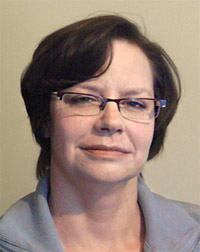
YEC and Beowulf: It’s verse than you think
There are those who believe the Earth is only about 6000 years old. They believe that the evidence for this is all in the Bible, but as we’ve discussed on MonsterTalk before, they still seek confirmatory evidence from other works. So it was only a matter of time before someone suggested that the epic poem Beowulf helps prove that (a) the earth is indeed very, very young and (b) that the monsters in the poem Beowulf were dinosaurs. Hard to believe? Tune in as we talk to skeptic and Humanities researcher Eve Siebert about the most surprising interpretation of this classic story you’re likely to hear.
Watch Dr. Kevin Dutton for free online,
broadcast live from Caltech!
New Admission Policy and Prices
Please note there are important policy and pricing changes for this season of lectures at Caltech. Please review these changes now.
SINCE 1992, the Skeptics Society has sponsored the Skeptics Distinguished Science Lecture Series at Caltech: a monthly lecture series at the California Institute of Technology in Pasadena, CA. Most lectures are available for purchase in audio & video formats. Watch several of our lectures for free online. Our next lecture is…

The Wisdom of Psychopaths: What Saints, Spies, and Serial Killers Can Teach Us About Success
Sunday, October 28, 2012 at 2 pm
Baxter Lecture Hall
University of Oxford research psychologist Dr. Kevin Dutton reveals that there is a scale of “madness” along which we all sit. Incorporating the latest advances in brain scanning and neuroscience, Dutton demonstrates that the brilliant neurosurgeon who lacks empathy has more in common with a Ted Bundy who kills for pleasure than we may wish to admit, and that a mugger in a dimly lit parking lot may well, in fact, have the same nerveless poise as a titan of industry. Dutton argues that there are “functional psychopaths” among us—different from their murderous counterparts—who use their detached, unflinching, and charismatic personalities to succeed in mainstream society, and that shockingly, in some fields, the more “psychopathic” people are, the more likely they are to succeed. Dutton deconstructs this often misunderstood diagnosis through bold on-the-ground reporting and original scientific research as he mingles with the criminally insane in a high-security ward, shares a drink with one of the world’s most successful con artists, and undergoes transcranial magnetic stimulation to discover firsthand exactly how it feels to see through the eyes of a psychopath.
Followed by…
- Dr. SEAN M. CARROLL
The Particle at the End of the Universe: How the Hunt for the Higgs Boson
Leads Us to the Edge of a New World
Sunday, November 18, 2012 at 2 pm
Baxter Lecture Hall
12-10-17
In this week’s eSkeptic:


Ankylosaur Attack nominated for Silver Birch. ORDER THE BOOK.
NEW ON SKEPTICBLOG.ORG
Ankylosaur Attack
Nominated for Silver Birch
Daniel Loxton announces that his book Ankylosaur Attack is among the 2013 Forest of Reading Silver Birch Express Award nominees revealed by the Ontario Library Association.
My First Junior Skeptic Cover,
10 Years Ago This Month
Daniel Loxton offers some “making of” insight into his first Junior Skeptic cover—completed 10 years ago this month.

A Threesome With Jesus
SKEPTICALITY EPISODE 193
This week on Skepticality, Derek sits down with Dr. Darrel Ray to discuss his latest book, Sex and God: How Religion Distorts Sexuality. Dr. Ray, is a former minister, now the creator of the Recovering From Religion support system, and founder of the Secular Therapist Project which allows secular-minded people to find therapists near them who practice from a secular, scientific mindset. His new book discusses the harm that religion continues to exert on human sexuality in modern society, and how this harm happens within almost every sect, and flavor of belief.
Get the Skepticality Podcast App
for Apple and Android Devices!
Get the Skepticality App — the Official Podcast App of Skeptic Magazine and the Skeptics Society, so you can enjoy your science fix and engaging interviews on the go! Available for Android, iPhone, iPad, and iPod Touch. Skepticality was the 2007 Parsec Award winner for Best “Speculative Fiction News” Podcast.
The Latest Episode of Mr. Deity
WATCH THIS EPISODE | DONATE | NEWSLETTER | FACEBOOK | MrDeity.com
About this week’s eSkeptic
Recently, we posted Chris White’s 3-hour refutation of the theories proposed on the History Channel’s Ancient Aliens that claim we were engineered by extraterrestrials. However, the notion of a worldwide flood mentioned in the otherwise excellent documentary could use some debunking.
In this week’s eSkeptic, Skeptic magazine’s Religion Editor, Tim Callahan, and our resident geologist Donald Prothero, debunk Noah’s Flood both from a mythological and geological standpoint.

“And the waters prevailed upon the earth an hundred and fifty days.” —Genesis 7:24
“The World Destroyed by Water” by Gustave Doré.
A Flood of Nonsense!
The Myth of a Universal flood Myth
by Tim Callahan
One of the programs of the (so-called) History Channel that is particularly galling to me as a skeptic is their Ancient Aliens series, where Erich von Daniken, Zecharia Sitchen, Georgio Tsoukalos and David Childress, among others, advance the pseudo-scientific theory that extraterrestrials both created us through biological engineering and gave us our ancient civilizations. In the process of advancing their dogma, they spout blatant falsehoods that go utterly unchallenged. The History Channel, shamefully, makes no attempt whatsoever to offer any rebuttal to these spurious claims. Rather, as is their policy with any program dealing with the historicity of anything from the Bible, their policy toward ancient astronaut theorists is one of shameless pandering, a strategy most probably determined by favoring profits over proof and ratings over reason. Fortunately, filmmaker Chris White has addressed this imbalance, putting the lie to these claims thoroughly in his three-hour documentary Ancient Aliens Debunked, recently posted on Skeptic.com.
Unfortunately, in one area in particular Mr. White has stumbled badly in his assertion that the biblical story of the flood is not derived from Sumerian flood stories (whose connection to the ancient alien series is thin in any case) and instead claims that both biblical and Sumerian flood stories reflect an actual worldwide flood and are not the result of cultural diffusion from some earlier myth. According to White, all over the world there is a universal myth of a worldwide flood in which only a few people, usually about eight, are saved by entering a boat, while the rest of humanity is drowned. White argues that, of course, one great drawback to such an assertion is that science in no way supports such a universal flood. Geology and the fossil record and genetics all militate strongly against any historical validity of a worldwide flood. Thus, comparative mythology is his only evidence on the offing.
Are flood myths universal? No. At least, not one in which a worldwide flood wipes out all of the human race but for a couple or a single family. Consider the case of China. Does this large country with an unbroken history going back to ancient times have a flood myth, replete with a boat on which a few survivors escape, from thence to reestablish the human race? It does, however that particular flood myth comes from an ethnic minority called the Miao. They speak a language similar to Thai and appear to have immigrated to China from Southeast Asia. The only other flood myth from China involves annual flooding from rivers and the need for people to work together to prevent such destruction. It involves no ark and no destruction of all life on the planet.
Consider also an Egyptian flood myth. Surely this one should be similar to those of the Bible and Mesopotamia if the flood were, in fact, historical. In this myth the gods, suspecting mortal treachery against them, dispatch the goddess Hat-hor to take vengeance on the human race. However, her blood lust gets out of hand and threatens to utterly annihilate humanity. Since this is not the aim of the gods, they pour out upon Egypt a flood of beer brewed from mandrake root, which has soporific properties. Hat-hor, setting out on her daily rampage, looks down at the flooded land of Egypt, sees her own beautiful visage reflected in the beer and bends down to kiss it. She begins to drink the mandrake root beer and drinks so much of it that she forgets the plan of destruction and instead staggers off to bed. Thus, in the Egyptian flood story, the flood saves the human race.
Yet another flood story that differs significantly from the biblical one is found in Norse myth. Odin and his two brothers, Villi and Ve, kill the frost giant, Ymir, and make the world out of his body. His blood creates a flood that drowns most of the other frost giants. All this happens before the creation of the human race.
There is no native Celtic flood myth. I have to stress the word “native” since the Celtic myths, like those of the Teutonic peoples were written down by Christian monks, who harmonized them with myths from the Bible. Here is yet another problem with the vaunted universality of flood myths: Many of them appear courtesy of cultural contamination by Christian and, in some cases, Muslim, missionaries.
Diffusion of flood myths is also a factor. While there are differences between earlier Mesopotamian myths and the story of Noah’s ark, and while there is not a literary descent from the earlier material to the later, there is a cultural continuity. Thus, the Akkadian flood epic, Atrahasis, gave rise to later flood tales, not only the story of Noah in the Bible, but, as well, that of Deucalion and Pyrrha in Greek mythology. We do not find, nor would we expect to find, any great literary correspondence between an Akkadian epic, written on preserved tablets dating from ca. 1650 BCE and the biblical flood myth, the earliest version of which probably dates from ca. 850 BCE.
In his defense of the biblical flood story as history, White also falls back on an old canard, to whit, that the scribal transcription of the biblical text is so precise that it is far more accurate and less open to corrupting changes than any other ancient document. Certainly this might have been true of their transcription once the documents in question were seen as holy writ. However, varying versions of biblical tales were still being written perhaps as late as the Babylonian Captivity (587–538 BCE). That the biblical text is of late compilation is further attested to by its many anachronisms. Consider, as an example, what Genesis says of the place of origin of Abrahm, that is, Abraham (Gen. 11:31 emphasis added):
Tereh took Abrahm his son and Lot, the son of Haran, his grandson and Sarai his daughter-in-law, his son Abrahm’s wife, and he went forth from Ur of the Chaldeans to go into the land of Canaan; but when they came to Haran they settled there.
While this test purports to be from the hand of Moses, written sometime between 1400 and 1200 BCE, the Chaldeans did not occupy Ur until ca. 800 BCE. Hence, this document’s reference to Ur as “Ur of the Chaldeans” dates it as having been written after that time.
Chris White would do a great service to the cause of critical thinking, and to himself as well, were he to excise the flood material from his otherwise exemplary documentary. ![]()
Real Geology vs. “Flood Geology”
by Donald Prothero
Any time you read creationist attempts to claim Noah’s flood was real, they point to the Grand Canyon or cherry-pick a flood event in a local region and claim there was once a giant flood that could cover the entire earth. Such claims show that creationists not only don’t know much about real geology and have never looked at very many real outcrops, but also that they don’t know history.
First of all, all geologists before 1800 were creationists and devout Christians who believed that the rocks they were studying were deposits of Noah’s flood. But by 1840, they had completely rejected the idea of a global flood because the rock record clearly didn’t support the idea. The Noah’s flood story was rejected by creationists based on the actual hard evidence over 170 years ago, and no geologist with legitimate training and any real experience in the real rock record has taken it seriously since then. The reason is simple: there are no flood deposits in most parts of the world that could reasonably be connected to Noah’s flood, and 99% of the rock record (including the Grand Canyon) are not flood deposits whatsoever. As I explained in my 2007 book, Evolution: What the Fossils Say and Why it Matters (pp. 58–64):
The first detailed attempt [to revive the “Noah’s flood geology” model] came from a Seventh-Day Adventist schoolteacher named George Macready Price, who published a series of books starting in 1902. Price had no formal training or experience in geology or paleontology, and in fact attended only a few college classes at a tiny Adventist college. But inspired by Ellen G. White, the prophetess and founder of the Seventh-Day Adventist movement, he dreamed up an explanation called “flood geology” and aggressively promoted it for more than sixty years until his death in 1963. According to Price, the Flood accounted for all of the fossil record, with the helpless invertebrates being buried first, and the larger land animals floating to the top to be buried in higher strata, or fleeing the floodwaters to higher ground.
Ignorant of history or geology, Price was unaware of the fact that religious geologists had believed in a Noachian deluge explanation of the fossil record in the seventeenth and eighteenth centuries, but abandoned it when their own work showed it to be impossible—long before evolution came on the scene. The most famous geological treatise of the seventeenth century, The Sacred Theory of the Earth, by Reverend Thomas Burnet, dealt with the problem of the Noachian Deluge explaining the rock record. Burnet, unlike the modern creationists, did not fall back on the supernatural. Although others urged him to resort to miracles, Burnet declared: “They say in short that God Almighty created waters on purpose to make the Deluge…. And this, in a few words, is the whole account of the business. This is to cut the knot when we cannot loose it.”
In Price’s later years, his bizarre ideas about geology were generally ignored as embarrassments by most creationists (see Numbers, 1992, pp. 89–101). Most subscribed to the “day-age” idea of Genesis, where the “days” of scripture were geologic “ages,” and did not try to contort all the evidence of geology into a simplistic flood model. Some disciples of Price actually tried to test his ideas and look at the rocks for themselves, which Price apparently never bothered to do. In 1938, Price’s follower Harold W. Clark “at the invitation of one of his students visited the oil fields of Oklahoma and northern Texas and saw with his own eyes why geologists believed as they did. Observations of deep drilling and conversations with practical geologists gave him a ‘real shock’ that permanently erased any confidence in Price’s vision of a topsy-turvy fossil record” (Numbers, 1992, p. 125). Clark wrote to Price:
The rocks do lie in a much more definite sequence than we have ever allowed. The statements made in the New Geology [Price’s term for “flood geology”] do not harmonize with the conditions in the field… All over the Middle West the rocks lie in great sheets extending over hundreds of miles, in regular order. Thousands of well cores prove this. In East Texas alone are 25,000 deep wells. Probably well over 100,000 wells in the Midwest give data that have been studied and correlated. The science has become a very exact one, and millions of dollars are spent in drilling, with the paleontological findings of the company geologists taken as the basis for the work. The sequence of microscopic fossils in the strata is very remarkably uniform … The same sequence is found in America, Europe, and anywhere that detailed studies have been made. This oil geology has opened up the depths of the earth in a way that we never dreamed of twenty years ago. (quoted in Numbers, 1992, p. 125)
Clark’s statement is a classic example of a reality check shattering the fantasy world of the flood geologists. Unfortunately, most creationists do not seek scientific reality. They prefer to speculate from their armchairs and read simplified popular books about fossils and rocks, rather than go out in the field and do the research themselves, or do the hard work of getting the necessary advanced training in geology and paleontology.
In the 1950s the young seminarian John C. Whitcomb tried to revive Price’s ideas yet again. When Douglas Block, a devout and sympathetic friend with geological training, reviewed Whitcomb’s manuscript, he “found Price’s recycled arguments almost more than he could stomach. ‘It would seem,’ wrote the upset geologist, ‘that somewhere along the line there would have been a genuinely well-trained geologist who would have seen the implications of flood-geology, and, if tenable, would have worked them into a reasonable system that was positive rather than negative in character.’ He assured Whitcomb that he and his colleagues at Wheaton [College, an evangelical school] were not ignoring Price. In fact, they required every geology student to read at least one of his books, and they repeatedly tested his ideas in seminars and in the field. By the time Block finished Whitcomb’s manuscript, he had grown so agitated he offered to drive down to instruct Whitcomb on the basics of historical geology” (Numbers, 1992, p. 190).
In 1961, Whitcomb and hydraulic engineer Henry Morris published The Genesis Flood, where they rehashed Price’s notions with a little twist or two of their own. Their main contribution was the idea of hydraulic sorting by Noah’s flood, where the flood would bury the heavier shells of marine invertebrates and fishes in the lower levels, followed by more advanced animals such as amphibians, reptiles (including dinosaurs) fleeing to intermediate levels, and finally the “smart mammals” would climb to the highest levels to escape the rising floodwaters before they are buried.
The first time a professional geologist or paleontologist reads this weird scenario, they cannot help but be amazed at its naiveté. Price, Whitcomb and Morris apparently never spent any time collecting fossils or rocks. What their model is trying to explain is a cartoon, an oversimplication drawn for kiddie books—not any real stratigraphic sequence of fossils documented in science. Those simplistic diagrams with the invertebrates at the bottom, the dinosaurs in the middle, and the mammals on top bear no real resemblance to any local sequence on earth. In fact, those cartoons show only the first appearance of invertebrates, dinosaurs, and mammals, not their order of fossilization in the rock record (since invertebrates are obviously still with us, and are found in all strata from the bottom to the top). This diagram is an abstraction based on the complex three-dimensional pattern of rocks from all over the world. In a few extraordinary places, such as the Grand Canyon, Zion, and Bryce National Parks in Utah and Arizona, we have a fairly continuous sequence of a long stretch of geologic time, so we know the true order in which rocks and fossils stack one on top of another. But even in that sequence, we have “dumb” marine ammonites, clams, and snails from the Cretaceous Mancos Shale found on top of “smarter, faster” amphibians and reptiles (including dinosaurs) from the Triassic and Jurassic Moenkopi, Chinle, Kayenta, and Navajo formations.
Just to the north, in the Utah-Wyoming border region, the middle Eocene Green River Shale yields famous fish fossils have been quarried by commercial collectors for almost a century. The Green River Shale produces fossils not only of freshwater fish, but also freshwater clams and snails, frogs, crocodiles, birds, and land plants. The rocks are finely laminated shale diagnostic of deposition in quiet water over thousands of years, with fossil mud cracks and salts formed by complete evaporation of the water. These fossils and sediments are all characteristic of a lake deposit which occasionally dried up, not a giant flood. These Green River fish fossils lie above the famous dinosaur-bearing beds of the upper Jurassic Morrison Formation in places such as Dinosaur National Monument, and above many of the mammal-bearing beds of the lower Eocene Wasatch Formation as well, so once again the fish and invertebrates are found above the supposedly smarter and faster dinosaurs and mammals.
If you think hard about it, why should we expect that marine invertebrates or fish would drown at all? They are, after all, adapted to marine waters, and many are highly mobile when the sediment is shifting. As Stephen Jay Gould put it:
Surely, somewhere, at least one courageous trilobite would have paddled on valiantly (as its colleagues succumbed) and won a place in the upper strata. Surely, on some primordial beach, a man would have suffered a heart attack and been washed into the lower strata before intelligence had a chance to plot a temporary escape….No trilobite lies in the upper strata because they all perished 225 million years ago. No man keeps lithified company with a dinosaur, because we were still 60 million years in the future when the last dinosaur perished. (Gould, 1984, p. 132)
In addition to the examples just given, there are hundreds of other places in the world where the “dumb invertebrates” that supposedly drowned in the initial stages of the rising flood are found on top of “smarter, faster land animals,” including many places in the Atlantic Coast of the United States, in Europe, and in Asia, where marine shell beds overlie those bearing land mammals. In some places, like the Calvert Cliffs of Chesapeake Bay in Maryland or Sharktooth Hill near Bakersfield, California, the land mammal fossils and the marine shells are all mixed together, and there are also beds with marine shells above and below those containing land mammals! How could that make any sense with the “rising flood waters” of the creationist model?
In short, the “flood geology” model was rejected by trained, experienced geologists (who also happened to be creationists) over 170 years ago, and has not been taken seriously since then. Real geology has proven enormously powerful, for without it we would not have the fossils in our museums or our understanding of geologic history. Without it, we would never find oil, gas, coal, or many other economic deposits that are based on understanding real geology, not theological fantasies. If “flood geology” were still in use by real geologists, we would have none of these benefits. ![]()
References
- Gould, S.J. 1994. “Hooking Leviathan by its Past,” pp. 375–396, in Gould, S.J., Dinosaur in a Haystack. W.W. Norton, New York.
- Numbers, R. 1992. The Creationists: The Evolution of Scientific Creationism. Knopf, New York.
- Prothero, D.R. 2007. Evolution: What the Fossils Say and Why it Matters. Columbia University Press, New York.
- Whitcomb, J.C., Jr., and H.M. Morris. 1961. The Genesis Flood. Presbyterian and Reformed Publishing Co., Nutley, NJ.
Skeptical perspectives from Tim Callahan
and Donald Prothero …
-
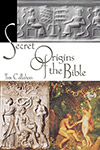 Secret Origins of the Bible
Secret Origins of the Bible
by Tim Callahan -
Why does so much material in the Bible seem repetitive and even contradictory? What is the evidence that Bible stories of the creation, the race of giants, the flood, and the tower of Babel were derived from earlier tales told by the Sumerians and pre-Israelite Semitic peoples? How does linguistic analysis of Biblical names reveal their original hidden meanings. Many intelligent and otherwise well informed readers will find much of the material in this book new and quite startling, although Bible scholars, and anyone with a background in comparative mythology will be familiar with it.
-
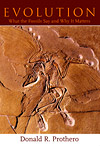 Evolution: What the Fossils Say
Evolution: What the Fossils Say
& Why it Matters
by Donald R. Prothero
Watch Dr. Kevin Dutton for free online,
broadcast live from Caltech!
New Admission Policy and Prices
Please note there are important policy and pricing changes for this season of lectures at Caltech. Please review these changes now.
SINCE 1992, the Skeptics Society has sponsored the Skeptics Distinguished Science Lecture Series at Caltech: a monthly lecture series at the California Institute of Technology in Pasadena, CA. Most lectures are available for purchase in audio & video formats. Watch several of our lectures for free online. Our next lecture is…

The Wisdom of Psychopaths: What Saints, Spies, and Serial Killers Can Teach Us About Success
Sunday, October 28, 2012 at 2 pm
Baxter Lecture Hall
University of Oxford research psychologist Dr. Kevin Dutton reveals that there is a scale of “madness” along which we all sit. Incorporating the latest advances in brain scanning and neuroscience, Dutton demonstrates that the brilliant neurosurgeon who lacks empathy has more in common with a Ted Bundy who kills for pleasure than we may wish to admit, and that a mugger in a dimly lit parking lot may well, in fact, have the same nerveless poise as a titan of industry. Dutton argues that there are “functional psychopaths” among us—different from their murderous counterparts—who use their detached, unflinching, and charismatic personalities to succeed in mainstream society, and that shockingly, in some fields, the more “psychopathic” people are, the more likely they are to succeed. Dutton deconstructs this often misunderstood diagnosis through bold on-the-ground reporting and original scientific research as he mingles with the criminally insane in a high-security ward, shares a drink with one of the world’s most successful con artists, and undergoes transcranial magnetic stimulation to discover firsthand exactly how it feels to see through the eyes of a psychopath.
Followed by…
- Dr. SEAN M. CARROLL
The Particle at the End of the Universe: How the Hunt for the Higgs Boson
Leads Us to the Edge of a New World
Sunday, November 18, 2012 at 2 pm
Baxter Lecture Hall
Chopra Asks Shermer: Who Are You?
Deepak Chopra interviews Michael Shermer as part of his “soul profiles” series. Some of the questions include:
- Who are you?
- Do you have a life purpose?
- Can you identify any peak experiences in your life?
- Who are your heroes?
- Do you believe in God?
- Do you have a soul?
- What does death mean to you?
- Are you a noun or a verb?
12-10-10
In this week’s eSkeptic:
Watch Dr. Kevin Dutton for free online,
broadcast live from Caltech!
New Admission Policy and Prices
Please note there are important policy and pricing changes for this season of lectures at Caltech. Please review these changes now.
SINCE 1992, the Skeptics Society has sponsored the Skeptics Distinguished Science Lecture Series at Caltech: a monthly lecture series at the California Institute of Technology in Pasadena, CA. Most lectures are available for purchase in audio & video formats. Watch several of our lectures for free online. Our next lecture is…

The Wisdom of Psychopaths: What Saints, Spies, and Serial Killers Can Teach Us About Success
Sunday, October 28, 2012 at 2 pm
Baxter Lecture Hall
University of Oxford research psychologist Dr. Kevin Dutton reveals that there is a scale of “madness” along which we all sit. Incorporating the latest advances in brain scanning and neuroscience, Dutton demonstrates that the brilliant neurosurgeon who lacks empathy has more in common with a Ted Bundy who kills for pleasure than we may wish to admit, and that a mugger in a dimly lit parking lot may well, in fact, have the same nerveless poise as a titan of industry. Dutton argues that there are “functional psychopaths” among us—different from their murderous counterparts—who use their detached, unflinching, and charismatic personalities to succeed in mainstream society, and that shockingly, in some fields, the more “psychopathic” people are, the more likely they are to succeed. Dutton deconstructs this often misunderstood diagnosis through bold on-the-ground reporting and original scientific research as he mingles with the criminally insane in a high-security ward, shares a drink with one of the world’s most successful con artists, and undergoes transcranial magnetic stimulation to discover firsthand exactly how it feels to see through the eyes of a psychopath.
Followed by…
- Dr. SEAN M. CARROLL
The Particle at the End of the Universe: How the Hunt for the Higgs Boson
Leads Us to the Edge of a New World
Sunday, November 18, 2012 at 2 pm
Baxter Lecture Hall
New in the Skeptic Reading Room
The Decline and (Probable) Fall
of the Scientology Empire!
by Jim Lippard
Jim Lippard reviews two books: Janet Reitman’s book Inside Scientology: The Story of America’s Most Secretive Religion (Houghton Mifflin Harcourt, 2011, ISBN 978-0618883028) and Hugh Urban’s The Church of Scientology: A History of a New Religion (Princeton University Press, 2011, ISBN 978-0691146089). This article was published in Skeptic magazine 17.1 in 2011. Read the complete article for free on skeptic.com!
About this week’s eSkeptic
In this week’s eSkeptic, Mike Moran reviews Brad Warner’s book Hardcore Zen Strikes Again (Cooperative Press, 2012, ISBN: 978-1937513078). Mike Moran is a Baltimore-based comedian, writer and musician. He performs standup comedy and improv acting with the Baltimore Improv Group, as well as co-hosts The Digression Sessions Podcast. Moran also writes a humor column for Patch North Baltimore and plays bass with local bands Polaroid Rage, Bronx on Benzedrine and Tremendous Athlete.
Share this article with friends online.
Click the + for more options.
Subscribe to Skeptic magazine for more great articles like this one, and if you enjoy reading them, consider making a tax-deductible donation to the Skeptics Society.

The Not-So-Skeptical Buddhist
a book review by Mike Moran
Brad Warner does not promise you enlightenment. He will not be opening your mind to any kind of psychic third eye. Want to find out from whom you have been reincarnated? Don’t ask Brad. His writings won’t even put you in that kind of blissful relaxed state other Zen books seem costum designed for.
For this Ohioan punk rocker, monster movie enthusiast and Soto Zen Priest, Buddhism is a simple “philosophy of action” done for the goal of achieving real world joy and existential clarity. His writings are an immensely readable mix of blunt honesty and down to Earth light-heartedness that make the admittedly boring practice of Zazen (sitting still) surprisingly alluring. Brad’s humorous Zen-tinged anecdotes and alternative pop culture references will appeal especially to ageing Generation Xers with the troublesome duality of skeptical minds and spiritual needs. You might say Brad Warner is the Chuck Klosterman of sitting quietly in the lotus position.
Brad’s latest offering, Hardcore Zen Strikes Again, is a collection of his first attempts at Buddhist writings, many from decade old (or more) blog posts. Somewhat different in tone than his last few releases where he focused more on the application of Zen to specific areas of life (sex, divorce, death in the family), Hardcore Zen Strikes Again has a refreshingly back-to-basics feel, reminding old readers and enlightening new ones on the hows and whys of Brad’s preferred brand of Buddhism called Zen Soto, a Buddhist sect based primarily around the 13th century teachings of Dogen Zengi.
The Buddhism vs. religion theme is prominent in Hardcore Zen Strikes Again; no big surprise, as much of the content originates from the years following 9/11. Early 2000s Brad is quick to make the distinction in the first chapter declaring “Religion is what got us into this mess (9/11 and the subsequent war) and I want no part of it” and, on page 70, “it’s stupid to go against science.” Though statements like these are fulfilling enough for the incredulous Buddhist, they also serve to highlight Brad’s oft-reiterated point: that Zen is all about making the best of reality and not to, as Brad points out in the chapter on Past Life Regression, “promote a dreamy fantasy state that distracts us from seeing what our life is right now.”
This spirit of realism and what-Buddhism-is-not, pervades the majority of Hardcore Zen Strikes Again. The book goes on to address most of the other usual suspects you would want to talk to a hip, plainspoken, Buddhist about. Some great quotes (that you would never find in other books in the Buddhist section) are dropped along the way:
On enlightenment: “The only real enlightenment is to realize you’re a complete phony.”
On reincarnation: “We die all the time. Every moment of everyday we die. Look at a picture of yourself when you were ten years old. Where is that person now?”
And On the “All is One” thing: “It takes a great deal of effort to sustain the illusion that you are something eternally separate from the rest of the universe.”
Hardcore Zen Strikes Again takes a sudden and awkward shift in tone in its final three chapters. Brad delves uncharacteristically into new agey pseudoscience in the chapter “The Whole Vegetarian Thing,” declaring that things like “meat makes a person feel more aggressive (because when animals are slaughtered they) tense up and…This highly agitated state is passed on to the person who eats the meat.” He even concedes hypocrisy for his vegetarianism as “cabbage, potatoes, and carrots are alive too…and there is considerable evidence that they have a kind of primitive survival instinct. Mmm-Hmm. The not-so-skeptical Buddhist appears here as well I’m afraid.
Chapter 15 feels off putting for different reasons as Brad discusses his views on writing, eventually veering off the subject of Buddhism completely. Though his tips will be enjoyable for writers (like me), most readers will find them as pointless as the final chapter that (and Brad acknowledges this) goes completely off course for a Zen-less discussion of the monster movie industry. Brad is a good enough writer to pull off non-Buddhist writings but these last three destinations aren’t exactly what was promised in the brochure.
“I find some of my early writings uncomfortable to read” admits modern-day Brad in the introduction to Hardcore Zen Strikes Again as, in keeping in the realism spirit of reincarnation merely being the natural changing in personality over the course of a life time, Brad critiques his younger self’s writings throughout the book.
Despite his misgivings and a questionable third act, 2012 Brad Warner can relax. If Hardcore Zen Strikes Again feels like a collection of old demo songs—as he suggests on page 59—it is still as engaging as any studio album, and is just a fine a place as any for new readers outside of Brad’s established fan base to jump into his catalog. ![]()
The Soul of Science, and Skeptic Swag…
-
 The Soul of Science
The Soul of Science
by Michael Shermer -
In this pocket mini-book, Michael Shermer asks, “Can we find spiritual meaning and purpose in a scientific worldview?” Spirituality is a way of being in the world, a sense of one’s place in the cosmos, a relationship to that which extends beyond ourselves. There are many sources of spirituality; religion may be the most common, but it is by no means the only. Anything that generates a sense of awe may be a source of spirituality. Science does this in spades. (NOTE: This is a pocket mini-book. 3.5 x 5.5 inches, 35 pages.)
-
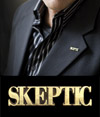 Skeptic Lapel Pin
Skeptic Lapel Pin
by The Skeptics Society
-
 Unisex Flex Fleece Zip Hoodies
Unisex Flex Fleece Zip Hoodies
by AMERICAN APPAREL
-
 Skeptic Bumper Sticker (11.5″ × 3″)
Skeptic Bumper Sticker (11.5″ × 3″)
by The Skeptics Society
Ancient Aliens Debunked
If you have seen the dreadful History Channel series on “Ancient Aliens,” in which any artifact whatsoever is twisted into “evidence” for visitation by extra-terrestrial intelligences in our ancient past, you’ve probably been wondering where the rebuttal is to all these claims. Well, thanks to the erstwhile efforts of skeptic and Christian Chris White, this video is a complete analysis that will give you all the ammo you need to respond to people who breathlessly proclaim that they saw this “documentary” on the History Channel that offers “proof” of alien visitation. You can say, “not so fast!” And then tell them what we actually know about ancient history and aliens (and the lack thereof). Video produced by Chris White. CONTINUE READING THIS POST…
TAGS: Ancient Aliens, ancient astronauts, Chris White, Dr. Michael Hesier, video, Zecharia SitchinThe Decline and (Probable) Fall
of the Scientology Empire!
Jim Lippard reviews two books: Janet Reitman’s book Inside Scientology: The Story of America’s Most Secretive Religion (Houghton Mifflin Harcourt, 2011, ISBN 978-0618883028) and Hugh Urban’s The Church of Scientology: A History of a New Religion (Princeton University Press, 2011, ISBN 978-0691146089). This article was published in Skeptic magazine 17.1 in 2011.
THERE WAS ONCE A MAN who considered himself an explorer, a military hero, a mystic, a philosopher, a nuclear physicist, and an expert in human nature. In fact, he was none of these things. He was an adventurer, a writer of pulp fiction, and a teller of tall tales. He was a college dropout, a bigamist, convicted of petty theft and fraud, and named as an unindicted co-conspirator in a plot to infiltrate and steal information from U.S. government agencies. Despite his unimpressive physique, he was a larger-than- life, charismatic figure who persuaded thousands of people to believe in and pay large sums of money to learn more about a view of the world he constructed from a foundation of pseudoscience, bad philosophy, science fiction, and space opera. He came to believe his own claims of developing the power to shape the world to his tastes and improve one’s physical and especially mental states through specific techniques he invented that precluded all psychiatric drugs, and yet he died alone with matted hair and rotting teeth, with the anti-anxiety drug Vistaril in his system.
He left behind a multi-million dollar global empire of organizations that continue to generate interest, money, and controversy, much as they did during his lifetime, and it transformed itself in various ways, from its start as a replacement for psychotherapy, to a new religion or “applied religious philosophy,” to a set of “technologies” to be marketed and sold for the purposes of education, business management, drug abuse treatment, reducing prisoner recidivism, and combatting abuses of psychiatry. After a short period of uncertainty after his death, another man assumed authority by systematically CONTINUE READING THIS POST…
TAGS: belief, Dianetics, Jim Lippard, L. Ron Hubbard, religion, Scientology12-10-03
In this week’s eSkeptic:
Watch Dr. Kevin Dutton for free online,
broadcast live from Caltech!
New Admission Policy and Prices
Please note there are important policy and pricing changes for this season of lectures at Caltech. Please review these changes now.
SINCE 1992, the Skeptics Society has sponsored the Skeptics Distinguished Science Lecture Series at Caltech: a monthly lecture series at the California Institute of Technology in Pasadena, CA. Most lectures are available for purchase in audio & video formats. Watch several of our lectures for free online. Our next lecture is…

The Wisdom of Psychopaths: What Saints, Spies, and Serial Killers Can Teach Us About Success
Sunday, October 28, 2012 at 2 pm
Baxter Lecture Hall
University of Oxford research psychologist Dr. Kevin Dutton reveals that there is a scale of “madness” along which we all sit. Incorporating the latest advances in brain scanning and neuroscience, Dutton demonstrates that the brilliant neurosurgeon who lacks empathy has more in common with a Ted Bundy who kills for pleasure than we may wish to admit, and that a mugger in a dimly lit parking lot may well, in fact, have the same nerveless poise as a titan of industry. Dutton argues that there are “functional psychopaths” among us—different from their murderous counterparts—who use their detached, unflinching, and charismatic personalities to succeed in mainstream society, and that shockingly, in some fields, the more “psychopathic” people are, the more likely they are to succeed. Dutton deconstructs this often misunderstood diagnosis through bold on-the-ground reporting and original scientific research as he mingles with the criminally insane in a high-security ward, shares a drink with one of the world’s most successful con artists, and undergoes transcranial magnetic stimulation to discover firsthand exactly how it feels to see through the eyes of a psychopath.
Followed by…
- Dr. SEAN M. CARROLL
The Particle at the End of the Universe: How the Hunt for the Higgs Boson
Leads Us to the Edge of a New World
Sunday, November 18, 2012 at 2 pm
Baxter Lecture Hall

NEW ON MICHAELSHERMER.COM
Politically Irrational: Subliminal Influences
Guide Our Voting Preferences
Why are we so influenced by such apparently trivial characteristics as voice and looks? In Michael Shermer’s October ‘Skeptic’ column for Scientific American, he discusses such cognitive shortcuts and subliminal influences.

NEW ON SKEPTICBLOG.ORG
Carl Sagan’s Crazy Train
Daniel Loxton considers a few of the thorny ethical issues at the intersection of scientific skepticism and mental health.

Sexual Brain Science
SKEPTICALITY EPISODE 192
This week on Skepticality, Derek first sits down with Dr. Ginger Campbell to chat about her new book, Are You Sure? The Unconscious Origins of Certainty, to find out more about why it is difficult for any of us to be certain about many things. Then, Derek has a discussion with Joanne Hanks, the author of “It’s Not About The Sex” My Ass, about her journey deep into the world of fundamentalist Mormomism, and her move to becoming a skeptic and critical thinker.
Get the Skepticality Podcast App
for Apple and Android Devices!
Get the Skepticality App — the Official Podcast App of Skeptic Magazine and the Skeptics Society, so you can enjoy your science fix and engaging interviews on the go! Available for Android, iPhone, iPad, and iPod Touch. Skepticality was the 2007 Parsec Award winner for Best “Speculative Fiction News” Podcast.
About this week’s eSkeptic
In this week’s eSkeptic, Donald R. Prothero reviews Rudolf A. Raff’s Once We All Had Gills: Growing Up Evolutionist in an Evolving World (Indiana University Press, 2012, ISBN 978-0253002358). Read Prothero’s bio after the article.

Foundation of a Founder of Evo-Devo
a book review by Donald R. Prothero
Autobiography is a popular genre in the publishing industry, but most are accounts of famous actors or politicians or other public figures. There are relatively few good examples of autobiographic accounts by important scientists (both past and present). Most scientists tend not to write autobiographical accounts of themselves, whether it be because they are too modest, too busy, or whether the ego-denying, self-effacing scientific culture which suppresses the first-person pronouns and the active voice (“the experiment was conducted by so-and-so’s lab”) makes us less than willing to talk about ourselves.
When an autobiographical account of a prominent scientist appears, it gives us important insights into the questions of how great scientists are made, as well as how they made their discoveries. Reading Darwin’s autobiography (even if he did modify some details) has been an important source regarding events and ideas led to his discovery of evolution by natural selection. Feynman’s autobiographical books (especially Surely You’re Joking, Mr. Feynman!) are laugh-out-loud funny as this brilliant misfit gives us his quirky view of the world, amazing his professors and colleagues, and playing tricks on Army security when he was working on the Atom Bomb in Los Alamos. E.O. Wilson’s autobiography Naturalist shows how his childhood love of collecting bugs in Alabama blossomed not only into a career as a world famous ant expert, but also to his insights about ecological biogeography and sociobiology. For historians of science, as well as people who want to understand what makes a great scientist, such rare first-person accounts are highly valuable.
Into this tradition comes Rudy Raff’s Once We All Had Gills: Growing Up Evolutionist in an Evolving World. For those who don’t recognize the name, Raff has been one of the leading figures in the fields of embryology, developmental biology, and their connection to evolution for the past 50 years. Spending most of his career at Indiana University in Bloomington, Raff made it into a center for research of the exploding field of evolutionary development (“evo-devo”), one of the hottest and fastest-growing areas in all of science. He is currently the James H. Rudy Professor of Biology at Indiana, Director of the Indiana Molecular Biology Institute, editor of the journal Evolution & Development, and also a Guggenheim Fellow, a Fellow of the American Association for the Advancement of Science (AAAS), and winner of the 2004 Sewall Wright award. He is the author of many books, including three classics that laid the modern foundation for evo-devo. More importantly, Raff entered the field of evolutionary biology when it had become the neglected discipline of evolutionary theory, overshadowed by fruit-fly genetics during the birth of the Neo-Darwinian synthesis during the 1940s and 1950s. Due to the efforts of Raff and just a few others, embryology emerged from decades of being on the sidelines to become the cutting-edge field of science. Now the steady drumbeat of new discoveries about regulatory genes, homeoboxes, and many other major breakthroughs overshadow just about any other branch of biology.
Like many other scientists, Raff’s roots were affected by one of the key events in the history of science: Hitler’s persecution of Jewish scientists and other intellectuals, leading many of them (including Albert Einstein, Max Born, Hans Krebs, Erwin Schrödinger, Edward Teller, Hans Bethe, Enrico Fermi, Max Perutz, and many others) to flee to other countries. Germany was the leading scientific power of the early 20th century, with the most Nobel Prizes in science, but that status was reversed by a huge “brain drain” triggered by Hitler’s actions. Raff’s father, Rudolf August Victor Raff, had a doctorate in chemistry from the University of Vienna, but fled Austria in 1938 as the Anschluss loomed. He emigrated to Quebec, Canada, because he spoke better French than English, and got a temporary job with a Canadian chemical company. There he met a French-Canadian doctor’s daughter, Therese Dufresne, and they were married in 1939, which saved the Austrian refugee from being interned during the war.
The author describes his early childhood among his Dufresne relatives on Lac Souris near Shawinigan, Quebec, where he was a young child in the 1940s. He recalls at length his explorations of nature around the lake country of northern Quebec, where he acquired his love of natural history and a curiosity about animals and plants that never left him. Then in 1949 his father got a job at a chemical company in Pittsburgh, and young Rudy became enamored of the amazing dinosaur halls at the Carnegie Museum of Natural History, where he got to hang out in the halls and mingle with the curators. Meanwhile, he was pursuing a serious interest in natural history in western Pennsylvania, especially focusing on salamanders, spiders, and dragonflies, as well as collecting fossils in the region. He finished a major in chemistry at Penn State (B.A., 1963), then on to Duke where he got his doctorate in Biochemistry in 1967. He also met his wife Beth at Penn State during a visit there on break from Duke, and they were married in 1965. Raff recounts some of his many scientific expeditions to discover new species of animals, especially in Chiapas, Mexico, and makes it clear that he is more than a lab scientist, but a true naturalist.
In the late 1960s, Raff began doing post-doctoral work on sea urchin embryos in Paul Gross’ lab at MIT, where he was to make groundbreaking discoveries about development and embryos. In 1971, he was hired at Indiana, which was already a cutting-edge institution in molecular biology at that time. Over the following 40 years, his lab was at the center of the “evo-devo” revolution. Many of his former grad students and post-docs are now prominent scientists in their own right, carrying on the latest research. Raff himself not only participated in this research, but wrote three very influential books that summarized the understanding of development and evolution at the time they were written. These books introduced many generations of biologists to the importance of development and epigenetic change in evolution.
Throughout his lively account of his field exploits as a naturalist, and his lab discoveries as an embryologist, Raff also maintains a narrative of the political background that framed his career, from his early days as a child in Quebec during World War II to growing up in the U.S. during in the Cold War (he even did a short stint in the military, but they used his talents in radiation biology), to living in Cambridge during the height of the student revolt of the late 1960s. But the main underlying theme of the book is evolution, and Raff’s long career documenting how it occurs. Even though his primary training was in molecular biology, he maintained his interest in fossils, and often participated in important paleontological discoveries, or integrated their implications into his own research. His final chapters discuss the problem of American creationism, and its damaging effects on American science education and culture in general. In his own passionate way, he recounts the development of creationism, the events leading up to the 2005 Dover “intelligent design” trial, and then debunks many of the standard creationist arguments in his own unique way. Like many of my fellow scientific colleagues, it is a great mystery and a distressing fact to him that the myths of primitive Bronze Age shepherds can still retard scientific advances in a country that still leads the world in many areas of science—but almost 50% of its own population believes pure nonsense. His final chapter, “Evolution Matters,” is a rousing call to arms for scientists and educated Americans to stand up against the forces of creationism and science denialism, and not allow the United States to slide backwards and become a scientific backwater, as Hitler did to Germany in the 1930s.
The book has a wonderful cover painting of the “fishibian” Acanthostega climbing out of the water (painted by Raul Martin), which reminds us of the title: Once we all had gills. As biologists know, that title has two levels of meaning. Not only are we descended from gilled amphibians like Acanthostega and even earlier fish-like ancestors, but as embryos, we all had gill slits about 5 weeks after conception that we eventually lost. Both are pieces of our evolutionary past that remind us how important evolution is to understanding our origins.
Raff’s book is thus both a fascinating story of how a young boy interested in natural history became a scientist at the founding of the “evo-devo” revolution, and also a polemic arguing about the importance of science and its defense against the powers of ignorance. It is a lively read, no matter how much background you might have in biology, and I highly recommend it to anyone interested in these topics, as well as those interested in scientific biography. ![]()
About the Author of this Review
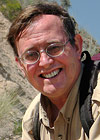
DR. DONALD R. PROTHERO was Professor of Geology at Occidental College in Los Angeles, and Lecturer in Geobiology at the California Institute of Technology in Pasadena. He earned M.A., M.Phil., and Ph.D. degrees in geological sciences from Columbia University in 1982, and a B.A. in geology and biology (highest honors, Phi Beta Kappa) from the University of California, Riverside. He is currently the author, co-author, editor, or co-editor of 32 books and over 250 scientific papers, including five leading geology textbooks and five trade books as well as edited symposium volumes and other technical works. He is on the editorial board of Skeptic magazine, and in the past has served as an associate or technical editor for Geology, Paleobiology and Journal of Paleontology. He is a Fellow of the Geological Society of America, the Paleontological Society, and the Linnaean Society of London, and has also received fellowships from the Guggenheim Foundation and the National Science Foundation. He has served as the President and Vice President of the Pacific Section of SEPM (Society of Sedimentary Geology), and five years as the Program Chair for the Society of Vertebrate Paleontology. In 1991, he received the Schuchert Award of the Paleontological Society for the outstanding paleontologist under the age of 40. He has also been featured on several television documentaries, including episodes of Paleoworld (BBC), Prehistoric Monsters Revealed (History Channel), Entelodon and Hyaenodon (National Geographic Channel) and Walking with Prehistoric Beasts (BBC). His website is: www.donaldprothero.com. Check out Donald Prothero’s page at Shop Skeptic.
Recommended reading on evolution…
-
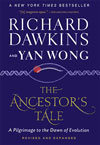 The Ancestor’s Tale
The Ancestor’s Tale
by Richard Dawkins -
With unparalleled wit, clarity, and intelligence, Richard Dawkins, one of the world’s most renowned evolutionary biologists, has introduced countless readers to the wonders of science. In this book, Dawkins offers a masterwork: an exhilarating reverse tour through evolution, from present-day humans back to the microbial beginnings of life four billion years ago. Throughout the journey Dawkins spins entertaining, insightful stories and sheds light on topics such as speciation, sexual selection, and extinction. The Ancestor’s Tale is at once an essential education in evolutionary theory and a riveting read…
-
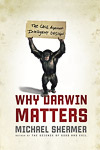 Why Darwin Matters
Why Darwin Matters
by Michael Shermer
-
 Evolution: What the Fossils Say
Evolution: What the Fossils Say
and Why it Matters
by Dr. Donald Prothero
-
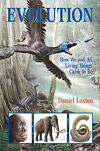 Evolution: How We and All Living Things Came to Be
Evolution: How We and All Living Things Came to Be
by Daniel Loxton
-
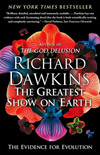 The Greatest Show on Earth
The Greatest Show on Earth
by Richard Dawkins
Moral Origins: The Evolution of Virtue,
Altruism, and Shame
Altruism, and Shame
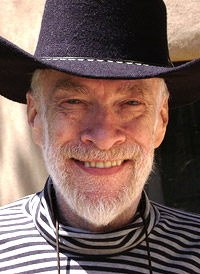
IF THE HUMAN INSTINCT to survive and reproduce is “selfish,” why do people engage in self-sacrifice, and even develop ideas like virtue and shame to justify that altruism? Many theories have been put forth, some emphasizing the role of nepotism, others emphasizing the advantages of reciprocation or group selection effects. Evolutionary anthropologist Christopher Boehm offers an elegant new theory. Tracing the development of altruism and group social control over 6 million years, Boehm argues that our moral sense is a sophisticated defense mechanism that enables individuals to survive and thrive in groups. One of the biggest risks of group living is the possibility of being punished for our misdeeds by those around us. Bullies, thieves, free-riders, and especially psychopaths are the most likely to suffer this fate. Getting by requires getting along, and this social type of selection, Boehm shows, singles out altruists for survival. This selection pressure has been unique in shaping human nature, and it bred the first stirrings of conscience in the human species. Dr. Boehm offers profound insight into humanity’s moral past—and how it might shape our moral future.
TAGS: altruism, Christopher Boehm, group social control, morality12-09-26
In this week’s eSkeptic:
Watch our next lecture for free online,
broadcast live from Caltech!
New Admission Policy and Prices
Please note there are important policy and pricing changes for this season of lectures at Caltech. Please review these changes now.
SINCE 1992, the Skeptics Society has sponsored the Skeptics Distinguished Science Lecture Series at Caltech: a monthly lecture series at the California Institute of Technology in Pasadena, CA. Most lectures are available for purchase in audio & video formats. Watch several of our lectures for free online. Our next lecture is…

Moral Origins: The Evolution of Virtue, Altruism, and Shame
Sunday, September 30, 2012 at 2 pm
Baxter Lecture Hall
If the human instinct to survive and reproduce is “selfish,” why do people engage in self-sacrifice, and even develop ideas like virtue and shame to justify that altruism? Many theories have been put forth, some emphasizing the role of nepotism, others emphasizing the advantages of reciprocation or group selection effects. Evolutionary anthropologist Christopher Boehm offers an elegant new theory. Tracing the development of altruism and group social control over 6 million years, Boehm argues that our moral sense is a sophisticated defense mechanism that enables individuals to survive and thrive in groups. One of the biggest risks of group living is the possibility of being punished for our misdeeds by those around us. Bullies, thieves, free-riders, and especially psychopaths are the most likely to suffer this fate. Getting by requires getting along, and this social type of selection, Boehm shows, singles out altruists for survival. This selection pressure has been unique in shaping human nature, and it bred the first stirrings of conscience in the human species. Dr. Boehm offers profound insight into humanity’s moral past—and how it might shape our moral future.
Followed by…
- DR. KEVIN DUTTON
The Wisdom of Psychopaths: What Saints, Spies, and Serial Killers
Can Teach Us About Success
Sunday, October 28, 2012 at 2 pm
Baxter Lecture Hall

NEW ON SKEPTICBLOG.ORG
What is a “Fair Share” in Paying Taxes, Anyway?
In this week’s Skepticblog, Michael Shermer comments on Mitt Romney’s taxes and asks is it “fair” that Mitt had to pay two orders of magnitude more in tax dollars than he did in 2011, or is it fair that Shermer had to pay double the percentage of income that Mitt paid? It all boils down to what we mean by “fair” when it comes to taxes, and that in turn depends on what we want as a society: equality of opportunity or equality of outcome?
The Latest Episode of Mr. Deity: Mr. Deity and The Signs (Part Deux)
WATCH THIS EPISODE | DONATE | NEWSLETTER | FACEBOOK | MrDeity.com
About this week’s eSkeptic
In this week’s eSkeptic, Frank Miele reviews The Last Myth: What the Rise of Apocalyptic Thinking Tells Us About America by Mathew Barrett Gross and Mel Giles (Prometheus Books, 2012, ISBN 978-1616145736).
Senior Editor Frank Miele brings his diverse talents as a researcher, technical writer, teacher, stand-up comic, and musician to Skeptic magazine and Skeptics Society events. He has interviewed many of the major figures in debates over IQ, evolutionary psychology, overpopulation, global warming, and the environment, and other hot topics that may be found on the websites for Skeptic, Human Behavior and Evolutionary Society, and others.

The Devil’s Finest Trick,
The Human Mind’s Worst
a book review by Frank Miele
“La plus belle des ruses du diable est de vous persuader qu’il n’existe pas.”
Charles Baudelaire was a major innovator in French literature (among those he influenced, fellow poets Mallarmé, Verlaine, Rimbaud, composer Claude Debussy)—and the higher artistic regard given the works of Edgar Allan Poe in his country than in Poe’s may in large part be due to Baudelaire’s translations. (As may also be true for those of K. D. Balmont and V. Y. Bryusov in Tsarist Russia). A contemporary, colloquial translation of his above bòn mót was used most memorably in the cult classic neo-noire film, The Usual Suspects.
Baudelaire and Keyser Söze (ranked #48 on the American Film Industries list of all-time movie villains) notwithstanding, the devil’s greatest trick may be to convince us that he does exist. Because if he does, he certainly can’t be us or what we believe in. Therefore he must be some other person, group, nation, or belief. And since it’s the devil we’re after, no ways or means can be spared in routing him out and keeping him caged until the apocalyptic “final showdown” when Ultimate Good gives Ultimate Evil its final Smack Down.
The point to be made is that without some form of existential (d)evil, existential fear of an apocalypse is at a minimum diminished and at maximum rendered meaningless. But if accepted, apocalypticism can be downright dangerous. And that’s the take home lesson and significant contribution of The Last Myth. Authors Gross and Giles entertainingly and informatively, if at times breezily, explain why what they term “apocalyptic thinking,” which they define as “a pattern of thought that assumes that end of our way of life (if not physically the end of the world itself) is imminent” (pp. 11–12) has undermined “our ability to gauge the magnitude of the global challenges rushing towards us” (p. 28). In supporting their thesis, they document that “apocalypticism” is neither “built into the human brain,” nor has it been present always and everywhere, and that even where well rooted (notably the United States from the outset) it has waxed and waned depending on other factors.
In making their case, the authors compare and contrast the optimistic decade of the 1990s, kicked off and epitomized by Francis Fukuyama’s 1989 article, “The End of History,” which argued that with the fall of Soviet communism all political questions had been solved and so liberal democracy would reign peacefully throughout the world, with what they term, “The Apocalyptic Decade” which exploded from lower Manhattan to worldwide cable TV news on September 11, 2001 and, in the minds of many, will end in a worldwide catastrophe at the end of the Mayan long cycle on December 21, 2012 or thereabouts. (They review the evidence, also covered in Skeptic magazine 15.2, that this is a misinterpretation of the Mayan “long cycle”; my own favorite hypothesis is that MesoAmericans simply ran out of stone.)
Among the most interesting items covered in The Last Myth is Todd Strandberg’s Rapture Index. An Air Force retiree and born-again Christian, Strandberg developed the Index in the 1980s, not to specify when the Rapture is coming, since “no man knows the day or the hour” (Matthew 24:36) and an endless string of pseudo-exegetes have turned out to be super-stupid trying, but what is the trajectory of events portending the Tribulation (“the tumultuous days prophesied in the Bible that would precede the return of Christ”). Is it accelerating, decelerating, or remaining the same?
And what really are the signs of the end times? Among those considered for the Rapture Index are such obvious markers straight out of the of the Book of Revelation: False Christs, the Occult, Satanism, Apostasy, False Prophets, Gog (read Russia), Persia (read Iran), the Kings of the East, the Mark of the Beast, Beast Government, and, of course, The Antichrist, as well as Anti-Semitism and Israel (though these had somewhat different valence and interpretation among Bible Belters not that long ago); but also some more often associated with the Wall Street Journal such as Unemployment, Inflation, Interest Rates, and Oil Price; or the Weather Channel such as: Volcanoes, Earthquakes, “Wild Weather,” Famine, Drought, Climate, and Floods.
Giles and Gross note that Strandberg became frustrated because the various apocalyptic timekeepers gave “wild and wildly varying interpretations…to the daily news” and couldn’t even agree whether “earthquakes were increasing or decreasing in frequency.” They note his consternation upon realizing that, “If people can’t even count something as simple as tectonic movements of the earth, what yardstick would they possibly use to measure something like apostasy?” (pp. 29, 217, n. 14).
For all its virtues, the authors of The Last Myth fall victim to the very sort of thinking they warn against, perhaps understandably so given that, like all authors, they want to sell their book. They too easily divide time periods (decades, even centuries), authors, and worldviews into neat, little pigeonholes of Apocalypticism versus Pragmatism. In discussing Francis Fukuyama and his landmark article, ‘the End of History’ they write, “it’s important to remember the earnestness of the delusion that we had escaped history—a delusion that spread from Washington to the NASDAQ to the Top 40 charts—for it represents the starting point in our bipolar shift in consciousness toward apocalyptic despair. Our exuberant optimism would soon boomerang back at us. From the highest hopes come the deepest disappointments” (p.23). Then they go on that, “Indeed, Y2K established the tone for the decade to follow” (p. 28).
No. Widespread apocalypticism did not undermine the greater society’s ability to gauge the magnitude of that “oncoming challenge.” It’s true that media evangelists did churn out booklets with titles like Y2K = 666? (note the escape hatch question mark) which implied that a worldwide crash of communications and computer systems could be the start of the end, and they made real money selling them to their believers. But at the same time real businesses, from Fortune 500 corporations down, with real interests made the necessary changes to software and documentation that prevented even the slightest glitch—and many of us in IT made real money implementing them.
Further, in the interests of being evenhanded, Gross and Gilles stretch their hands a bit too far. They criticize not only the Doomsday Sayers of the Religious Right, but also Nobel Laureate and former Vice President Al Gore and Jared Diamond for their works on climate change and ecology. Nor is sufficient attention given to the demographics of Apocalypticism. What are the age, race, religious, educational, sexual, political, and marital characteristics of those who believe versus those that do not.
With those reservations, however, The Last Myth is still worth reading, especially for those wanting to begin taking a skeptical look at a subject that fully deserves one. ![]()
Skeptical perspectives on the end of the world…
-
 A History of the End of the World: How the Most Controversial Book in the Bible Changed the Course of Western Civilization
A History of the End of the World: How the Most Controversial Book in the Bible Changed the Course of Western Civilization
by Jonathan Kirsch -
The question of how and when the world will end has captivated thinkers for centuries. In this lecture, Kirsch takes viewers on a 2,000-year journey and shows how churches, philosophers, clergy and armchair interpreters have promoted their political, social and religious agendas based on their belief that the end was imminent…
-
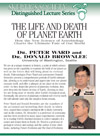 The Astrobiology and the Life and Death
The Astrobiology and the Life and Death
of Planet Earth
by Dr. Peter Ward and Dr. Donald Brownlee
12-09-19
In this week’s eSkeptic:
Our Next Lecture at Caltech
New Admission Policy and Prices
Please note there are important policy and pricing changes for this season of lectures at Caltech. Please review these changes now.
SINCE 1992, the Skeptics Society has sponsored the Skeptics Distinguished Science Lecture Series at Caltech: a monthly lecture series at the California Institute of Technology in Pasadena, CA. Most lectures are available for purchase in audio & video formats. Watch several of our lectures for free online. Our next lecture is…

Moral Origins: The Evolution of Virtue, Altruism, and Shame
Sunday, September 30, 2012 at 2 pm
Baxter Lecture Hall
If the human instinct to survive and reproduce is “selfish,” why do people engage in self-sacrifice, and even develop ideas like virtue and shame to justify that altruism? Many theories have been put forth, some emphasizing the role of nepotism, others emphasizing the advantages of reciprocation or group selection effects. Evolutionary anthropologist Christopher Boehm offers an elegant new theory. Tracing the development of altruism and group social control over 6 million years, Boehm argues that our moral sense is a sophisticated defense mechanism that enables individuals to survive and thrive in groups. One of the biggest risks of group living is the possibility of being punished for our misdeeds by those around us. Bullies, thieves, free-riders, and especially psychopaths are the most likely to suffer this fate. Getting by requires getting along, and this social type of selection, Boehm shows, singles out altruists for survival. This selection pressure has been unique in shaping human nature, and it bred the first stirrings of conscience in the human species. Dr. Boehm offers profound insight into humanity’s moral past—and how it might shape our moral future.
Followed by…
- DR. KEVIN DUTTON
The Wisdom of Psychopaths: What Saints, Spies, and Serial Killers
Can Teach Us About Success
Sunday, October 28, 2012 at 2 pm
Baxter Lecture Hall

NEW ON SKEPTICBLOG.ORG
Why I’m Still Working on Ankylosaur Attack
a Year After Publication
Daniel Loxton describes a factual error in his children’s paleofiction book Ankylosaur Attack—and the unusual step he has taken to fix it a year after publication. Order a copy of the book from Shop Skeptic.

Attracting a Mix: Skeptics and Believers
SKEPTICALITY EPISODE 191

This week on Skepticality, Derek presents another recording from the 2012 Skeptrack Panel at Dragon*Con on the topic of “Attracting a Mix: Skeptics and Believers,” featuring Sharon Hill, Tim Farley, and Nicole Gugliucci. Panelists discuss how to tailor your message so it may attract people from the widest range of world views for the greatest potential good.
Get the Skepticality Podcast App
for Apple and Android Devices!
Get the Skepticality App — the Official Podcast App of Skeptic Magazine and the Skeptics Society, so you can enjoy your science fix and engaging interviews on the go! Available for Android, iPhone, iPad, and iPod Touch. Skepticality was the 2007 Parsec Award winner for Best “Speculative Fiction News” Podcast.
About this week’s eSkeptic
In this week’s eSkeptic, Kevin J. McCaffree reviews Matthew Hutson’s new book The Seven Laws of Magical Thinking: How Irrational Beliefs Keep Us Happy, Healthy and Sane (Hudson Street Press, 2012, ISBN 978-1594630873).
Kevin McCaffree is a doctoral student at the University of California Riverside. He has thus far co-published an extensive interdisciplinary and cross-cultural review of the literature on alcohol and human experience, along with two articles, co-authored with Robert Nash Parker, which have appeared in the journal Drug and Alcohol Review. He has most recently published a book detailing the relationship between alcohol and human violence in a variety of contexts, co-authored with Robert Nash Parker and published by Rowman and Littlefield. He is currently working on a dissertation that provides a perception-based theory of the cultural evolution of morality across various technological and scientific stages of society.

Is Magical Thinking Good?
a book review by Kevin J. McCaffree
Matthew Hutson sets high goals for himself in his book, The Seven Laws of Magical Thinking. His mission, stated in the introduction, is to convince readers that even the most skeptical among us are, at base, subject to magical thinking and that this very process is both necessary and beneficial for navigating life. Such an argument would be difficult for any smart science writer to make, especially one not openly writing a work of apologetics—Hutson is an unabashedly committed naturalist. Though he sets for himself an upward climb, Hutson’s wit and incisive research is, for the most part, up to the difficult task.
Hutson defines “magical thinking” as the process of confusing objectivity and subjectivity, blurring properties of mind (intentions, desires) with properties of the material and physical world. He borrows late 19th and early 20th century anthropologist James George Frazer’s categorization of magical thought to organize his own examples. Frazer divided “magical” thought into two forms, contagion and similarity. Frazer’s “law of contagion” was meant to denote empirical regularities in how people view material objects. He noted that people often infuse such objects with characteristics or essences usually reserved for human beings, based on the proximity of those objects with certain people. To illustrate the law of contagion, Hutson describes the cross-country tour of John Lennon’s personal piano and the profound emotional experience fans describe after spending some time with it. Sure, it’s just a piano, but it is also the piano on which “Imagine” was composed. From a magical thinking perspective, Lennon’s spirit was so contagious that his own piano was a lucky beneficiary. For countless fans, a real part of who Lennon was now lives on in the form of a piano.
Hutson also makes use of Frazer’s “law of similarity,” which describes the human tendency to assume that like causes like. This helps, in large part, to explain why nations of people tend to get flustered at the thought of their flag being burned. Sure, it is just a flaming lump of nylon and polyester. Yet, flags are also symbolic of an entire country of human beings. It isn’t the burning of the flag that engenders hostility, it’s the implicit attempt to burn the people which the flag represents—like causes like. There is, as with all biases in psychology, a social dimension to this magical thinking as well. The same quirk that produces your hesitation in eating a French fry off the floor (dirty floors cause dirty French fries) also produces the most agonizing and asinine disregard for those who suffer most in society (dire, dirty living conditions cause impure, dirty people).
The book subsequently expands on the “laws” of contagion and similarity to explore other forms of magical thinking. Indeed, Hutson does not present seven “laws” as such; rather, he describes five subsequently overlapping forms or manifestations of the laws of contagion and similarity. Nowhere in the book are seven “laws” listed or summarized; most of the book after the first two chapters is a litany of examples of magical thinking, organized by type and categorized based on their kinship to the laws of similarity and contagion. Chapters thus cover superstitious thinking (which piggybacks on the law of similarity—whistling is said to encourage storms, probably because breath is equated with wind), mind/body dualism (the general tendency to view the material brain as an immaterial “mind”), immortality and reincarnation (viewing a material body as comprised of an immaterial essence), anthropomorphism (law of similarity) and karma (law of similarity—good brings good, bad brings bad).
Hutson does more than just discuss these various topics; an unusually good case is made for the general benefits of magical thinking. A particularly shining example is that of “metaphor therapy,” or therapy that uses symbolic ritual actions to aid people in major life transitions and decisions. Suppose you’ve just been the victim of a particularly bad breakup (or loss of a family member) and you’re finding it difficult to move on. Metaphor therapy might recommend taking a small token of your affection for that person, meditating over it and spending a day driving to your favorite beach (let’s say) and solemnly burying said memento in the sand. This ritualistic activity actually rides on the coattails of magical thinking and, Hutson suggests, can actually improve our lives. Burying that small token of affection in the sand might not have any logical purpose, but it speaks to our magical mind. Through the law of contagion, that memento still harbors the essences and intricacies of a now lost relationship. Ceremoniously burying the object might well signify, in a deeply emotional sense, the positive side of beginning a new life without that essence.
In general, the book is well-researched, up-to-date and highly accessible for those who are new to this subject matter. Unfortunately, his “seven laws” are more accurately characterized as a largely undifferentiated, yet colorful, lump of psychological biases. Nevertheless, in the hands of a writer as accessible as Hutson, it is easy to overlook these more general organizational and theoretical issues.
I submit, however, that writing a book about cognitive biases and showing that they increase self-esteem and confidence is still a long way from showing that magical thought is both necessary and beneficial. In my estimation, Hutson falls short for not taking more of an interest in the long-term consequences of believing falsities about reality. I have no doubt that believing falsities in the short term might well raise your sense of control over your environment. Yet, what will the consequences of that sense of control be? Will you write the great American novel with the help of your newfound ability to magnetize ideas to yourself? Or will you just end up confidently wasting your hard earned cash on New Age crystals and candles? At the end of the day, a simple boost in confidence won’t tell us—we must know something more about our life trajectory, goals and intentions. A self-confident Hitler is a qualitatively different case from a self-confident Nelson Mandela. It is not clear to me that Hutson has made a case that systematically believing false things is beneficial, on balance, in the modern world.
Perhaps most people, much of the time, think in a way that might be loosely categorized as “magical.” Yet key to Hutson’s argument is that all of us—atheist, skeptic and evangelical alike—possess magical beliefs. In an effort to show that everyone (yes, everyone) believes in magic, Hutson relays an anecdote about Richard Dawkins, wherein the famed atheist fawns over an early edition of Darwin’s classic work On the Origin of Species because, “this is the most precious book in my collection.” Because Dawkins is imbuing a bound collection of paper with some measure of sacredness, he is, in Hutson’s view, thinking magically. Yet, Dawkins knows that his copy of On the Origin of Species isn’t actually special or unique. The book is simply symbolic of something that is—the ideas behind evolution by natural selection. I seriously doubt that Dawkins would fail to see this distinction. Not everyone can see it or does see it, though. Indeed, perhaps most people in possession of a book they consider special, magical or sacred really believe the book is special, magic or sacred in some supernatural sense—consider the attitudes of millions towards their holy books.
The difference and the distinction to make here is whether or not people have a dispassionate, third order belief about the behavior in which they are engaging. Dawkins probably feels enchanted and awed in the presence of an early edition of Darwin’s book. He may even feel that he is in the presence of the sacred. Yet, he also is capable, as a function of his education and erudition, of seeing his actions as subjective and overdrawn, a simple consequence of our near-instinctual emotional lunging towards that which we value. Dawkins understands the mind and how it works, so when he indulges a bit of syrupy, foggy sacredness, he understands dispassionately, on a fundamental level, what he is doing. This level of understanding isn’t available to everyone and it therefore marks a deep conceptual difficulty with the simple argument that, “everyone thinks magically.” Some people think of magical thought as an open invitation to unrestrained supernatural indulgence while others think of magical thought as a subjectively enjoyable cognitive illusion with numerous undesirable side effects. This difference isn’t trivial and it isn’t addressed by Hutson.
All told, Matthew Hutson has produced a well-written, and well-researched book with an extremely difficult mission: to show the irrational to be beneficial and the beneficial to be, at least in some respects, irrational. Further, he wants to convince you that even the most skeptical among us is a magical thinker. While I appreciated the review of the literature he provides, and I enjoyed his voice as a writer, my mind remains unchanged. Hutson remarks towards the end of the book that his desire in writing it was to, “unite my allegiance to critical thinking with my celebration of enchantment.” Unfortunately, Hutson’s definition of “enchantment” is inappropriately broad enough to include both a beautiful sunset and the scientifically false assertions of New Age gurus. Because both sunsets and psychics can be loosely understood as “enchanting” or “magical,” they must both be valuable aspects of subjective human experience, right? Not as far as I can see.
Skeptical perspectives on magical thinking, self-deception, and the psychology of superstitious belief…
-
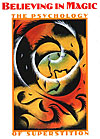 Believing In Magic:
Believing In Magic:
The Psychology of Superstition
by Stuart A. Vyse -
Examines current behavioral research which suggests that everyday superstitions are the natural result of well-understood psychological processes. Vyse entertainingly demonstrates how complex and paradoxical human behaviors can be understood through science. A significant contribution.
-
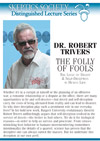 The Folly of Fools: The Logic of Deceit and Self-Deception in Human Life
The Folly of Fools: The Logic of Deceit and Self-Deception in Human Life
by Robert Trivers -
Deceit and self-deception carry the costs of being alienated from reality and can lead to disaster. So why does deception play such a prominent role in our everyday lives? Trivers unflinchingly argues that self-deception evolved in the service of deceit—the better to fool others. We do it for biological reasons—in order to help us survive and procreate. From viruses mimicking host behavior to humans misremembering (sometimes intentionally) the details of a quarrel, science has proven that the deceptive one can always outwit the masses. But, he warns, we undertake this deception at our own peril…
-
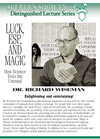 Luck, ESP & Magic:
Luck, ESP & Magic:
How Science Tests the Unusual
by Dr. Richard Wiseman -
Dr. Wiseman has established an international reputation for research into the scientific examination of unusual areas within psychology. His lecture will cover these many interests, including: the Luck Project, lying and lie detection, the psychology of magic, eyewitness testimony, the psychology of the paranormal, and experimenter bias in ESP research…
Born Together, Reared Apart:
The Landmark Minnesota Twin Study
The Landmark Minnesota Twin Study

“The Minnesota Study of Twins Reared Apart” startled scientists by demonstrating that twins reared apart are as alike, across a number of personality traits and other measures, as those raised together, suggesting that genetic influence is pervasive. Dr. Nancy Segal, a professor in the Department of Psychology at California State University, Fullerton, and the director of the Twin Studies Center, offers an overview of the study’s scientific contributions and effect on public consciousness. Dr. Segal is an associate editor of Twin Research and Human Genetics, the official journal of the International Society for Twin Studies.
TAGS: genetics, Minnesota Study of Twins Reared Apart, Nancy Segal, twins12-09-12
In this week’s eSkeptic:
- Lecture at Caltech this Sunday: Dr. Nancy Segal on Twins
- Follow Michael Shermer: The Hidden Price of Immoral Acts
- Follow Daniel Loxton: Echoing the Past
- Skepticality: Stealth Skepticism: Skeptrack at Dragon*Con Recap
- MonsterTalk: Yokai Attack! The Japanese Monster Survival Guide
- Feature Article: Of Miracles and Magisteria
Lecture at Caltech this Sunday
New Admission Policy and Prices
Please note there are important policy and pricing changes for this season of lectures at Caltech. Please review these changes now.
SINCE 1992, the Skeptics Society has sponsored the Skeptics Distinguished Science Lecture Series at Caltech: a monthly lecture series at the California Institute of Technology in Pasadena, CA. Most lectures are available for purchase in audio & video formats. Watch several of our lectures for free online. Our lecture this Sunday is…

Born Together-Reared Apart:
The Landmark Minnesota Twin Study
Sunday, September 16, 2012 at 2 pm
Baxter Lecture Hall
“The Minnesota Study of Twins Reared Apart” startled scientists by demonstrating that twins reared apart are as alike, across a number of personality traits and other measures, as those raised together, suggesting that genetic influence is pervasive. Dr. Nancy Segal, a professor in the Department of Psychology at California State University, Fullerton, and the director of the Twin Studies Center, offers an overview of the study’s scientific contributions and effect on public consciousness. Dr. Segal is an associate editor of Twin Research and Human Genetics, the official journal of the International Society for Twin Studies.
Followed by…
- DR. CHRISTOPHER BOEHM
Moral Origins: The Evolution of Virtue, Altruism, and Shame
Sunday, September 30, 2012 at 2 pm
Baxter Lecture Hall

NEW ON SKEPTICBLOG.ORG
What is Seen and What is Unseen:
The Hidden Price of Immoral Acts
On reading Tyler Hamilton and Daniel Coyle’s new book, The Secret Race: Inside the Hidden World of the Tour de France: Doping, Cover-ups, and Winning at All Costs, Michael Shermer discusses the lengths to which some cyclists go to win an event like the Tour de France, and reminds us of the hidden costs of immoral acts.

NEW ON SKEPTICBLOG.ORG
Echoing the Past
Daniel Loxton reflects on a similarity between lines he wrote in 2007 and a passage that Paul Kurtz wrote in 1988.

Stealth Skepticism: Skeptrack at Dragon*Con Recap
SKEPTICALITY EPISODE 190
This week on Skepticality, Derek briefly re-caps the events of the Skeptrack at Dragon*Con 2012. For those of you who could not make it out for the fun and excitement, he plays one of the group sessions from the event: a panel discussion which involved JREF Outreach Coordinator Brian Thompson, bestselling authors Michael Stackpole, Scott Sigler, and Gail Z. Martin, as well as Skepchicks Rebecca Watson and Amy Davis Roth. They discuss using popular art and creative endeavors to get skeptical and critical thought into a segment of the population which would otherwise never seek out the information directly.
Get the Skepticality Podcast App
for Apple and Android Devices!
Get the Skepticality App — the Official Podcast App of Skeptic Magazine and the Skeptics Society, so you can enjoy your science fix and engaging interviews on the go! Available for Android, iPhone, iPad, and iPod Touch. Skepticality was the 2007 Parsec Award winner for Best “Speculative Fiction News” Podcast.

Yokai Attack!
This week on MonsterTalk, we interview Matt Alt and Hiroko Yoda, authors of Yokai Attack! The Japanese Monster Survival Guide, a book which details many folkloric monsters of Japan. From the slash-mouthed woman to a giant disgusting foot—these creatures have inspired fear and wonder in Japan and influenced books, movies and video-games.
Get the MonsterTalk Podcast App
for Apple and Android Devices!
Get the MonsterTalk Podcast App (presented by Skeptic Magazine) and enjoy the science show about monsters on your handheld devices! Available for Android, iPhone, iPad, and iPod Touch. To get the app for iOS devices, download the free Podcast Box App on iTunes and then search for MonsterTalk within the Podcast Box app to listen to Monstertalk on your iPhone, iPad or iPod. For Android devices, simply install the stand-alone app. MonsterTalk was the 2012 Parsec Award winner for Best “Fact Behind The Fiction” Podcast.
About this week’s eSkeptic
In this week’s eSkeptic, Richard Morrock reviews New Atheist Victor Stenger’s new book God and the Folly of Faith: The Incompatibility of Science and Religion (2012, Prometheus Books, ISBN 978-1616145996).
Richard Morrock is the author of The Psychology of Genocide and Violent Oppression, published by McFarland and Co. in 2011. He has served as vice president of the International Psychohistorical Association, and is currently working on a book about Gen. Douglas MacArthur’s intelligence chief, Charles Willoughby.
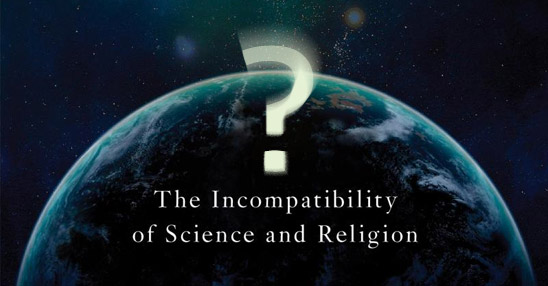
Of Miracles and Magisteria
a book review by Richard Morrock
Physicist Victor Stenger is renowned in skeptical circles as a hard-core atheist, and in his latest book, he targets organized religion as well as the quantum spiritualism of Deepak Chopra and the accommodationist position taken towards religion by adherents of Stephen Jay Gould’s Non-Overlapping Magisteria (NOMA). This book is clearly a must-read for anyone interested in the role of religion in society today, and it also provides an easy-to-understand explanation of quantum theory, showing that it lends no support to “New Age” spiritualism.
Stenger discusses everything from the origin of the universe to the 2012 elections. Even where one might disagree with his conclusions, he is still thought-provoking. Stenger demolishes the theist argument that science is no less based on faith than religion. He draws a firm line between faith and trust. We have faith in supernatural entities, whose actions we cannot experience directly, or in political or religious leaders whose sincerity has yet to be tested, but we trust science—or a reliable friend, or our auto mechanic—based on our experience. To believe in something in the absence of evidence is, in Stenger’s estimation, foolish, and it would be hard to disagree.
Many scientists, following the logic of NOMA, have concluded that science has nothing to say about the supernatural. Stenger points out that scientists have looked into near-death experiences and the effectiveness of prayer on the sick, finding nothing but trickery and self-deception. Why should angels, demons or God himself be considered off limits?
In fact, scientists had better hope that the supernatural doesn’t exist, because if it did, all scientific experiments could be invalidated. How would we know that a positive result was caused by the phenomenon the scientists were investigating, or by some lab worker who silently prayed for the outcome, or by an invisible imp lurking in the corner? Should scientists call Ghostbusters to sweep their labs before each experiment? What, then, about spooky action at a distance?
Stenger is right when he points out the hypocrisy of religious leaders who preach morality to their followers while leading depraved lives in private. And he has fun with the Catholic doctrine that we are all sinners and must suffer the tortures of purgatory before we are admitted, if even then, to heaven. We are still waiting for a priest to say to the grieving relatives at a funeral, “Your beloved husband and father is now burning in the fires of purgatory for a thousand years because he did some bad things in his life.” Instead, they invariably remind us that the departed are looking down on us from heaven.
Stenger says that the Vatican never excommunicated a Nazi leader. This is incorrect. Hitler and Goebbels were both excommunicated, but not because of their role in World War II or the Holocaust. Prior to the war, Goebbels married a Protestant woman without agreeing to raise their children—whom the couple murdered during the last days of the Third Reich—as Roman Catholics. Hitler was best man at the wedding. It’s not that the Vatican didn’t oppose Hitler—they thought he was too tolerant of other religions!
The theistic argument has always been that if the universe exists, it must have had a creator, who can only be God, whatever characteristics one ascribes to Him. This raises the question of who created God. Theists invariably respond that God always existed, to which Bertrand Russell replied that if God could always exist without being created, so could the universe.
That was before the Big Bang Theory (the cosmological event, not the TV show). Scientists accept the idea that the universe had a beginning 13.7 billion years ago. Even though this is consistent with the biblical account (“Let there be light”), fundamentalists in Kansas banned the Big Bang theory from the schools along with Darwinian evolution. Fundamentalists are opposed to science in principle, not only where it contradicts the Bible. Ironically, while the Big Bang theory does not prove the existence of God, it at least leaves open the possibility.
If the universe was created by a Big Bang, what caused the Big Bang? Perhaps a purple-robed patriarch? Stenger gives us a number of alternative scenarios, all of which leave out supernatural entities. One of these is the two-sided universe. One side is ours, and the other is a mirror image in which time runs backwards. Each side begins with a Big Bang and ends with a Big Crunch, causing the Big Bang on the other side. There, since the arrow of time runs in reverse, ashes burst into flame and turn into wood, water runs uphill, and predators regurgitate their prey, which then comes to life, and the two run off backwards with the predator in the lead.
Another scenario Stenger presents is the Multiverse, which holds that our universe is the result of a black hole created in a much larger universe, which in turn came from an even bigger one, and so on forever. This seems to contradict Stenger’s own claim that there are no infinities in nature, which, if true, would narrow down the number of possible scenarios for the origin of the universe. Furthermore, it overlooks the likelihood that each “daughter” universe would be far smaller than its “mother,” ultimately leading to mini-universes too small to create any new ones. And it hands the theists the argument that God must have created the Multiverse, since what else could have started it? In any case, we have no more evidence for other universes than we have for God, and this theory violates Occam’s razor by postulating a vast number of unproven entities. Also, how could scientists verify the existence of black holes, if they are in other universes?
Stenger is a reductionist, arguing that reality is “particles all the way up.” He dismisses the theory that there are different levels of reality, with new laws emerging at each level, claiming that this is supposed to lead to God controlling everything. Not necessarily. What he terms the emergentist (I prefer “interactionist”) position is just as compatible with atheism as it is with theism. The different laws that emerge at various levels—physics, chemistry, biology, psychology, history, philosophy—coexist with, rather than replace, the laws at the lower levels. After all, you cannot understand a football game simply by knowing the laws of physics; you also have to understand the rules of football, even if the players and the ball are ultimately made up of particles. Sometimes events at one level of reality cause events at another level, typically higher but occasionally lower. Stenger denies the possibility of such “top-down causality.” But examples of this would be someone suffering a heart attack (biological) after receiving distressing news (psychological), or the public getting angry (psychological) over something a politician said or did (historical). This has nothing to do with any supernatural creator.
Gould’s argument for NOMA, which Stenger rejects, was never intended to be a description of reality, but rather a prescription for it. NOMA reduces the Bible and other holy books to works of literature, often set in historical context, but no more literally true than Doctor Zhivago or Saving Private Ryan. These works have something to tell us, even though we recognize them as fiction. Just as we should learn to distinguish between faith and trust, as Stenger informs us, so should we distinguish between knowledge, derived from science and involving facts, and wisdom, which is supposed to be provided by religion, and which involves values. To be sure, we have pretty much mined the Bible for whatever wisdom it contains, and there is no shortage of pious but unwise people.
Science does not know everything, but if there are things we do not know, or may never know, there are others we can now be sure of. The supernatural does not exist; the laws governing the universe are immutable, and do not change because of our prayers; we don’t go to heaven or hell, or get reincarnated when we die; there is no inherent purpose to anything in the universe, except for our own lives and what we make of them. If the public can be educated to accept this, it hardly matters whether or not they call the laws of nature “God.”
God cannot yet be disproved, but at least we can dismiss angels, demons, ghosts and Santa Claus. And if miracles were real, far from proving the existence of God, they would actually disprove it. After all, if the laws of nature do not always apply—if the dead return from the grave—then anything is possible and no God is required to maintain the order of the universe, because there isn’t any order.
Religious people will not abandon their beliefs in the face of Stenger’s arguments. But they might revise them. Take away the supernatural elements from religion, which can be disproven, and the difference between the religious and scientific camps become little more than a matter of semantics. ![]()
Skeptical perspectives on science and religion…
-
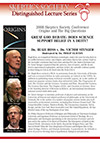 Great God Debate: Does Science Support Belief in a Deity?
Great God Debate: Does Science Support Belief in a Deity?
Dr. Hugh Ross v. Dr. Victor Stenger, moderated by Dr. Philip Clayton -
In part 1 of our 2008 conference “Origins & The Big Questions” Emeritus professor of physics and astronomy at the University of Hawaii and adjunct professor of philosophy at the University of Colorado, Dr. Victor Stenger challenges evangelical Christian cosmologist Dr. Hugh Ross makes his case for why there is no conflict between science and religion, and claims that in fact, science leads to the inevitable conclusion that God exists and that He’s the Judeo-Christian God. Order this debate on DVD, or order the other parts from this conference (or the entire 5-DVD set) below…
-
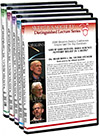 Origins & The Big Questions
Origins & The Big Questions
Conference 2008 (5 Part Set)
with Donald Prothero, Leonard Susskind, Paul Davies, Sean Carroll, Christof Koch, Kenneth miller, Nancey Murphy, & Michael Shermer -
Today, there is arguably no hotter topic in culture than science and religion, and so much of the debate turns on the “Big Questions” that involve “origins ”: the origin of the universe, the origin of the “fine-tuned” laws of nature, the origin of time and time’s arrow, the origin of life and complex life, and the origin of brains, minds, and consciousness. Now, science is making significant headway into providing natural explanations for these ultimate questions, which leaves us with the biggest question of all: “Does science make belief in God obsolete?” we have assembled some of the world’s greatest minds to discuss some of the world’s greatest questions. In 2008, the Skeptics Society held a conference wherein we assembled some of the world’s greatest minds to discuss some of the world’s greatest questions…
READ more about this conference and order the 5-part DVD set.
OR, order single DVDs: part 1 | part 2 | part 3 | part 4 | part 5
-
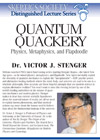 Quantum Quackery: Physics, Metaphysics, and Flapdoodle
Quantum Quackery: Physics, Metaphysics, and Flapdoodle
by Dr. Victor J. Stenger -
Dr. Stenger shows that because quantum mechanics is obscure it is often misused to explain the “unexplainable”—ESP, psychic power, etc. But quantum mechanical hypotheses fit the facts of material reality quite well without any need at all to call upon mysticism.
-
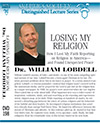 How I Lost My Faith Reporting on Religion in America — and Found Unexpected Peace
How I Lost My Faith Reporting on Religion in America — and Found Unexpected Peace
by William Lobdell -
William Lobdell’s journey of faith — and doubt — is one of the most compelling spiritual memoirs of our time. Lobdell noticed that religion wasn’t covered well in the mainstream media, and he prayed for the Lord to put him on the religion beat at a major newspaper. In 1998, his prayers were answered when the Los Angeles Times asked him to write about faith. What happened next was a roller-coaster of inspiration, confusion, doubt, and soul-searching as his reporting and experiences slowly chipped away at his faith. While reporting on hundreds of stories, he witnessed a disturbing gap between the tenets of various religions and the behaviors of the faithful and their leaders…
-
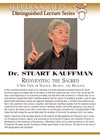 Reinventing the Sacred: A New View of Science, Reason & Religion
Reinventing the Sacred: A New View of Science, Reason & Religion
by by Dr. Stuart Kauffman -
World-renowned complexity theorist Dr. Stuart Kauffman argues that people who do not believe in God have largely lost their sense of the sacred and the deep human legitimacy of our inherited spirituality, and that those who do believe in a Creator God, no science will ever disprove that belief. Kauffman believes that the science of complexity provides a way to move beyond both reductionist science and dogmatic theology to something new: a unified culture where we see God in the creativity of the universe, biosphere, and humanity…
12-09-05
In this week’s eSkeptic:
Announcing the New Season
of Lectures at Caltech
Please note important policy and pricing changes below. Review them now.
SINCE 1992, the Skeptics Society has sponsored the Skeptics Distinguished Science Lecture Series at Caltech: a monthly lecture series at the California Institute of Technology in Pasadena, CA. Most lectures are available for purchase in audio & video formats. Watch several of our lectures for free online. So, mark your calendars!

Born Together-Reared Apart:
The Landmark Minnesota Twin Study
Sunday, September 16, 2012 at 2 pm
Baxter Lecture Hall
“The Minnesota Study of Twins Reared Apart” startled scientists by demonstrating that twins reared apart are as alike, across a number of personality traits and other measures, as those raised together, suggesting that genetic influence is pervasive. Dr. Nancy Segal, a professor in the Department of Psychology at California State University, Fullerton, and the director of the Twin Studies Center, offers an overview of the study’s scientific contributions and effect on public consciousness. Dr. Segal is an associate editor of Twin Research and Human Genetics, the official journal of the International Society for Twin Studies.
Followed by…
- DR. CHRISTOPHER BOEHM
Moral Origins: The Evolution of Virtue, Altruism, and Shame
Sunday, September 30, 2012 at 2 pm
Baxter Lecture Hall - DR. KEVIN DUTTON
The Wisdom of Psychopaths: What Saints, Spies, and Serial Killers
Can Teach Us About Success
Sunday, October 28, 2012 at 2 pm
Baxter Lecture Hall - DR. SEAN M. CARROLL
The Particle at the End of the Universe: How the Hunt for the Higgs Boson
Leads Us to the Edge of a New World
Sunday, November 18, 2012 at 2 pm
Baxter Lecture Hall - DR. DONALD YEOMANS
Near-Earth Objects: Finding Them Before They Find Us
Sunday, December 2, 2012 at 2 pm
Baxter Lecture Hall - DR. PAUL ZAK
The Moral Molecule: The Source of Love and Prosperity
Sunday, December 16, 2012 at 2 pm
Baxter Lecture Hall - DR. JARED DIAMOND
The World Until Yesterday: What Can We Learn from Traditional Societies?
Special date and location:
Saturday, January 5, 2013 at 2 pm
Beckman Auditorium - DR. W. PATRICK MCCRAY
The Visioneers: How a Group of Elite Scientists Pursued Space Colonies, Nanotechnologies, and a Limitless Future
Sunday, January 20, 2013 at 2 pm
Baxter Lecture Hall
New Admission Policy
Due to security concerns, Baxter Hall will be locked and the audience will be admitted only through the doors on the South side of the building by the lily ponds. If, for medical reasons, you cannot climb the stairs to the hall on the 2nd floor, someone at the main entrance (located in the middle of the West side of the building) will escort you to the elevator. Get directions to the Caltech Campus, Baxter Hall and Beckman Auditorium.
New Prices for this Season of Lectures
Due to increasing costs, we are forced to raise our ticket prices to $10 for Skeptics Society members and the JPL/Caltech community, $15 for nonmembers. Tickets for all Baxter Lecture Hall events are sold on a first come, first served basis at the door. Seating is limited. Your admission fee is a donation that pays for our lecture expenses.
Service Charge on Phone/Fax Ticket Orders
For all tickets purchased by phone or fax for Beckman Auditorium lectures (for this season, this only applies to the Jared Diamond lecture on January 5, 2013), Caltech will add an $8 service charge per ticket order (no matter how many tickets are ordered). No service charge will be added to tickets purchased at the door on the day of the event or purchased in person at the Caltech ticket office in advance.

NEW ON MICHAELSHERMER.COM
Conspiracy Contradictions
Why do people who believe Princess Di was murdered also tend to believe she’s still alive? In Michael Shermer’s September “Skeptic” column for Scientific American, he explains why people who believe in one conspiracy theory are prone to believing in others. Read the entire article for free on michaelshermer.com!
NEW ON SKEPTICBLOG.ORG
Mystery UFO Photo
In this Skepticblog, Michael Shermer shares a letter and some photos of an unidentified flying object that he received from a reader.


NEW ON SKEPTICBLOG.ORG
The Long Road
Daniel Loxton returns from a family road trip to share a few thoughts about staving off skeptical burnout.

2012 Parsec Award Winner!
Best “Fact behind the Fiction” Podcast
The Parsec is an award given to support excellence in podcasting. It has been a regular feature of Dragon*Con since 2006. 2012 marked MonsterTalk’s third nomination and first win in the “Fact Behind The Fiction” category. MonsterTalk is honored to have been nominated and delighted to have won.
Get the MonsterTalk Podcast App
for Apple and Android Devices!
Get the MonsterTalk Podcast App (presented by Skeptic Magazine) and enjoy the science show about monsters on your handheld devices! Available for Android, iPhone, iPad, and iPod Touch. To get the app for iOS devices, download the free Podcast Box App on iTunes and then search for MonsterTalk within the Podcast Box app to listen to Monstertalk on your iPhone, iPad or iPod. For Android devices, simply install the stand-alone app.
Vaccine: The Debate in Modern America
Vaccines are one of science’s greatest achievements. Yet, fears and anxieties about immunization persist. In this week’s eSkeptic, Christian Orlic reviews Mark A. Largent’s new book Vaccine: The Debate in Modern America (2012, Johns Hopkins University Press, ISBN 978-1421406077).
Christian Orlic is currently pursuing a PhD in Evolutionary Biology at Michigan State University. He holds Bachelor of Science degrees in History of Science and in Zoology.

Engaging the Anti-vaxxers
a book review by Christian Orlic
On May 14, 1796, Edward Jenner developed and tested the first vaccine. He was able to protect people from smallpox by inoculating them with cowpox. Two centuries later vaccines have eradicated diseases and are often described as one of public health’s greatest achievements. According to the CDC vaccines have been highly successful and by 1996 there was 97.8% decrease in the incidence of rubella, diphtheria, haemophilus influenza type b, measles, mumps, pertussis, polio and tetanus (20).
Nevertheless, American parents appear to be more anxious than ever about vaccinating their children. Currently, American children receive at least 36 vaccinations before their sixth birthday. Some vaccines protect children and people against devastating communicable diseases that if when left unvaccinated would result in epidemics within communities. Nowadays about 40% of American parents chose to delay or refuse vaccinations for their children (15). Most of the children who have received no vaccines have slipped through the cracks: they are poor and have no insurance (20–40% of unvaccinated children). About 11.5% of American parents have “consciously refused” vaccines recommended by pediatricians, and about 23% have delayed some vaccines (32). Currently, all U.S. states allow vaccine exemptions for medical reasons, 48 states also allow children to be exempt for religious reasons, and some have even begun accepting philosophical objections.
Mark A. Largent is a historian of biology and director of Science, Technology, Environment, Public Policy (STEPPS) at Michigan State University. Largent’s previous book, Breeding Contempt, deals with the history of coerced sterilization in the United States. In Vaccine: The Debate in Modern America, Largent couples historical scholarship, keen cultural observations, and personal experiences in order to explore the American debate surrounding vaccination. Largent’s provocative but compelling argument suggests that the debate about the science, safety and efficacy of vaccination is a proxy for a set of unaddressed underlying anxieties regarding vaccines; therefore, science is not enough to resolve it, “no scientific finding and no agreement among physicians and scientists can possibly bring it [the debate] to an end” (173).
The book sets out to explore these anxieties and understand where and how they originated. Largent’s insightful observations provide ways in which the debate can be moved forward by addressing the anxieties parents have directly, rather than bickering about “simplistic stand-ins” (1). The anxieties that motivate the debate are over the number of vaccinations required, the diseases for which we vaccinate, the contents of vaccines, a perception that pharmaceutical companies care more about profits than safety, recent public health emergencies, fears over the long term effects of vaccinations, a belief that natural is better, as well as an overall frustration with the state of medical care. These underlying anxieties, Largent argues, must be addressed in order to continue enjoying high levels of vaccine compliance: “our continuing success in vaccinating children depends on whether the public has confidence in the scientists, doctors, and policy makers (including industry) who shape these programs” (136).
The current debate surrounding vaccinations is bipartisan, and those who oppose vaccines use both liberal and conservative arguments. The anti-vaccine movement was influenced by alternative medicine and recent events. For example, when AIDS was first described, Eva Lee Snead claimed it was linked to the polio vaccine (52). Some concerns about vaccines are and have been legitimate. When polio vaccines were first developed, kidney tissue from chimpanzees was used. In fact, this process was unsafe, and tens of millions of people were unintentionally infected with SV40 (53). The fears expressed by Snead were thus not unwarranted; if one virus could make the cross-species jump, others could too. Since then, however, studies have disproven the link between the polio inoculations and HIV. Likewise, the alleged link between Gulf War Syndrome and vaccines given to soldiers is now debunked. Largent concludes that both of these public health emergencies fed suspicions about the safety of vaccines.
The claim that vaccines were linked to autism emerged at the same time in the U.S. and in the UK. These claims could only emerge because “modern concerns about vaccines were already in place” (67). Largent may come off as too sympathetic to Dr. Wakefield and Jenny McCarthy, “the iconic vaccine-anxious parent” (139); however, I submit, that this is required for both good history and understanding. By at least momentarily embracing the views of those who opposed vaccination, we come to understand why they hold these views and how they developed them. Chapter 3 and 4 of Largent’s book explore how Wakefield and McCarthy came to believe that vaccines cause autism and how they became spokespeople for an already anxious community. Their rapid rise to celebrity within their community supports the assertion that British and American parents were already anxious. Therefore, it should not surprise observers “how easily they adopted an explanation that was critical of the modern vaccine schedule” (73). The alleged link between thimerosal and autism, as well as that of the MMR vaccine with digestive problems resulting in developmental problems, provided “a ready-made venue for discussing their concerns about vaccines within a group of like-minded advocates”(12). While Largent recognizes that there is no evidence to support either Wakefield or McCarthy claims, he thinks that their outright dismissal is detrimental to maintaining high levels of vaccine compliance.
Largent argues that by ignoring the underlying anxieties, public health officials and vaccine advocates have misconstrued the reasons parents chose not to vaccinate, or to delay vaccination. Secondly, public health officials prefer to discuss the efficacy and safety of vaccines because this is within their professional realm. Vaccine advocates often claim that ignorance is one of the reasons parents are anxious about vaccinating their children. They claim that this refusal to vaccinate is predicated by an ignorance of the severity of the diseases for which vaccines protect. Whereas, data demonstrates that the more educated parents are the more likely they are to have reservations about the recommended vaccine schedule (34). These parents for the most part are making conscious, non-religious, decisions to refuse or delay vaccinating their children. Further antagonizing them rather than addressing underlying anxieties is likely to reduce vaccine compliance.
One of the most important observations made by Largent is that not all vaccines are the same. Some vaccines protect against devastating diseases (MMR, DPT), others protect against dangerous ones (Hep A, Hep B, Hib, rotavirus, PCV) but the likelihood that an infant may be exposed to these is low, and other vaccinations provide protection against diseases with extremely low mortality rates (chickenpox). The distinction between the diseases each vaccine protects from are often forgotten. For example, Largent argues that some of the diseases we vaccinate newly born babies against may be unnecessary, such as HepB, a disease that an infant could only “contract by having sex with an infected person or by sharing contaminated needles with an infected drug addict” could wait (2). Public health officials should keep in mind that it is preferable for children to be under vaccinated than not vaccinated at all. Unfortunately, the vaccine debate is polarized. Amanda Peet, who supports vaccination, referred to the parents of unvaccinated children as “parasites” (she later apologized). Recognizing that not all vaccines are equal could sooth the rhetoric of the debate and allow for a more fruitful discussion. Otherwise, parents who are anxious about the amount of vaccines or one specific vaccine may be pushed not to vaccinate at all. Failing to recognize the differences between different inoculations results in an all or nothing approach (167). ![]()
Skeptical perspectives on medicine, pseudomedicine, and medical controversies…
-
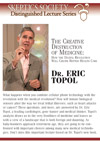 How the Digital Revolution
How the Digital Revolution
Will Create Better Health Care
by Dr. Eric Topol -
What happens when you combine cellular phone technology with the cellular aberrations in disease? Or create a bridge between the digital revolution with the medical revolution? How will minute biological sensors alter the way we treat lethal illnesses, such as heart attacks or cancer? These questions, and more, are answered by Dr. Eric Topol, a leading cardiologist, gene hunter and medical thinker. Topol’s analysis draws us to the very frontlines of medicine and leaves us with a view of a landscape that is both foreign and daunting.
-
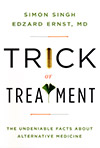 Trick or Treatment: The Undeniable Facts About Alternative Medicine
Trick or Treatment: The Undeniable Facts About Alternative Medicine
by Simon Singh & Edzard Ernst -
There is no alternative medicine; there is just scientific medicine and everything else that has yet to be tested. This book is an excellent guide to the confusions and contradictions of alternative medicine written with clarity, integrity and authority. What works? Who can you trust? What alternative cures have positive results? What medical authorities are included in their “Top ten culprits in the promotion of unproven and disproven medicine?” Includes extensive information on the big four: acupuncture, homeopathy, herbs, and chiropractic, plus a “Rapid guide to Alternative Therapies.” Not just a great read, but also a vital reference source on where to turn when disease or illness strikes you or someone you know, to get the straight facts about what science really has to say on the subject.
-
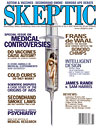 Medical Controversies
Medical Controversies
Skeptic Vol. 13 No. 3 -
In this issue: Mercury Rising: Exposing the Vaccine-Autism Myth; Science & Secondhand Smoke: The Need for a Good Puff of Skepticism; Clearing the Air: What Does Science Really Say About Secondhand Smoke?; The Trouble with Psychiatry; Animals & Medicine: Do Animal Experiments Predict Human Responses?; Contested Testimony in Scientific Disputes: The Case of the Origins of AIDS; Blind or Double Talk?: Reading Medical Research with a Skeptical Eye…
-
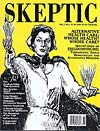 Pseudomedicine
Pseudomedicine
Skeptic Vol. 3 No. 1 -
In this issue: Therapeutic Touch: Skeptics in Hand-to-Hand Combat Over the Latest New Age Health Fad; Homeopathy: A Position Statement by the National Council Against Health Fraud; Spiritual Belief Systems Compete as Alternatives to Scientific Health Care …
12-08-29
In this week’s eSkeptic:
Announcing the Latest Issue
of Skeptic Magazine
TOPICS IN THIS ISSUE INCLUDE: Is Ours a Christian Civilization?; An Inside Look at How Astronomers are Searching for Extrasolar Planets; The Flake Equation: Estimating the Number of People Who Have Experienced the Paranormal; The Physics of UFOs: How Realistic is it for Spacecraft to Travel Interstellar Distances to Earth?; The SkepDoc on Multiple Personality Delusions; James Randi Celebrates the Reason Rally; Junior Skeptic explores Mokele Mbembe; Why There is Something Rather Than Nothing, and more…
Current subscribers should receive this issue by mid-September 2012.

SKEPTICALITY EPISODE 189
Interview with Victor Stenger
This week on Skepticality, Derek spends a little bit of his time before the start of Dragon*Con in conversation with Victor Stenger, discussing Stenger’s latest book, God and the Folly of Faith: The Incompatibility of Science and Religion. Based on his experience as a particle physicist, New Atheist Stenger outlines his belief that hard science has much to say about religious claims that scientific and skeptical organizations typically regard as falling outside the empirical scope of science.
Why Do Cyclists and Other Athletes Dope?
In this week’s eSkeptic we present the complete version of Michael Shermer’s article, originally published in Scientific American, that attempts to answer this question using game theory and behavioral economics and psychology. It is, for the most part, a “rational choice” made by athletes in general and cyclists in particular when it comes to the decision to dope or leave the sport altogether because it is almost impossible to compete if everyone else is doping. And if you only think everyone else is doping the temptation to choose the cheating option becomes psychologically overwhelming. You can read the original article with the graphs and charts (not included in this text version) via Scientific American Digital.

The Doping Dilemma
Game theory helps explain the pervasive abuse of drugs in cycling and sports
by Michael Shermer
For a competitive cyclist there is nothing more physically crushing and psychologically demoralizing than getting dropped on a climb. With searing lungs and burning legs, your body hunches over the handlebars like a writhing statue as you struggle to hang on to the wheel in front of you, knowing that once you come off the back your body will shut down, and along with it any hope for victory. The battle lost for the want of a few trillion oxygenated red blood cells.
I know the feeling because it happened to me in 1985 on the long climb out of Albuquerque during the 3,000-mile nonstop transcontinental Race Across America. On the outskirts of town I caught up with the 2nd place rider (and eventual winner) Jonathan Boyer, a svelte road racer who was the first American to compete in the Tour de France. About half way up the relentlessly ascending alluvial fan that forms the eastern basin of mountains surrounding the New Mexico city, that familiar wave of fatigue swept through my legs as I gulped for oxygen and stood on the pedals to stay in contact as long as possible. To no avail. By the top of the climb Boyer was a tiny dot on the shimmering blacktop and I didn’t see him again until Atlantic City. Later that night Jim Lampley, the commentator for ABC’s Wide World of Sports that was covering the race, asked what else I might have done to go faster. “I should have picked better parents,” I joked, explaining that we all have certain genetic limitations that cannot be overcome through the normal channels of training. What else could I have done?
Plenty, and I knew it. Cyclists on the 1984 U.S. Olympic cycling team told me how they injected themselves with extra blood before races—their own drawn earlier in the season (called autologous transfusion, still undetectable) or that of a friend or relative with the same blood type (called homologous transfusion, now detectable). This “blood doping” was not banned at the time, and on a sliding moral scale it seemed only marginally distinguishable from training at high altitude. Either way you increase the number of oxygen-carrying red blood cells to deliver that vital fuel to your pedal-pushing muscles. But I was 30 years old and teaching college part time, and since there was little money on the line I raced bikes primarily just to see how far I could push my body before it gave out (which it did in 1983 when my neck muscles collapsed, resulting in the malady now known ignominiously as “Shermer Neck”). Enhancing my performance artificially didn’t mesh well with my reasons for racing, plus I’m not fond of needles.
If, however, I was 20, had no prospects for an alternative career, earned my living through my one true passion of competitive cycling, made a team in which performance enhancing drugs were part and parcel of the “medical program,” realized that I could be cut from the team if I was not competitive, believed that most competitors in the sport were augmenting their natural gifts with unnatural products, and was aware that most cyclists are not tested for drugs, those who are tested almost never get caught, and those who get caught receive a relatively minor penalty, there is a very real possibility that I would have taken that other road, the one becoming ever more traveled in this sport now bent in its own entangled undergrowth.
This scenario is, in its essence, what most competitive cyclists have been facing since the early 1990s, and it is unprecedented even for a sport long known for doping. Personally, I don’t want to believe that any of these stellar athletes are guilty, and of course each individual is innocent until proven otherwise and should receive the same legal rights as any citizen (many don’t under the current system). However, the convergence of evidence from numerous lines of inquiry leads me to conclude that most of the top cyclists for the past fifteen years were using performance enhancing drugs (PEDs). That fact will become clear below, but take it from a professional skeptic that if you still believe that most elite athletes compete clean then you may want to join the Fair Play Committee for those who believe we never went to the moon. It is time to move beyond if and ask why. The reason is threefold:
- better drugs, drug cocktails, and drug/training regimens,
- an evolutionary arms-race consistently won by drug takers over drug testers, and
- a shift in the game matrix from mostly cooperation to mostly defection from the rules.
Gaming Sports
Game theory is the study of the behavior of players in a game, especially how each player chooses strategies they hope will maximize their return in anticipation of the strategies chosen by the other players in the game. In the Prisoner’s Dilemma (PD) game, for example, you and another player are prisoners arrested for a crime with the following options:
- If both of you remain silent then you each receive one year in jail;
- If you confess but the other player does not, then you go free and he gets three years;
- If the other player confesses and you don’t, then you receive the three-year penalty while he goes free;
- If you both confess then you each get two years.
Here is the game matrix for the Prisoner’s Dilemma:
| Cooperate (remain silent) |
Defect (confess) |
|||
|---|---|---|---|---|
| Cooperate (remain silent) |
-1, -1 | 0, -3 | ||
| Defect (confess) |
-3, 0 | -2, -2 | ||
If you defect on your partner and confess, then you will get either 0 or 2 years, depending on what he does. If you cooperate and stay quiet, you receive either 1 or 3 years, again depending on his response. In this scenario the logical choice is to defect. The Caltech behavioral economist Colin Camerer, in his 2003 book Behavioral Game Theory (Princeton University Press), explains why through the following hypothetical matrix for a typical PD game (assumes T > H > L > S):
| Cooperate (remain silent) |
Defect (confess) |
|||
|---|---|---|---|---|
| Cooperate (remain silent) |
H, H | T, S | ||
| Defect (confess) |
S, T | L, L | ||
| Payoffs: T(emptation), H(igh), L(ow), and S(ucker) | ||||
“Mutual cooperation provides payoffs of H(igh) for each player, which is better than the L(ow) payoff from mutual defection. However, if the other player cooperates, a defector earns the T(emptation) payoff, which is better than reciprocating and earning only H (since T > H in a PD). A player who cooperates against a defector earns the S(ucker) payoff, which is less than earning L from defecting. Since T > H and L > S, both players prefer to defect whether the other player cooperates or not.”
Research shows that when the game is played just once, or over a fixed number of rounds without the players being allowed to communicate, defection is the common strategy. But when the game is played over an unknown number of rounds the most common strategy is “tit-for-tat,” where you begin by cooperating and then do whatever the other player does. Even more cooperation can be induced in a “Many Person Dilemma” in which one player interacts with several other players, and in which players are allowed to accumulate experience with the other players in order to establish trust. This more closely resembles the real world of sports, marriage, business, and international diplomacy, in which cooperation leads to trust which leads to more cooperation. But once defection builds momentum there is a cascading sequence of defection throughout the system, leading to divorce, bankruptcy, war, and in our case study here, massive doping.
Cycling, like all sports, is a game with rules and players. The rules today clearly prohibit the use of performance enhancing drugs. But because the drugs are extremely effective and the payoffs for success are so high, and because most of the drugs are difficult if not impossible to detect, the incentive to use them is powerful. Once a few elite riders defect to gain an advantage over their cooperating competitors, they too must defect (even if they only think others are cheating), leading to a cascade of defection down through the ranks, as the doping leaders need strong supportive team members, who are then tempted to dope in order to do their job, leading to amateur athletes to dope in order to even compete, and before long the entire system breaks down. Because the rules are clear, however, a code of silence prevents any open communication and cooperation between competitors and teams in order to reverse the defection trend.
It was not always this way. Although various stimulants and painkillers were employed by many riders from the 1940s through the 1980s, the general consensus amongst sports physiologists and cycling aficionados whom I know is that these drugs were not so effective that we could not conclude that the playing field was relatively level and that the best cyclists consistently won. Until the British rider Tom Simpson died from an overdose of amphetamines on the leg-breaking climb up Mont Ventoux in the 1967 Tour (it was reportedly over 110 degrees when Simpson attacked in what would have been his best shot to win a Tour), doping regulations were virtually nonexistent. Even after Simpson’s death, doping controls throughout the 1970s and 1980s were spotty at best, and because the fans and sponsors loved the high drama of the sport’s brutal nature, and since the drugs were more for survival than anything else, officials turned a blind eye. Since there was no clear demarcation between cooperation and defection in this game configuration, few perceived it as cheating. But something happened in the 1990s to alter the matrix.
The EPO Elixir and the Evolutionary Arms Race
That something was recombinant Erythropoietin (r-EPO). In its natural state EPO is a glycoprotein hormone produced by the kidneys that when released into the bloodstream binds to receptors in the bone marrow to stimulate the production of red blood cells. Chronic kidney failure and chemotherapy can cause anemia, and so the development of r-EPO in the late 1980s proved to be a boon to chronically ill patients…and chronically competitive athletes.
r-EPO is just as effective as blood transfusions, but instead of hassling with storing bags of blood and poking long needles into a vein, the athlete can store the tiny ampoules of the drug on ice in a thermos bottle or hotel mini fridge and simply inject it subcutaneously through a tiny needle in the fatty tissue in the abdomen, the deltoid area of upper arm, or in the fat tissue at front of thigh muscle. r-EPO’s effects are directly measurable through a hematocrit (HCT) reading that gives the percentage of blood volume accounted for by red blood cells (normally spun in a laboratory centrifuge, riders have small portable centrifuges for regular HCT monitoring while traveling to races). More red blood cells means more oxygen carried to the muscles, so if a little more is good then a lot more must be great. The normal percentage for men is 45% ± 7% (38–52%). Trained endurance athletes can naturally sustain their HCT in the high 40s and low 50s. EPO can push it into the high 50s and even the 60s. The 1996 Tour de France winner, Bjarne Riis, was nicknamed “Mr. 60 percent,” which he confessed in 2007 that he achieved via r-EPO.
r-EPO appears to have made its way into the professional peloton in the early 1990s. The three-time Tour de France winner Greg LeMond thinks it was 1991. Having won the Tour in 1986, 1989, and 1990, LeMond set his sights on breaking the record of five Tour victories, and in the spring of 1991 was poised to take his fourth. “I was the fittest I had ever been, my split times in spring training rides were the fastest of my career, and I had assembled a great team around me,” LeMond recalled. “But something was different in the 1991 Tour. There were riders from previous years who couldn’t stay on my wheel who were now dropping me on even modest climbs. We were scrambling just to stay in contention.” LeMond finished 7th that year, vowing to himself that he could win clean the next year. It was not to be. “In 1992 our performance was abysmal and I couldn’t even finish the race. Finally, one of my teammates came to me and said that we had to get on the new medical program that the other teams were using.” That program, says LeMond, included r-EPO, which he refused to take, relegating him to another DNF in 1994, his final race. The matrix had changed and those who refused to defect fell by the wayside. And some who did defect fell over dead.
At 60 percent and higher the blood is so thick that clots can form, especially while sleeping when the heart rate slows (and endurance athletes are renowned for resting heart rates in the low 30s). When two elite Dutch riders—Bert Oosterbosch and Johannes Draaijer—died of heart attacks in 1989 and 1990 (respectively) after experimenting with r-EPO, some riders reportedly slept with a heart rate monitor hooked to an alarm that would sound when their pulse dropped too low, and then engage in heart-rate elevating exercise in the middle of the night. Even this precaution was not enough for the following cyclists who died from 2003 to 2005: Denis Zanette (dead at 32 from cardiac arrest/myocarditis); Marco Ceriani (dead at 16 from cardiac arrest during a bike race); Fabrice Salanson (dead at 23 from cardiac arrest during sleep); Marco Rusconi (dead at 24 from cardiac arrest while awake); Jose Maria Jiménez (dead at 32 from heart attack while awake); Michel Zanoli (dead at 35 from heart attack); Johan Sermon (dead at 21 from cardiac arrest during sleep); Alessio Galletti (dead at 37 from heart attack during a race); Ubaldo Mesa (dead at 32 from cardiac arrest while cycling).
And the peloton cycled on.
Because there was no test for r-EPO until 2001, in 1997 the Union Cycliste International (UCI), the governing body of the sport, set a HCT limit of 50 percent. In theory that should have solved the problem and created a relatively level playing field. Not so, explains Prentice Steffen, M.D., the one-time medical director for the U.S. Postal Service team. “Let’s say that we artificially adjusted to 49 percent the HCT levels of the first hundred finishers in the Tour. The playing field is still not level because some athletes are naturally at 39 percent while others are naturally at 49 percent, so those on the lower end stand to benefit much more from doping than those on the higher end.”
Test or no test, just as in evolution there is an arms race between predators and prey that drives both to greater levels of fitness, in sports there is an arms race between the drug takers and the drug testers, and in my opinion the testers are five years away from catching the takers…and always will be. Those who stand to benefit the most from defecting on the rules of the game will always be more creative than those enforcing the rules, unless the latter have equivalent incentives. In this case, shortly after the UCI set the 50 percent limit, riders figured out that they could go higher and then at test time thin their blood with a technique already allowed and routinely practiced: injections of saline water for rehydration. Presto chango.
Willy Voet, the soigneur (massage therapist and all around caretaker) for Team Festina in the 1990s, explained how he beat the testers in his tell-all book Breaking the Chain:
Just in case the UCI doctors arrived in the morning to check the riders’ hematocrit levels, I got everything ready to get them through the tests. I went up to the cyclists’ rooms with sodium drips, flasks of water mixed with 0.09 percent sodium. In an emergency, you just had to take a picture off the wall and use the hook to hang the drip from. The rest was child’s play: put the tap into the drip, stick the needle into the rider’s arm, open the tap and check the first few drips—no more than sixty a minute to avoid any shock to the system. After that I would open the tap fully because there was no danger. The whole transfusion would take twenty minutes, the saline diluting the blood and so reducing the hematocrit level by three units—just enough. This contraption took no more than two minutes to set up, which meant we could put it into action while the UCI doctors waited for the riders to come down from their rooms.
Besting the urine tests was farcical if not comical. The “hidey hole,” sometimes called “the wizzer,” was a tube with a small cork on one end and a condom filled with clean urine on the other end. “You slip the part of the tube fitted with the condom up the backside, and stick it to the skin, following the line of the perineum, as far as the testicles,” Voet explained. “The condom full of urine is held in the anus, which has the advantage of keeping the urine at body temperature, so the doctor won’t be suspicious. This system was never bettered—no doctor suspected a thing and I used it for three years without any worries.” That is, until the “clean” urine from a team mechanic turned out to be tainted with amphetamines taken to stay awake for an all night drive!
How did the new rules of this game change the players’ strategies?
The Faustian Bargain Writ Large
I put the question directly to Joe Papp, a 32-year old professional cyclist now banned for two years after testing positive for synthetic testosterone after a stage in the Tour of Turkey. As most athletes are wont to do when caught doping, Papp fervently denied the charge and vowed to fight it through legal channels. But about the time his legal bills outpaced his winnings, Papp crashed hard in an Italian race, leaving him in a hospital with a massive hemorrhage that he attributed to the drugs he took. “I stopped to consider what was to be gained in fighting the charges against me and I realized that I was only perpetuating the problem, so I came clean and told my story.”
The consequences were far worse than the two-year ban. “The sport spit me out,” Papp lamented. “A team becomes a band of brothers in which there is shared suffering, but with a team of dopers there’s an additional bond—a shared secret—and with that there is a code of silence. If you get busted, you keep your mouth shut. The moment I confessed I was renounced by my friends because in their mind I put them at risk. One guy called and threatened to kill me if I revealed that he doped.” Papp never wanted to dope, he explained, and neither did most of his fellow cyclists. But once the drugs are available to give a few cyclists an edge, pressure mounts to close the performance gap by any means, legal or illegal. Recalling the day he was handed the “secret black bag,” Papp explained how a moral choice becomes an economic decision: “When you join a team with an organized doping program in place you are simply given the drugs and a choice: take them to keep up or don’t take them and there is a good chance you will not have a career in cycling.” Most apparently chose the former, says Papp, noting that “one European team that I was on every one of the riders were doping.”
Papp was never a Tour de France-caliber cyclist, however, so perhaps the game matrix is different at the elite level. Nope. “The law of silence: it exists not only in the Mafia but also in the peloton,” writes Paul Kimmage about the elite pro circuit in his 1990 mea culpa, Rough Ride. “Those who break the law, who talk to the press about the dope problems in the sport are despised. They are branded as having ‘craché dans la soupe,’ they have ‘spat in the soup’.” After an extensive exposé on how the doping program worked in the 1980s, Kimmage gave this game-theoretic analysis of the psychology of defection: “The big men never talk and to be honest I don’t really blame them—what have they to gain? They too were once young and innocent. Why should they jeopardize their hard-earned respect? If they took illegal substances it was only because everyone else was doing it.”
This was before r-EPO, which only exacerbated the problem says Frankie Andreu, the “super domestique” on the U.S. Postal Service team, riding in support of Lance Armstrong. “For years I had no trouble staying with most of the riders on the climbs, doing my job to help the team leader,” Andreu explained. “Then around 1995 or 1996 the speeds of the races shifted dramatically upward. One year we were all in our small chain ring on a climb, and the next year most of the guys in their big chain ring on the same climb. Something happened, and it wasn’t just training.”
Andreu resisted the temptation as long as he could, but by 1999 he could no longer do his job. “It became apparent to me that enough of the peloton was on the juice that I had to do something.” He then made the fateful drive to Switzerland where r-EPO could be purchased over the counter, and began injecting himself two to three times a week. “It’s not like Redbull, which gives you instant energy,” he explained when I asked what it felt like. “But it does allow you to dig a little deeper, to hang on to the group a little longer, to go maybe 31.5 mph instead of 30 mph, which meant that I could get back on the group after a long climb to help my team.” And help it he did, as this was the year that Lance Armstrong and the Posties began their domination of the sport.
An additional benefit of r-EPO in a brutal three-week race like the Tour de France is not just boosting HCT levels, but holding them there. “Let’s say you’re at 48 percent at the start of the race,” Andreu calculated. “By the end of the Tour you’d normally be at around 42 percent and really feel the difference. Without EPO I was completely wasted at the end of a Tour. With EPO you can hold it at 48 percent for the entire race. I remember that by the late 1990s the riders looked so much more refreshed at the end of the Tour than they used to.” Jonathan Vaughters, a former teammate of Lance Armstrong on U.S. Postal Service, crunched the numbers for me this way: “The big advantage of blood doping is the ability to keep a 44% HCT over three weeks (or maybe, unsuspectingly, increase it to 46%…just a teeny bit, that no one would notice). With expected hemodilution and hemolysis over three weeks, a 44% HCT should be 40% by the end, so just stabilizing it at 44% is a 5% performance advantage. Bumping it up any is maybe a 10% performance increase. This is a big advantage.”
And this does not include the performance enhancing effects of the other drugs in the user’s cocktail.
The Difference in Doping and the Difference it Makes
A window into what is in that cocktail was opened on July 8, 1998, when the aforementioned Willy Voet was stopped at the Franco-Belgian border on his way to the Tour de France. In his car police discovered refrigerated bags containing 234 doses of r-EPO, 86 vials of human growth hormone, 160 capsules of testosterone, 4 ampoules of adrenocorticotrophic hormone, 248 vials of something labeled “physiological serum,” 8 doses of hepatitis-A vaccine, and 60 doses of a blood-thinning drug to prevent strokes and heart attacks from excessively high HCT. Also in Voet’s grab bag (and in his body) was his own concoction he called the “Belgian mix” (or sometimes “‘madman’s mix’ because the next day you looked as if you’d been in the nuthouse”) a potent concoction for riders on difficult stages (and soigneurs who have to work all night): amphetamines, caffeine, cocaine, corticosteroids, heroin, and assorted painkillers. As the Judge who presided over the doping case of the French champion Richard Virenque, noted in his decision: “These are not racers, they are pedaling test-tubes.”
Do these drugs really make a difference? They do. By many measures, starting with average speed improvements over the past half century. To control for yearly variance effected by course changes and weather, I averaged speeds over 14-year blocks of time starting with 1991 (when r-EPO apparently became widely used). From 1949 to 1962 the Tour winner’s average speed was 34.7 kilometers per hour. From 1963 to 1976 the winner’s average speed increased to 35.4 kph, a 2% difference. From 1977 to 1990 the winner’s average speed increased another 2% to 36.2 kph. From 1991 to 2004 the winner’s average speed jumped to 39.5 kph, a 9% increase. Such a quantum leap in speed cannot be accounted for by equipment, nutrition, or training, as the 1980s were the high water mark for such revolutionary transitions from the old to the new (aerodynamic clothing, wheels, and components, aero bars, light-weight composite bikes, click-in pedal systems, index gear shifting, etc.). For those who think that the sport was clean after 2004 (when stricter doping controls were implemented), the 2005 and 2006 Tours were the fastest ever at 41.6 kph and 41.0 kph respectively. Perhaps the massive crackdown on and disqualification of dopers in the 2007 race finally made a difference, because the average speed of that race was back down to 39.0 kph.
Scientific studies on the effects of PEDs are few in number and usually conducted on non- or recreational athletes. For obvious reasons, elite athletes who dope are disinclined to disclose their data to curious scientists, but the consensus among sports physiologists I interviewed is that r-EPO boosts performance a minimum of 5% to 10%, and in conjunction with the brew of other PEDs an additional 5% to 10% can be squeezed out of the human engine. In events decided by less than one percent differences, this is colossal. The Australian sports physiologist Michael Ashenden, founder of the group Science and Industry Against Blood Doping, co-authored a 2002 study on recreational athletes in which they gave them r-EPO (or a placebo) over a 12-week span, using VO2max (maximal aerobic power) as the performance measure. The r-EPO group experienced 7.7%, 9.7%, and 4.7% improvements at weeks 4, 8, and 12. A 2007 study on non-athletes found even more spectacular results for the miracle drug, with a 12.5% and 11.6% increase in VO2max at weeks 4 and 11 respectively. Training at high altitude, by comparison, yields only a 1 to 1.5% improvement, Ashenden says, so any notion that blood doping is morally equivalent to high altitude training is put to the lie by the data.
Sports physiologists Jonathan Dugas and Ross Tucker, who run a highly informative blog on the subject (scienceofsport.blogspot.com), cautioned that because such studies have been conducted on non- or recreational cyclists “perhaps the size of the improvement is larger than one would expect in a pro athlete who is much nearer the maximum level even without the use of EPO.” However, Dugas and Tucker noted that such figures are only for in-competition differences, whereas an additional benefit likely comes through recovery assistance. “A Tour rider is expected to get progressively worse as the Tour progresses. However, if doping is used, and this decrease in performance is merely prevented, then the difference between a doper and non-doper might be enormous.”
The Italian sports physiologist Michele Ferrari, as deeply knowledgably on the subject as he is controversial (because of his close affiliation with elite athletes who have tested positive for doping or been accused of same), computed the advantage for me this way: “If the volume of Hb [hemoglobin] increases by 10%, performance improves by approximately 5%. This means a gain of about 1.5 second/km for a cyclist pedaling at 50 km/h in a time trial, or about 8 seconds/km for a cyclist climbing at 10km/h on a 10% ascent.” Translated to the Tour de France, a cyclist who boosts by 10% the amount of hemoglobin in his blood through transfusion or r-EPO, will cover a 50 km time trial 75 seconds faster in a race typically decided by a few seconds. Or, on any of the numerous 10 km/10% climbs in the Alps and Pyrenees, that same blood difference would amount to a whopping 80 seconds per climb. All this in an event where the difference between the guy standing in yellow on the top step of the podium and the two guys on either side of him is typically no more than two to five minutes. If any of the top cyclists are on the juice, their erstwhile competitors cannot afford to give away such margins. Here is where the game matrix kicks into defection mode.
Nash Equilibrium and the End of Doping in Sports
In game theory, when players reach a point where none have anything to gain by unilaterally changing strategies, this is called Nash equilibrium, a concept identified by the Nobel laureate mathematician John Nash and immortalized in the film Beautiful Mind. To end doping in sports we need to structure the game so that competing clean is Nash equilibrium. That is, in the hypothetical game matrix, we need to change T > H > L > S to H > T and S > L so that the (T)emptation to defect is of a lower utility value than cooperating, and especially so that the players do not feel like (S)uckers for following the rules. As Camerer explains, “Lowering T and raising S increase cooperation in the PD. Preplay communication…is the nonpayoff variable that raises the rate of cooperation by the most.” In sports, preplay communication means breaking the code of silence, everyone admitting that there is a problem to be solved, and then regularly communicating transparent results of clean drug tests that demonstrate cooperation > defection. Here are my recommendations for how cycling (and other sports) can reach a positive Nash equilibrium.
- Grant immunity for all athletes pre-2008. Since the entire system is corrupt and most competitors have been doping, it accomplishes nothing to strip the winner of his title after the fact when it is almost certain that the runners’ up were also doping. Immunity will enable retired athletes to work with governing bodies and anti-doping agencies for improving the anti-doping system.
- Increase the number of competitors tested, in competition, out-of-competition, and especially immediately before or after a race to prevent counter-measures from being employed. Testing should be done by independent drug agencies not affiliated with any sanctioning bodies, teams, sponsors, or riders (conflicts of interest abound in cycling drug testing). Testing should also be done by teams on their own riders, and corporate sponsors should insist and assist in enabling this self-policing process.
- Increase the incentive of anti-doping scientists to develop new tests for presently undetectable doping agents through an X-Prize type reward. For example, offer a $100,000 prize for the first person to invent a test to detect human growth hormone or autologous blood doping. To reverse the present arms race trajectory, the incentive for drug testers must be equal to or greater than that of drug takers. Money is a universal incentive.
- Increase substantially the penalty for getting caught. One strike and you’re out, forever. To protect the athlete from false positives or inept drug testers (both exist), the apparatus for arbitration and appeals must be fair and trusted by both sanctioning bodies and athletes, but once a decision is made it must be substantive and final.
- Mandatory disqualification of all team members from an event if any one team member tests positive for doping, plus a return of all salary paid and prize monies earned by the convicted athlete to the team sponsors. This will bring substantial social and psychological pressure for mutual cooperation among members of a team as the band-of-brothers psychology becomes self-enforcing.
If this sounds utopian, it isn’t. Jonathan Vaughters, who is now the director of Team Slipstream/Chipotle, has already implemented a program of extensive and regular in-house drug testing. “Remember, most of these guys are athletes not criminals. They can be scared out of doping as they never wanted to dope in the first place,” he enthused, insisting that the sport has now turned the corner. “They just got stuck in having to dope, as you said, since 10%-20% in a race that’s decided by less that 1% is not a disadvantage you want. But if they believe the rest are stopping and feel it in the speed of the peloton, they will stop too, with a great sigh of relief.”
Prentice Steffen, now Vaughter’s medical director, explained that the team is working directly with the independent anti-doping Agency for Cycling Ethics, located in Los Angeles and headed by Paul Scott—until recently attorney for the World Anti-Doping Association (WADA)-accredited UCLA drug testing lab—whose goal it is to privatize doping detection and shift the burden of responsibility from the sanctioning bodies to the teams themselves. It is a lofty goal that doesn’t come cheap. According to Steffen, their team is spending over $300,000 a year to have their 25 riders annually tested 40 times on a battery of tests. “Our goal is to create an environment in which there are enough dissuasive pressures in place so that the riders are looking around and think that they don’t have to dope to make the team, to stay in the competition, to win. Then they will look outward at the other pro teams and see that less and less of their competitors are on the doping program, and even if they think that some are, their calculations in their mind will be to stay clean. That’s the best we can hope for.”
Hope springs eternal, but with these changes I believe that we can shift the psychology of the game matrix from defection to cooperation, thereby leveling the playing field and returning sports to the tradition of excellence in performance enhanced only by one’s will to win. ![]()
Key Concepts
Over the past several years there has been considerable media attention paid to a number of prominent athletes who have been caught using performance enhancing drugs. Cycling in particular has been rocked with revelations that many competitors have been regularly using recombinant Erythropoietin (r-EPO), an artificial hormone that stimulates the production of red blood cells that increases the delivery of oxygen to muscles to improve performance by as much as five to ten percent. Additional performance enhancing drugs include testosterone, human growth hormone, cortisone, and steroids, perhaps adding an additional five to ten percent improvement.
Despite the fact that at least a dozen cyclists have died from strokes and heart attacks since EPO was introduced in the early 1990s, doping continues unabated in professional racing circles. The reason is that there is an evolutionary arms-race consistently won by drug takers over drug testers, and there has been a shift in the game matrix from mostly cooperation to mostly defection from the rules.
Game theory helps us understand the dynamics of why athletes dope. Because the drugs are extremely effective and the payoffs for success are so high, and because most of the drugs are difficult if not impossible to detect, the temptation to use them is almost irresistible, and once a few elite athletes defect to gain an advantage over their cooperating competitors, they too must defect, leading to a cascade of defection down through the ranks all the way into amateur levels.
More to Explore
- Camerer, Colin F. 2003. Behavioral Game Theory: Experiments in Strategic Interaction. Princeton University Press.
- Miller, James. 2003. Game Theory at Work. New York: McGraw-Hill.
- Voet, Willy. 2001. Breaking the Chain: Drugs and Cycling: The True Story. London: Yellow Jersey Press (Random House).
- Kimmage, Paul. 2007. Rough Ride: Behind the Wheel with a Pro Cyclist. London: Yellow Jersey Press (Random House).
- Thompson, Christopher S. 2006. The Tour de France. Berkeley: University of California Press.
- Walsh, David. 2007. From Lance to Landis: Inside the American Doping Controversy at the Tour de France. New York: Ballantine Books.
Skeptical perspectives on why we cheat and lie…
-
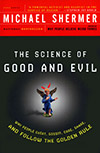 The Science of Good and Evil: Why People Cheat, Gossip, Care, Share, and Follow the Golden Rule
The Science of Good and Evil: Why People Cheat, Gossip, Care, Share, and Follow the Golden Rule
by Dr. Michael Shermer -
This book applies the latest findings of science to offer an original model of the bio-cultural evolution of morality and a new theory of provisional ethics that challenges the reader to confront these timeless issues from a new perspective — one that suggests that both morality and immorality evolved in human biological and cultural evolution, that we can make free moral choices in a determined universe, that moral principles can have a sound rational basis supported by empirical evidence (without being dogmatically absolutist or dependent on an external source of validation), and that we can be good without God. Shermer calls for a national debate on the origins of morality, the basis of moral principles, and the need for a more universal and tolerant ethic… This book is also available on Kindle and as an Apple iBook.
-
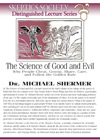 The Science of Good and Evil (lecture)
The Science of Good and Evil (lecture)
by Dr. Michael Shermer -
What are the origins of morality? What are the foundations of ethics? Is it human nature to be moral? If we live in a determined universe, then how can we make free moral choices? How evolutionary heritage and cultural history generated an ethical system.
-
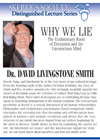 Why We Lie: The Evolutionary Roots of Deception and the Unconscious Mind
Why We Lie: The Evolutionary Roots of Deception and the Unconscious Mind
by Dr. David Livingstone Smith -
Deceit, lying, and falsehoods lie at the very heart of our cultural heritage. The ever-present possibility of deceit is a crucial dimension of all human relationships. Philosopher and evolutionary psychologist Smith elucidates the essential role that deception and self-deception have played in human—and animal—evolution and shows that the very structure of our minds has been shaped by the need to deceive. Smith shows that by examining the stories we tell and the unconscious signals we send, we can learn how our minds work.

